
- Disclosures


How to Visit North Korea’s DMZ Border (Updated 2023)
A s controversial a place as North Korea is, it's swiftly gaining attention from the curious tourist eye. Our intrigue to see it was piqued during a visit to Seoul with friends. Having now taken the DMZ tour ourselves, this highly informative if not haunting experience is one we would highly recommend . So, if you've got guts and a desire to get a snippet into one of the most closed countries on earth, here's how to do it!
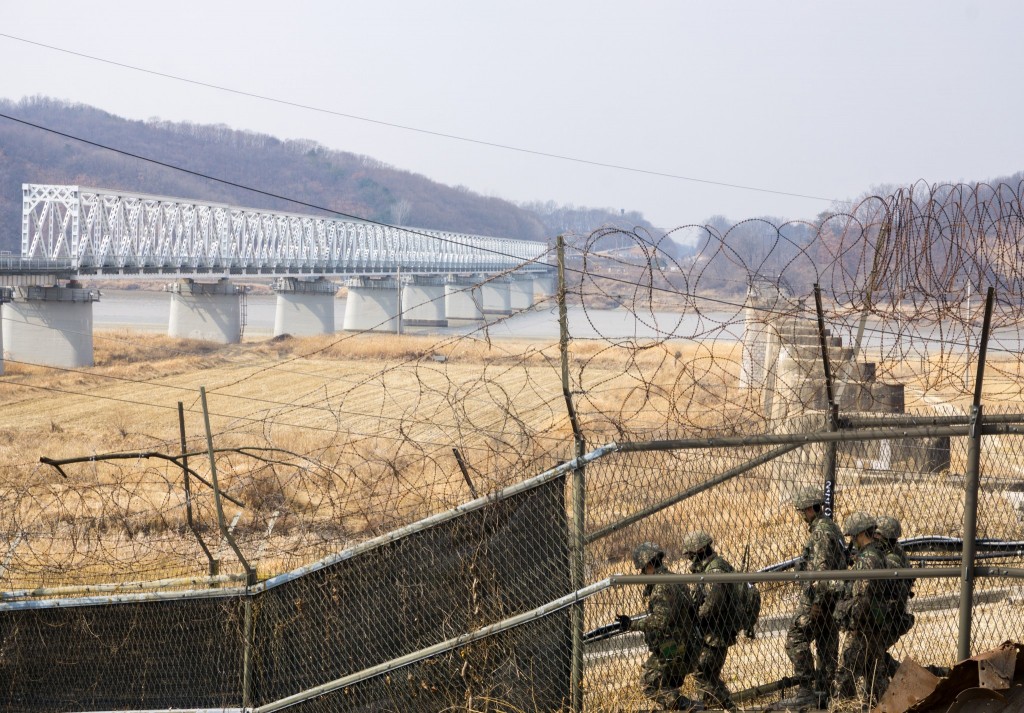
Getting there & where to stay
First, you need to get yourself to Seoul, which is the nearest major city to the DMZ border. South Korea is only reachable by flight, with most planes flying into Incheon International Airport. Use Skyscanner and search by entire month to see the cheapest dates to fly. Be sure to check our flight booking hacks here to get yourself the best price. And don't forget to book your airport transfer and a 4G Data SIM card before you land!
A fast way to get a big discount on your flight is to sign up for the Chase Sapphire Preferred credit card. This card offers a massive sign-up bonus of 60,000 bonus points (worth $750 ) after spending $4,000 in the first 3 months. United and Singapore Airlines are both partner airlines of this card, and both offer flights to Seoul, meaning you can convert your points to these airline loyalty programs, or just book directly through Chase Ultimate Rewards.
Seoul is a buzzing megacity with plenty of enticing accommodation options. There are plentiful AirBNBs and hotel selections, but be sure to reserve ahead in peak season. Some convenient neighbourhood options include Hongdae, Itaewon, Myeongdong, Gangnam, and Jamsil. Check TripAdvisor for more local tips and advice.
There is plenty to explore in Seoul itself, and a local guide can help ensure you catch the best of the best. Be sure to check out the Gyeongbok Palace & Temple , or grab the Seoul Pass , which grants free entry to 65 attractions and discounted entry to 101 more.
How to visit North Korea's DMZ Border:
Step 1. choose your points of interest.
There are several companies that operate DMZ tours. As much as I despise group tours, you can only visit the DMZ with a tour , as it has restricted civilian access and requires a mandatory military escort.
No two tours are the same, but you should choose one based on your budget, customer reviews, and points of interest that are included. Tours can be browsed with reviews, prices, and instant confirmation through Klook , GetYourGuide and Viator . The main highlights to select from are as follows:
The Joint Security Area (JSA)
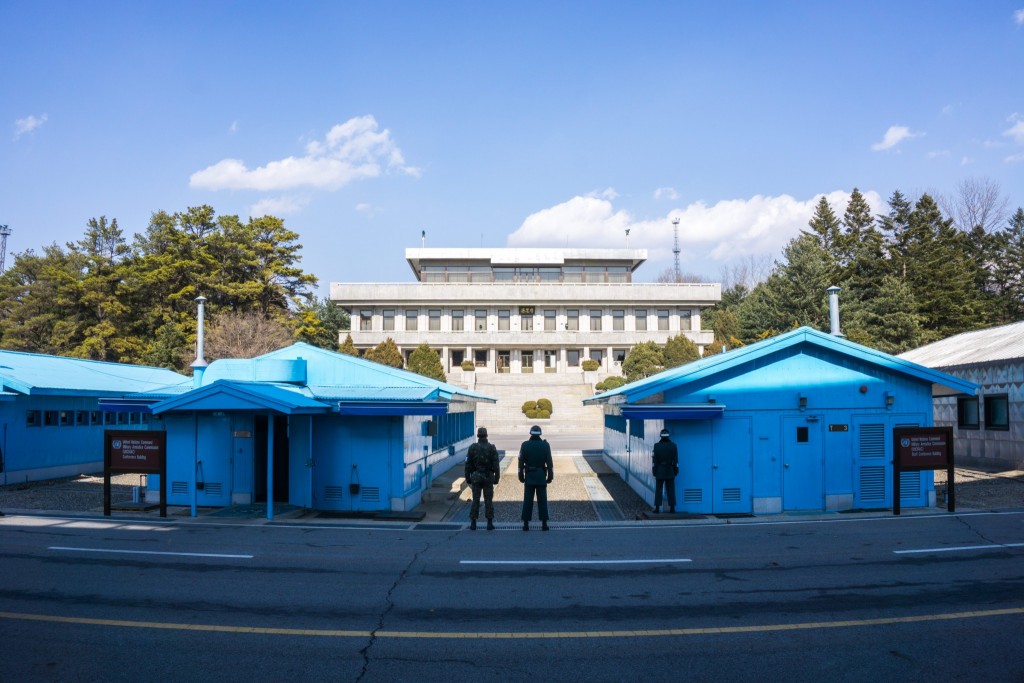
Located in Panmunjom, the JSA is the closest point a tourist can get to North Korea . At this spot, you'll have a chance to physically stand in North Korea itself and take a photo as proof (more on that below). This area is occupied by the South Korean and US military, and is complete with a gift shop selling original items from North Korea, including stamps, money, and wine (which in our experience tastes like nail polish remover and turpentine but hey, at least you can say you tried it).
NOTE: As of 2023, the JSA is still closed to visitors due to COVID, and is not included in any tours.
Odusan Unification Observatory
One can safely view day-to-day life in North Korea without setting foot in the country at Mt Odu Observatory. Binoculars (free of charge) provide ultra zoomed up views of North Korea opposite the Han river below. On our visit we were able to see civilians walking around on the other side.
Infiltration Tunnels
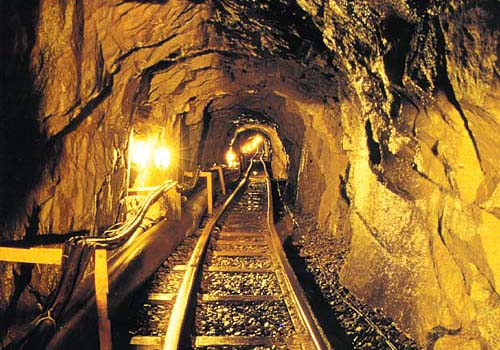
Scarily enough, around the time that the North and South were having peace talks, North Korea began digging underground tunnels to infiltrate the South. They were never completed, but were discovered in 1984. The longest tunnel is 1,082 metres. The 3rd tunnel is the closest to Seoul (only 44km away) and could move ~30,000 troops and artillery per hour.
Dora Observatory
This observatory offers binocular views of North Korea's fake town, Kijong-dong. The town was first built in the 1950's to lure South Koreans to defect and move across the border. From visual observations from the South, it has been uninhabited with windowless, incomplete buildings since its construction.
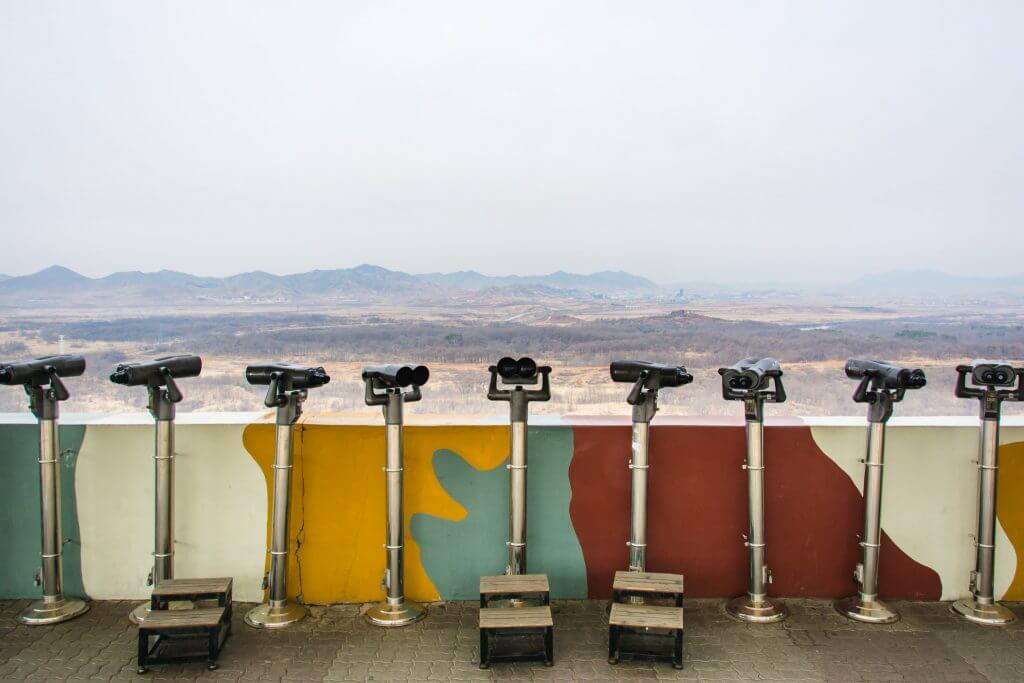
Dora Observatory is so named after Dorasan the mountain on which it sits. The nearest train station has a fully completed train line that runs to Pyongyang. Though the North cooperated in its completion, it was never used. It is hoped that when re-unification is reached, the train line will be used to connect the two Koreas.
Freedom Bridge
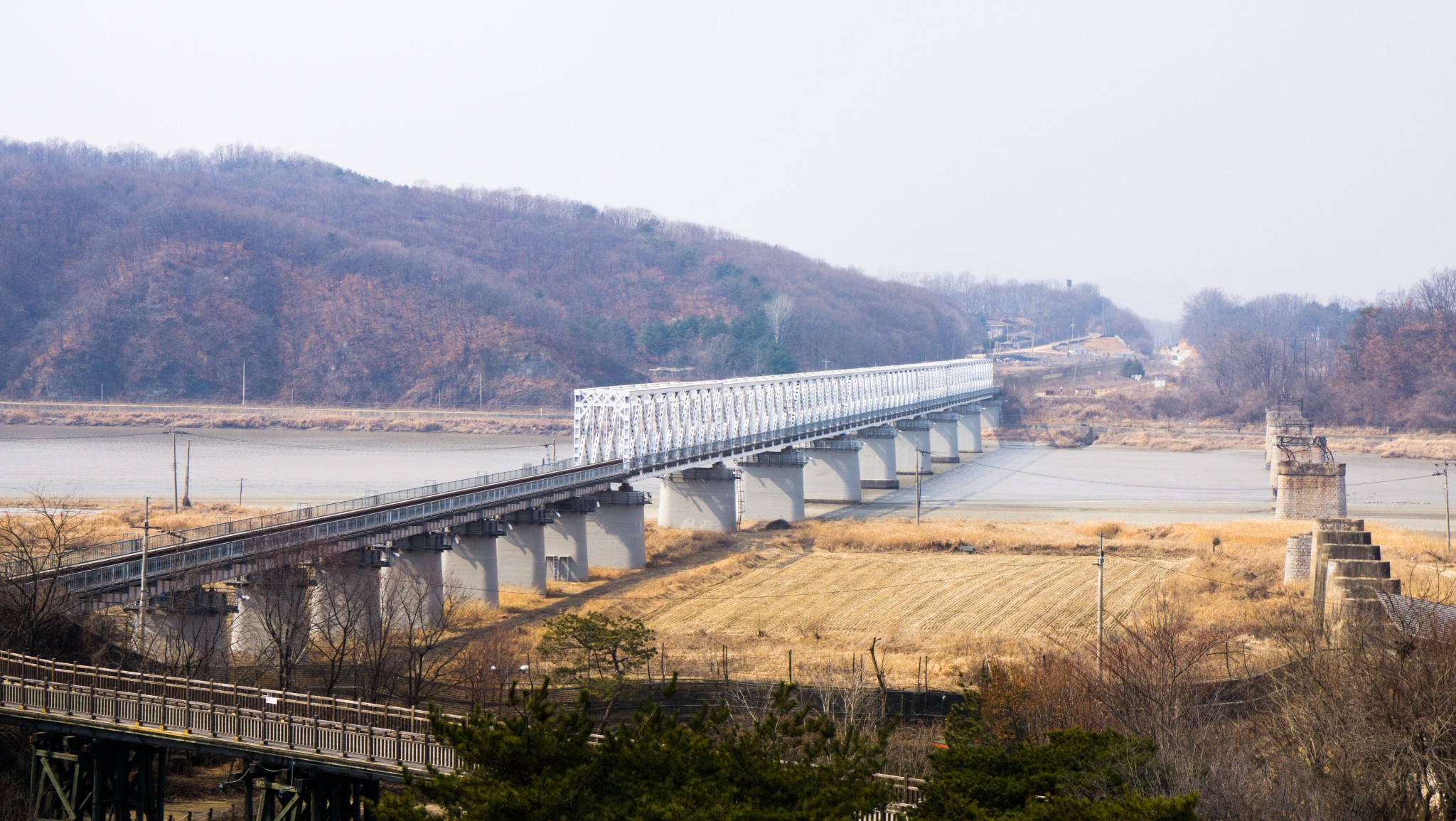
The Freedom Bridge connects North and South Korea, though a massive barricade blocks entry to the connecting point over the river. If the two sides are ever connected, this bridge could be used to enter and exit North Korea.
Step 2. Select a tour
Once you've decided on your must-see highlights (as listed above), you can select a tour.
There are traditional tour companies to choose from, which are listed at the end of this article along with prices and contact information, but it's much easier to book tours online with Klook , GetYourGuide and Viator . You pay in advance and get fast confirmation, so all you need to do is bring your voucher to the tour. There are reviews, photos, and videos that make choosing the right tour simple. The traditional companies require back and forth e-mail or phone communication when booking direct, so Klook , GetYourGuide and Viator are convenient ways to avoid all that hassle.
One of the most popular tours is this day tour on Klook , with more than 50,000 bookings. This is the tour most of our readers have chosen, and is the tour we would select today. Our trip was now several years ago, and at the time we took the Special Panmunjom Tour by Panmunjeom Travel Center which does not visit the tunnels but goes to Odu Observatory and the JSA. This tour offered the chance to speak with a North Korean refugee (defector). This allowed us to learn about how people escape the North, how they adapt to life afterwards, and what knowledge they have of the outside world living in North Korea.
Get $10 USD off your first Klook purchase with coupon code THRIFTY10 (minimum spend $120 USD, new users only)
Here are some of the top-rated tours that can be booked online:
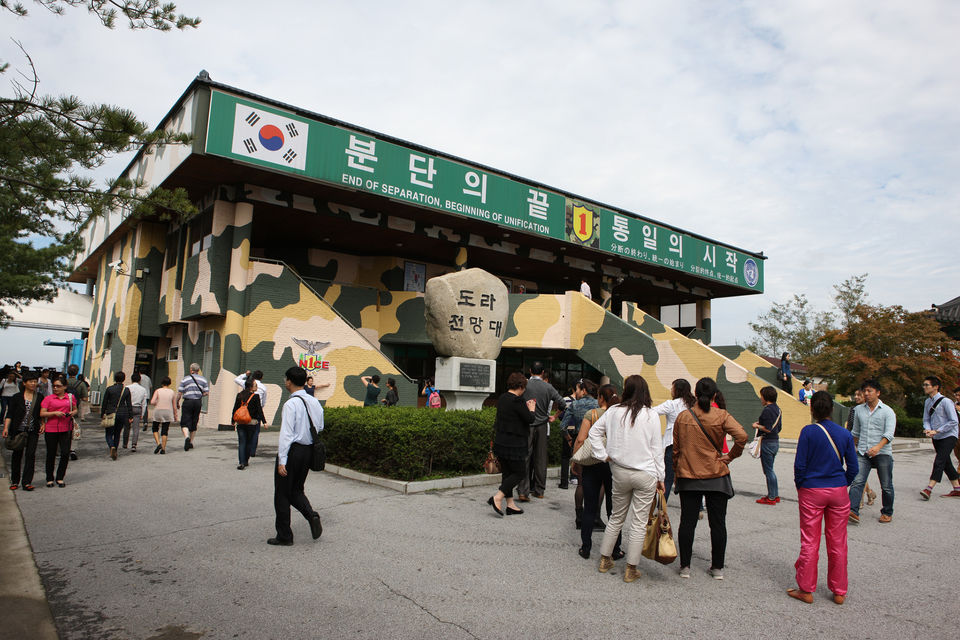
South Korea Demilitarized Zone Half-Day Tour (Bestseller)
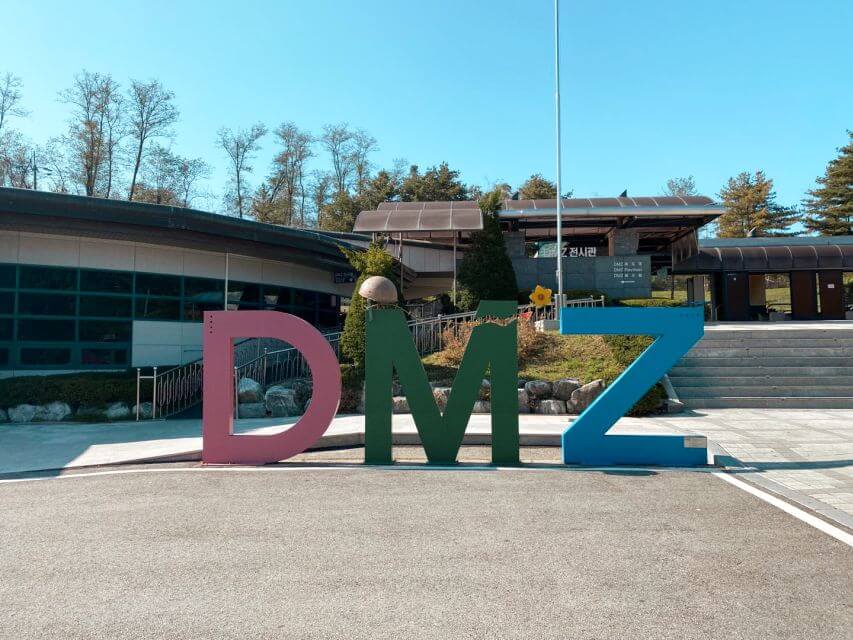
From Seoul: Half-Day Demilitarized Zone (DMZ) Tour
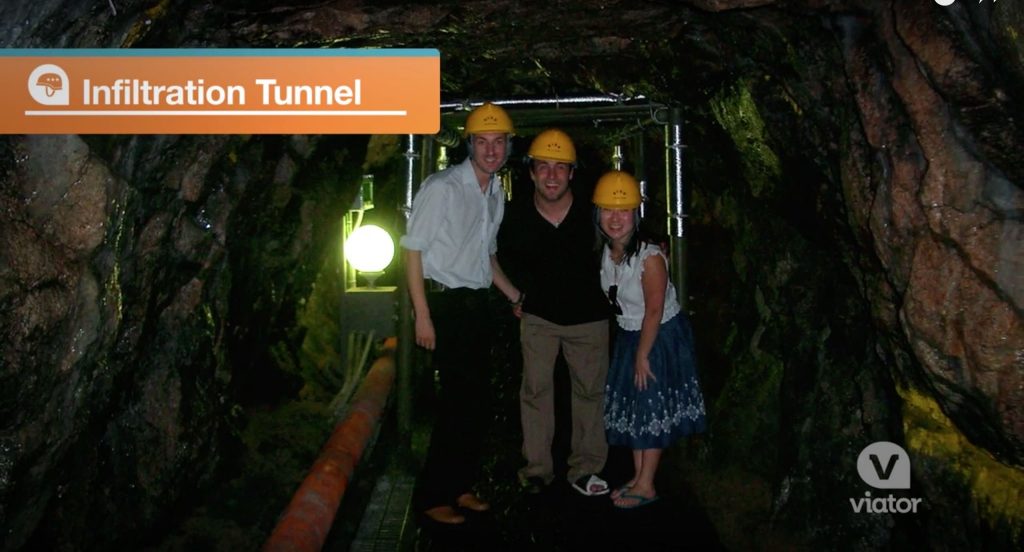
DMZ Past and Present: Korean Demilitarized Zone Tour from Seoul
Step 3. take ( lots of ) photos of north korea.
Much of the road towards the JSA border runs parallel to the Han River, which separates the two countries. It's nothing short of unique to be sitting in a bus with views of North Korea passing by out your window.
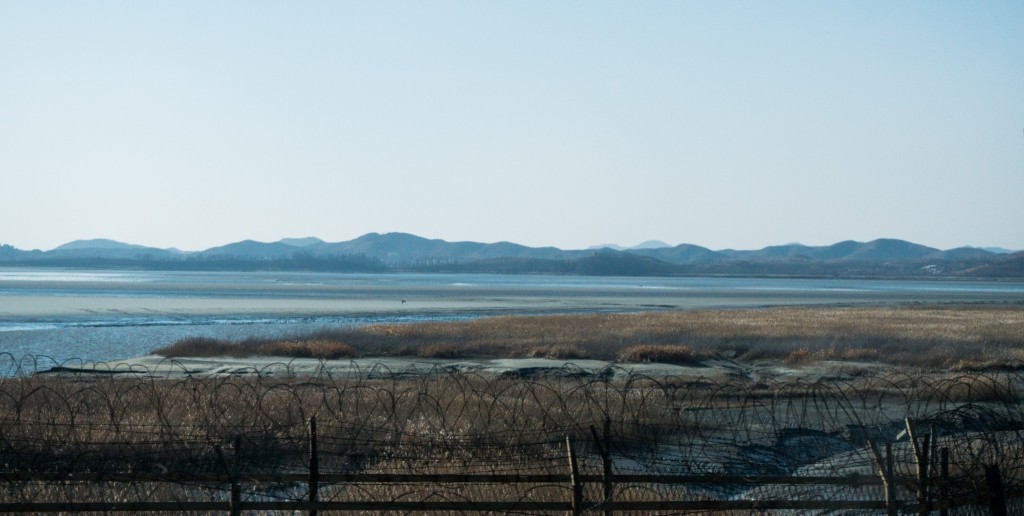
The binoculars at the Dora and Odu observatory provide ultra zoomed views of North Korea. One can even see North Korean civilians walking around on the other side, as we did during our visit at Odu . At Dora Observatory, North Korea's fake town, Kijong-dong, is viewed.
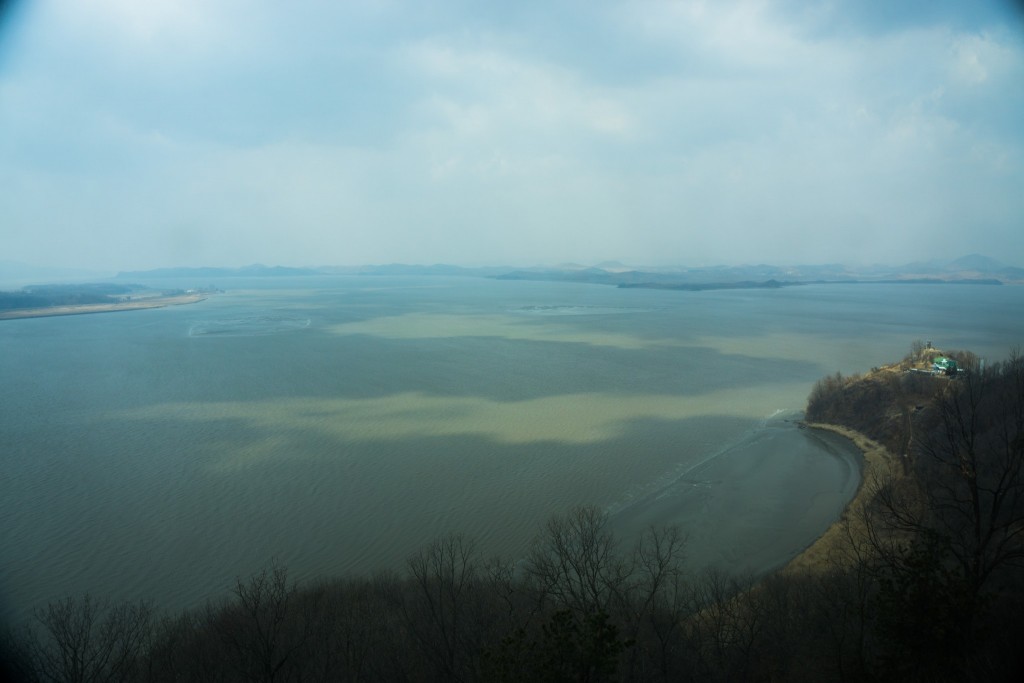
Step 4. Cross the border into North Korea
On a tension-free day at the JSA, one can legally take a step into North Korea. But how and why ?
The blue buildings pictured below are UN Command neutral zones. Midway, the inside of these blue buildings cross the North/South Korea border. Inside the building on the right (UNCMAC) is where meetings between the two countries are housed.
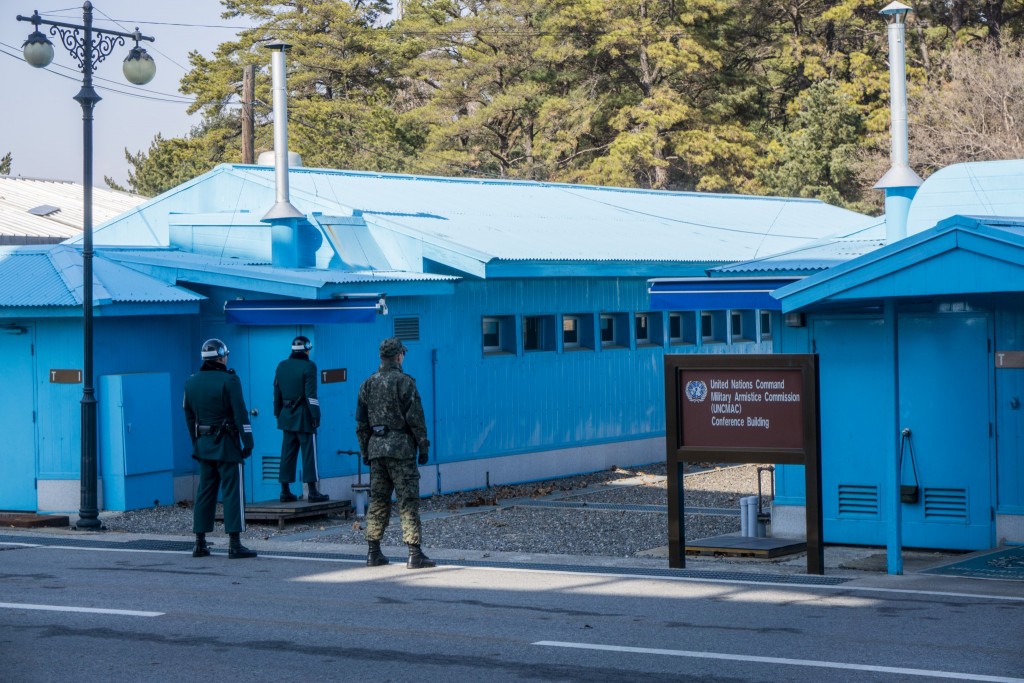
If you want photo evidence that you physically stood in North Korea, this can be done . You can pose with a South Korean soldier within North Korea at the back of the UNCMAC room. Be warned though (and you will be), if you cross through the door behind you, no one is responsible for your safety as you'll be alone and in North Korea.
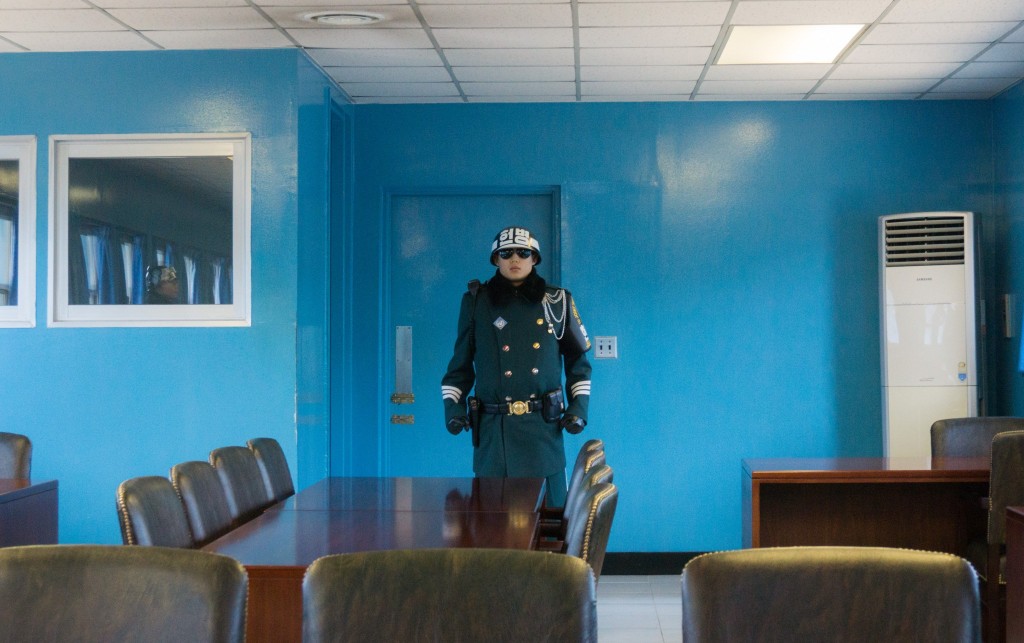
Important Points About DMZ Tours
- Many tours require reservation 2-5 days in advance , so check ahead.
- If visiting the JSA, you must sign a waiver agreeing that no one is responsible for accident, injury, or even death . Take comfort in the fact that these tours are done every day and you are accompanied by military escorts at the border!
- You must bring your passport for most tours , and it is checked by army personnel on arrival at the JSA.
- You must adhere to the specified dress code (e.g. no ripped jeans, sandals, or unkempt hair). These rules are strictly enforced as North Korean soldiers take photos and produce false propaganda that other countries are too poor to afford proper clothing.
- Tours can end unexpectedly at any time if tensions rise at the border . That means you are not be guaranteed to step into the UNCMAC at the JSA, nor is it certain you'll get a photo across the border.
In Summary…
Partaking in the DMZ tour allows yourself to gain much more depth on a humanitarian crisis that the world does not know enough about. If you have the chance to do this trip, I'd highly recommend it.
Tour Companies & Pricing
Alternatively, you can contact one of the tour companies below directly and book with them.
Panmunjeom Travel Center Website : www.panmunjomtour.com Telephone : +82-2-771-5593 (Korean, English, Japanese) Price : 80,000-77,000 won (~$60-$77 USD). All tours include lunch. Note : Tours offered in Korean, English, and Japanese. This is the only company that allows you to meet a North Korean defector/refugee, ask them questions, and better understand the human rights issues of North Korea.
VIP Travel Website: http://www.vviptravel.com/eng/ Telephone: 02-739-3501 ext. 4 Price: 55,000-135,000 won ($48 – $120 USD). Most tours include lunch. Notes: Tours offered in English, Japanese, Chinese. None of the tours include any forced shopping stops.
Koridoor Website : www.koridoor.co.kr Telephone : 02-6383-2570 ext. 2 Price : 43-89,000 won (~$41-$80 USD). Most tours include lunch. Notes : Tours offered in English.
JSA Tour Website : www.jsatour.com Telephone : +82-2-2266-3350 Price : 85,000-120,000 won (~$85-$120 USD). All tours include lunch. Notes : Tours offered in Korean, English, Japanese, and Chinese.
DMZ Spy Tour Website : www.dmzspytour.com Telephone : +82-10-3950-8350 Price: 88,000-114,000 won (~$88-$114 USD). Tours include lunch. Notes : Tours offered in Korean, English, Japanese, and Chinese.
International Culture Service Club Website : www.tourdmz.com Telephone : +82-2-755-0073 Price : 65,000-85,000 won (~$65-$85 USD). All tours include lunch. Notes : Tours offered in Korean, English and Japanese. This is the only company that does Saturday tours.
Seoul City Tour Website : www.seoulcitytour.net Telephone : +82-2-774-3345 Price: 40,000-125,000 won (~$40-$125 USD). Only some tours include lunch. Notes : Tours are offered in Korean, English, Japanese, and Chinese.
KTB Tour Website : www.go2korea.co.kr Telephone : +82-2-778-0150 Price : 65,000-130,000 won (~$65-$130 USD). All tours include lunch. Notes : Tours offered in Korean, English, Japanese, and Chinese.
DMZ & JSA Tour (Professional Guide Service / Celebrity's choice Agency) Website : www.cosmojin.com Telephone : +82-2-318-0345 (Korean, English, Japanese), +82-2-318-0425 (Chinese) Price : 46,000 won (~$46 USD) for half-day tour, 87,000 won (~$87 USD) for full day tour. Lunch included on full day tour. Notes : Tours offered in Korean, English, Japanese, Chinese.
Thrifty Nomads has partnered with CardRatings for our coverage of credit card products. Thrifty Nomads and CardRatings may receive a commission from card issuers. Opinions expressed here are author's alone. Responses are not provided or commissioned by the bank advertiser. Responses have not been reviewed, approved or otherwise endorsed by the bank advertiser. It is not the bank advertiser's responsibility to ensure all posts and/or questions are answered.
You guys are so brave! This makes me a bit nervous and I’m not sure I would be able to do it!
The link to the GetYourGuide tour you provided doesn’t work. Do you have an updated link by any chance? Thank you!
Leave a Reply Cancel reply
Your email address will not be published. Required fields are marked *
Disclosures Many of the listings that appear on this website are from companies which we receive compensation. This compensation may impact how and where products appear on this site (including, for example, the order in which they appear). The site does not review or include all companies or all available products. Thrifty Nomads has partnered with CardRatings for our coverage of credit card products. Thrifty Nomads and CardRatings may receive a commission from card issuers. Opinions, reviews, analyses & recommendations are the author’s alone, and have not been reviewed, endorsed or approved by any of these entities.
Living and traveling in Korea

A Complete Guide For How To Visit The DMZ From Seoul
Not only was I featured on CNN for sharing some hidden gems in the DMZ, but I’ve been there multiple times over my more than 15 years living in Korea. If you want to visit the DMZ or take a DMZ tour, or maybe you’re wondering how to visit JSA, then you’ve come to the right spot for all of the information you’ll need to plan the trek. I say trek, but it’s actually easier than you might think.
The DMZ in Korea can be closed for any number of political reasons so you’ll want to know everything you can about where you can and can’t go if the actual entrances in are blocked to tourists. Even when they are, there are areas you CAN visit to still get a peak north… Ready to learn more? Let’s figure out how to get to the DMZ from Seoul and more.
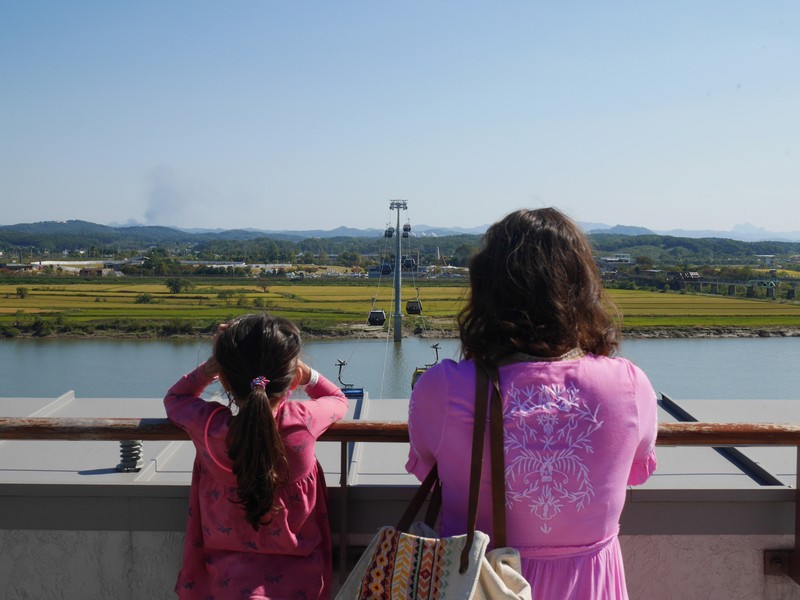
What you need to know to plan a trip to the DMZ in Korea:
What Is The DMZ?
Where is the dmz, what you need to know about visiting the dmz, what’s the difference between the dmz and jsa, tours to the dmz, the bridge of freedom (자유의다리), peace park (임진각평화누리), dmz gondola (파주디엠지곤돌라), camp greaves (캠프그리브스), third tunnel (제3땅굴), dora observatory (도라전망대), dorasan station (도라산역), the joint security area (jsa), odusan unification observatory (오두산 통일전망대).
- Things to know about heading to the Cheorwon DMZ area
North Korean Labor Party Building (노동당사)
Woljeong-ri station (월정리역), cheorwan peace observatory (철원평화전망대), second underground tunnel (제2땅굴), cheorwon plains (migratory bird habitat) (철원평야(철새도래지)).
(This post contains affiliate links, which means I receive a certain percentage of a sale if you purchase after clicking at no cost to you. Thank you for your support.)

DMZ stands for demilitarized zone and is the area between North Korea and South Korea. This buffer zone or no-man’s land exists because of the Korean War, which technically never ended though there are always discussions on peace. Measuring four kilometers in width and 250 kilometers long, the DMZ was put in place in 1953 when the Armistice Agreement was signed.
The DMZ runs the entire northern border of South Korea so while there are more popular areas of the DMZ where tourists visit, there are more areas than just one spot to find the DMZ. Below, I’ll share points along the DMZ where you can visit starting with the easiest and most popular and going from there. I’ve also made a note where you can visit that’s really really close even when you can’t get inside the DMZ. When tours are closed, fear not, there are still some really cool spots to check out to see what you can see and learn what you can learn.

- You MUST Be On A Tour: You can get pretty darn close to the DMZ without being on a tour, and I’m going to tell you how, but you CANNOT enter the DMZ unless you’re actually on a tour with an official tour company with a registered guide. This is the info that you’ll find most places. There are parts of the Civilian Control Zone that you can enter though even without a tour too.
- You MUST Have An ID/Passport: You’ll need to show your ARC (local Alien Registration Card)/passport in order to enter the DMZ. If you’re a resident, you should be fine with your ARC, I’ve used mine on two separate tours, BUT to be safe, take your passport. Every major tour company will tell you you must have your passport for a tour, so take it or they probably won’t let you on their bus. I went with two companies that said my ARC was fine though. Just my experience.
- Be Aware Of Your Clothes: There is sort of a dress code for visiting the DMZ though I’ve just gone casual and never had issue. BUT, they do recommend that you don’t wear sandals, especially if you’ll be going down into the tunnels. You also shouldn’t wear ripped jeans or clothing as they say that North Korea may take photos of the tourists watching them and use it as false propaganda.
- Be Mindful Of Movements: When looking out into North Korea from any vantage point, you’ll be instructed not to wave, point, or make signals toward North Korea. Just assume that you’re being watched.

You might be surprised on your tour if you sign up to see the DMZ and then don’t see the blue buildings that are often portrayed on the news when talking about North and South Korea. DMZ, as mentioned above, refers to the demilitarized zone but JSA is specifically the Joint Security Area which is as close as you can get to North Korea.
While most people want to visit the JSA when they’re talking about the DMZ, it’s usually the area that is often closed to tourists. While it is though, you can often visit other parts of the DMZ and that’s one reason I’m writing this. A lot of people think when the JSA is closed, they can’t visit the DMZ. They are a bit different though and tours may still run to other parts of the DMZ. So keep that in mind.

While there are areas that you can visit on your own around Imjingak and other civilian control points, a tour is the best way to really learn and get an education on the DMZ from the past and today. There are quite a few tours that even have North Korean defectors as the guide so there is a lot you can learn.
Note Age Restrictions: It’s important to note that not all tour companies allow children below the age of 10 on tours to the JSA. If you’re planning a trip to the DMZ/JSA, make sure to check with the tour company if you plan on taking small children. Children must be accompanied by a parent at all times.
Tours You Can Take:
- Tour Length: 6.5 hours long. Starts at 8:00am and ends at 2:30pm
- Reasons To Book: Easy to book and cancel if necessary on Klook. Free cancellation with 48 hours notice. English speaking guides.
- Tour Length: Ranges from 6 hours to 9 hours depending on which tour you book.
- Reasong To Book: Free cancellation, English speaking guides.
- DMZ Tour with the Joint Security Area (JSA): Currently the JSA isn’t open to tourists. When it is, I’ll update this tour option.
Timing: Most tours require a 2-5 day advance reservation, so plan accordingly.
The Most Popular DMZ Area: Imjingak Resort (임진각관간지)
The most popular area to visit the DMZ for visitors/tourists in Seoul usually includes a stop at Imjingak Park, Freedom Bridge, Dorasan Station, Dora Observatory, and the Third Tunnel. What a lot of people want to see when they go to the DMZ , but often can’t due to restrictions, another tour up to/through the Imjingak area visits the Joint Security Area (JSA), Odusan Unification Observatory, the Third Tunnel, and Dora Observatory.
Called a resort, but don’t expect a hotel with a swimming pool or anything. Picture a giant parking lot with various things to see and do that surround it. You can actually visit the Imjingak area on your own and there’s a lot to do there. If you want to go further in, you’ll need a guide, BUT, here’s what you can do at Imjingak and then how to go further in from there if you want to plan your own trip.
What You Can See

The bridge that is both a symbol of and named for freedom is where prisoners were exchanged after the war. The bridge is blocked off now and the fence leading to it is covered in hopeful prayer ribbons. There is an old rusted train that is on display here as well that is riddled with bullets from the war and, if you look out for it, you’ll spot an entrance to an underground exhibition area here too. Koreans with family in the north often come to this point to pray, especially around big Korean holidays, so remember to be respectful and quiet when you’re in this area.
- Address: 1400-6 Majeong-ri, Munsan-eub, Paju-si, Gyeonggi-do (경기 파주시 문산읍 마정리 1400-6)
- Note: You do not need a tour to visit this.
Peace Park sits in the Imjingak Resort area and is basically a large grassy expanse that can accommodate up to 20,000 people. There are various art installations that are meant to depict peace between the north and the south. When you visit, make sure to take a walk up and through the field and see what installations are on display. Some of them change throughout the year. Walk up and over the hillside and you’ll find a cafe to stop into. The cafe in the pond is always busier though.
- Address: 148-40 Imjingak-ro, Munsan-eub, Paju-si, Gyeonggi-do (경기 파주시 문산읍 임진각로 148-40)
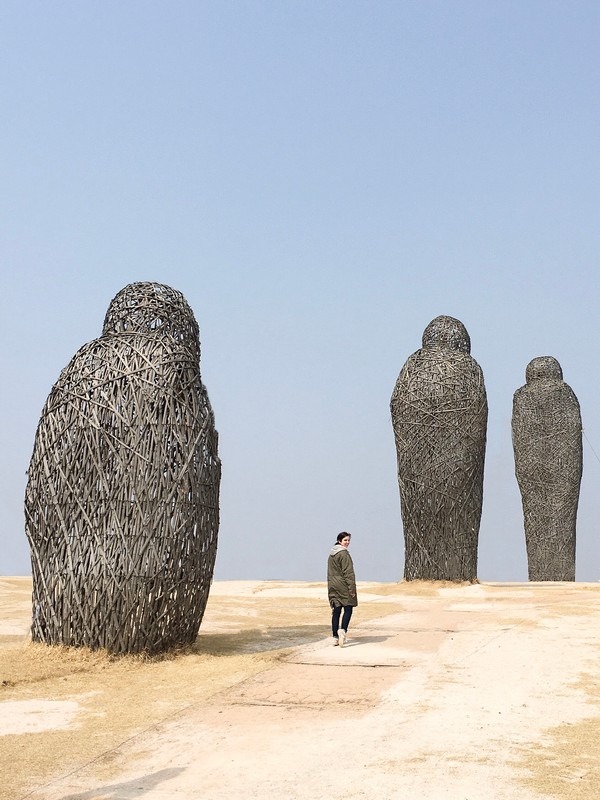
One of the newest additions to the Imjingak Resort area is the DMZ Gondola. To take the ride, you’ll need to show your ID/Passport and then once to the other side, you can visit Camp Greaves, previously an American installation in the DMZ. Check out more below. This is a fun ride if you have the time and want to enter the civilian control zone in the easiest way there is.
- Address: 148-73 Imjingak-ro, Munsan-eub, Paju-si, Gyeonggi-do (경기 파주시 문산읍 임진각로 148-73)
- Hours: Weekdays: 10:00am ~ 6:00pm; Weekends: 9:00am ~ 6:00pm
- Admission: W7,000 ~ W14,000 (Price depends on whether you choose the glass bottom or the regular.)

When I first visited Camp Greaves, the only way to get there was to take a bus over a bridge where our passports were checked but since the gondola was built, now that’s how you get to this former American military installation in the DMZ. Today, Camp Greaves is an art, culture, and history complex inside of the Paju Civilian Control Zone. This is a really interesting place to learn more about the DMZ as the artistic exhibitions are promoting peace and display references to history. This is a unique look at the DMZ as you’re in the Civilian Control Zone and on a former American installation. Learn more about Camp Greaves in my full post here .
Discovered in 1978, the 1635 meter long tunnel was made by North Korea though they denied it at first. This is one of four tunnels that have been dug by North Korea and found. To enter, you’ll get a locker to place your belongings in and then be given a helmet to don because the tunnel is narrow and low.
The tunnel is steep! Be prepared to huff and puff. To be honest, I don’t think the tunnel is any more interesting than other tunnels in Korea… or anywhere, except that the story and information behind it is.
- Note: You do need a tour to visit this.

Either before or after the station, visitors are taken up to the Dora Observatory which sits at the top of Dorasan Mountain. Take a look out into North Korea. You can see Kijong-dong Propaganda Village from the viewpoint and on really clear days, you’d be able to spot Kaesong, a special industrial area where both North Koreans and South Koreans can work side by side.
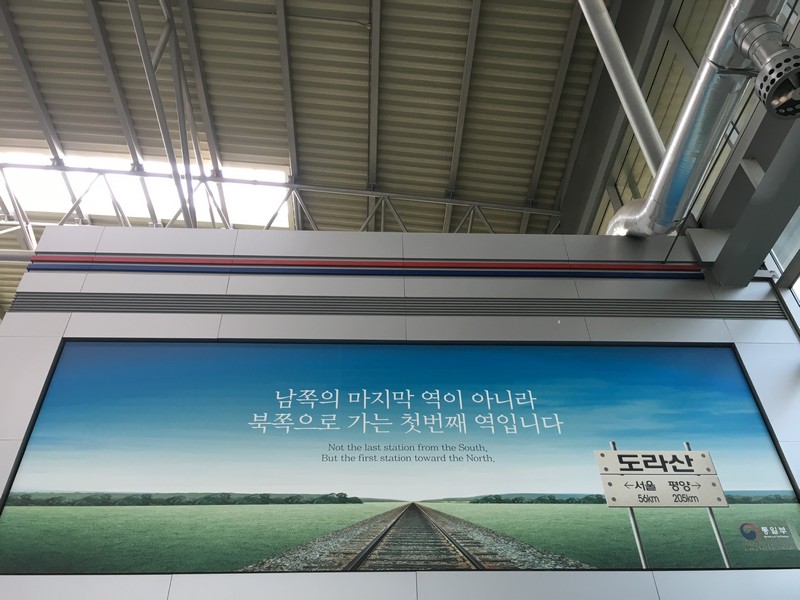
Often the final destination on tours is Dorasan Station. This is the last train station before the border and is a symbol of the peaceful future. The idea is that some day, when there is peace, this train line will continue north and south and families can re-unite. Visitors can get a fake ticket to Pyeongyang and even have it stamped.
- Address: 307 Huimang-ro, Jeongdan-myeon, Paju-si, Gyeonggi-do (경기 파주시 장단면 희망로 307)
- Tour schedule: Depart from Yongsan Station (10:08) – Seoul Station (10:15) – Arrive at Imjingang Station (11:24) – Complete identity check (11:32) – Arrive at Dorasan Station and board connecting bus (11:43) – Dorasan Peace Park (12:10) – Lunch break at Tongilchon (Unification Village) (13:00) – Dora Observatory (14:00) – The 3rd Tunnel (14:40) – Tour Unification Platform (15:50) – Depart from Dorasan Station (16:27) – Seoul Station (17:47) – Arrive at Yongsan Station (17:54)
- Train Tickets: Adults: W36,000; Children: W33,000
- For More Information

The closest point a tourist can get to North Korea. One of those spots that everyone wants to see in person, the JSA tour may or may not be opened and it depends on the political tensions at the time. If restrictions are heightened, then you’ll likely be able to go to the stops above, but not this one. If you can see it though, this is the blue building spot that you see in the news and will recognize easily.
Generally for tours to this area, visitors first visit Camp Bonifas, a United Nations command post that houses the United Nations Command Security Battalion whose mission is to monitor and enforce the Korean Armistice Agreement. You’ll see the Unification Bridge, Freedom House, Demarcation Line, MAC Building, and Bridge of No Return.
An observatory on Odusan mountain, use the binoculars to get a closer look into North Korea. The observatories are all relatively the same. Head up to the top, look through the binoculars and see what you can catch a glimpse of.
- Address: 369 Pilseung-ro, Paju-si, Gyeonggi-do (경기도 파주시 탄현면 필승로 369)
A Hidden Natural DMZ Gem: Cheorwon
Most tourists and even long term residents and travelers will head to the Imjingak DMZ area, but there’s another DMZ tour area just northwest of Seoul in Cheorwon.
Cheorwon is special because it’s more natural and untouched so a lot of visitors, and specifically birdwatchers, will go to see the yearly migrations of cranes and other birds that stop here while simultaneously taking a tour of the DMZ. Cheorwon is a special area with some major sites from war to see, but also a ton of natural wonder.

When I first went for a tour, tours started from the Cheorwon Facilities Management Office formerly Iron Triangle Tourist Office (철원 시설물관리사업소 (구 철의삼각전적관)). Now, it looks like you can search the Tourist Information Center or 철원 DMZ 형화관광안내센터 and that’s where you’ll start. Surprise, the two places I just mentioned are the same spot but there’s been some changes there.
Anyway, visitors must stop here to get on a tour. If you take your own car, a guide may jump into your car, or you’ll be asked to join a caravan behind another car that has the guide. If you don’t have a car, you’ll need to get a taxi that can also enter the DMZ.
- Address: 1825 Taebong-ro, Cheorwon-gun, Gangwon-do (강원도 철원군 동송읍 태봉로 1823)
Things to know about heading to the Cheorwon DMZ area:
- Reservation in advance is not allowed. You must get to the DMZ Peace Tourist Information Center on time. If you miss the time to enter with the guide, you will not be permitted to enter. Make sure you plan how you’re getting there to a T.
- Note that registration for a tour closes 15 minutes prior to the times listed above so you can’t rock up AT 10:00am or 2:00pm and jump on a tour. You need time to fill in forms.
- On-site registration is first-come first-serve basis.
- The tour takes approximately 2 and a half hours.
- You must carry your ID to enter.
- Check the local Cheorwon Tourism website for updates and seasonal adjustments to times.

The building was built in 1946 and used until the armistice in 1953 by the party. North Korea controlled this area for five years as it falls above the 38 th parallel but during the Korean War this area came under the control of South Korea and UN forces and when the armistice was signed was still under the control of the South. The bullet holes and loss of the ceiling of the building are blunt reminders of the violence this area saw and though there was once a vibrant and large city here, now there are just rice paddies and checkpoints.

The building is just the shell of what it once was, a stop on the Seoul-Gangwon line, but sitting in the back is an old North Korean transport train, bombed by American forces. Woljeong-ri Station is the last stop before reaching the DMZ and is the spot where the fiercest battle was held during the Korean War.
- Address: 1882 Durumi-ro, Cheorwon-gun, Gangwon-do (강원도 철원군 철원읍 두루미로 1882 (철원읍))
From here, you’ll be able to take in the views out of the DMZ. There is a monorail here that will take you up so it’s easier to get to and you can use the binoculars to catch a glimpse of what you can see on the other side of the DMZ.
- Address: 588-14 Junggang-ri, Cheorwon-gun, Gangwon-do (강원도 철원군 동송읍 중강리 588-14)

Discovered on March 19th, 1975, a soldier heard an explosion beneath the ground and there it was. The tunnel is 3.5 kilometers long and is 50-160 meters deep. Don a hard hat and descend into the wet and dark tunnel.
If you are interested in birdwatching and you’re in Korea , well you probably already know, maybe this is for the people that don’t, the Cheorwon Plains sees 30% of the world’s wild crane population during migration season. And that’s just the cranes. There are 110 species of birds that migrate through Cheorwon and use the calm surroundings as a natural habitat to feast when they stop through. To view the amazing bird scenery, you’ll want to visit Cheorwon between the beginning of January and the end of February.
You’d still start from the same place as mentioned above, but the tours are a bit different with this one being on the tour focused on migratory birds. Tours also stop at Togyo Reservoir, Sapseulbong Peak, and Saemtong.
The DMZ isn’t just one place. It seems that a lot of tourists don’t realize that. There’s more places to go than you might realize. And there are plenty of things you can do on your own pretty close to the civilian control zone as well.
Did you like this post? Pin IT!

You May Also Like
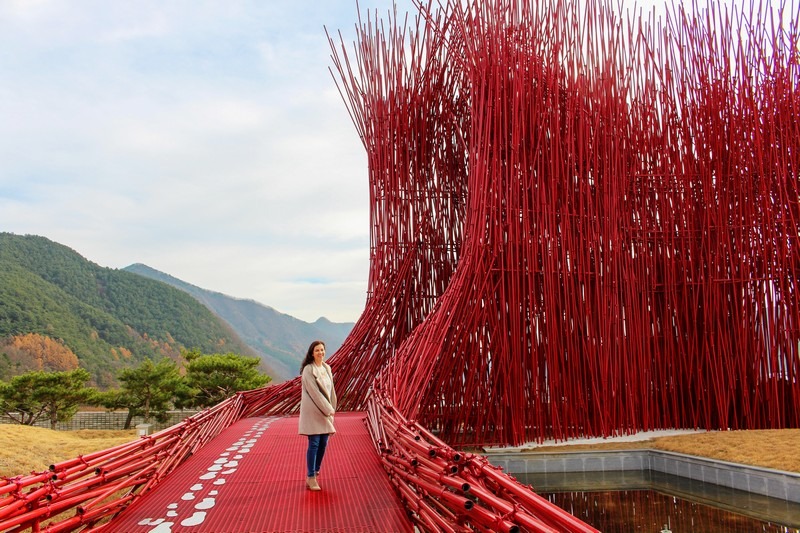
Youngwol Y Park: An Epic Art Museum In The Middle Of Nowhere In Korea

Donghae Mureung Health Forest: Heat Therapy & A Sauna In Gangwon-do
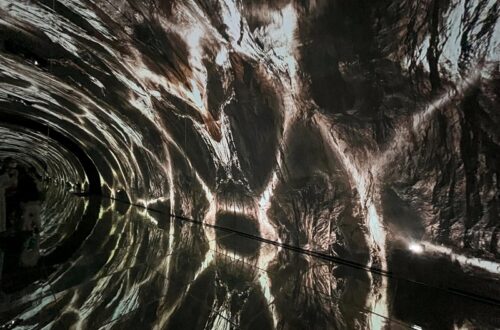
Arte Museum: The Immersive Exhibition To Find In Korea
30 comments, ken carlson.
My wife and I will be coming to Korea early June 2024, and will visit for roughly 2 months. I am actually looking for a phone number to call in Korea for tours to get a much more deeper idea and understanding what would be the best for us to do, our heart is to have a deeper understanding of North Korea and to see as much as we possibly could. If you could provide any phone numbers that we can call so that we can talk or detail of different tours or options of again visiting spots close to the North Korea side That are safe of course. Thank you.
I’m here now and was looking for Dmz options that were more unique than the regular tour, this is the best collection of information that I came across. Thank you. I can’t wait to go there tomorrow
Hallie Bradley
I appreciate that Robert and hope you had a good day out.
Thanks for the information and there’s so much to take in. I’m visiting in Oct 2024 and really want to see the JSA. Are there any tour agencies that only do the JSA tours or does it have to be with the DMZ? I’m physically unfit so I won’t have the ability to do the tunnels. Would appreciate any advise. Thank you.
Thank you Hallie, for such a wonderful post. I have been looking for these details and stumbled upon your page. I did a DMZ-JSA tour back in 2017 with a tour, but in Jan 2024 I am planning to go to DMZ with my family. Since my dad and my 3-year-old nephew are joining, we plan to drive on our own, as based on my experience with the 3rd tunnel, it is not convenient for my dad – but all the tours seem to include the 3rd tunnel.
My dad really wishes to see the north border, so we plan to at least visit the Dora Observatory, the Bridge of Freedom, and if possible the DMZ Gondola. If you don’t mind, I have a few questions, if it is possible for you to answer. 1. If we were to drive on our own, are there any travel restrictions for foreign visitors i.e. military checkpoints etc. If so, will passports be sufficient or are there any special passes required?
2. Are the Dora Observatory, DMZ Gondola, and Bridge of Freedom accessible from the same parking facilities, or do we have to drive from one point to another? Or do we park the car at the Imjingak Pyeonghwa-Nuri Park and get to all these attraction from there? I am a bit concerned with this as it seems that the Dora Observaotry does not show on KakaoMap navigation, and I could only pin to Imjingak Pyeonghwa-Nuri Park.
3. Any idea if we could also visit the Dorasan Station without a tour? Since we will drive on our own as the DMZ train is still not operating (I checked with Korail last week). Can we drive there to the station?
Hi, so you can’t go into the DMZ or through any checkpoints on your own at all. You can go tot he Imjingak/Pyeonghwa Nuri Park area on your own. From here, you can take the cable car over the Camp Greaves on your own as it’s in the Civilian Control Zone (showing your passport when you get tickets for the gondola), you can see the Bridge of Freedom here as well, all without moving your vehicle. But, you can’t go any further on your own. You need to have a certified guide to go to Dora Station, Third Tunnel, etc. For the 3rd Tunnel just so you know, you ride a monorail so if it’s the walking up and down you’re worried about, your dad can sit or just not take the ride down into the tunnel.
Thanks for your prompt reply! Do you know if the Dora Observatory is also accessible without a guide or is that considered as DMZ, and restricted? In the Paju website, it is stated that we can buy a DMZ tour ticket at ticket booth. So, if the Dora Observatory requires the DMZ tour, I guess that is the ticket that we can buy at the booth without following a tour from Seoul. Have you perhaps tried this?
Is the JSA open? Do they allow electric scooter to be used for a disabled person? Thanks
JSA hasn’t been open for awhile. Other parts of the DMZ are open though if you enter with a certified guide. You can use the sites listed above to book a tour with a guide.
Not sure how updated your info is but I’m in Seoul station on Oct 1st, 2023 and according to the information desk here there haven’t been any DMZ train since 2019! The only way to get there aside from a tour is to take the subway to Musan station and transfer with a shuttle bus to Imjingang then find a tour company there
Yeah, a lot of things stopped due to Covid and Korea only stopped requiring masks in February of this year so has taken awhile to get everything back up and started again. Hopefully that comes back in full force again. But yes, you can get up to Imjigang pretty easily. From there you can take a tour further in, or take the cable car to Camp Greaves just across the river there. Quite a few options to see the civilian control zone.
Thanks for sharing the information! May I check if it’s possible to drive there on our own, pls?
What are you trying to drive to? Which area? You can’t just drive into the DMZ.
Any idea if the JSA tours are open for tourists? Am trying to go on my own if possible! Such a wonderful site thank you!
Hi, firstly, thank you for sharing these details and also help set expectations for newbies like myself. My family and i plan to do this tour (likely with klook) but i’d like to ask for another piece of advise. I am told that booking with klook etc only gets you to the DMZ area but does not gurantee you a ticket in. These tickets must be purchased only when you are there… Thus, these “tours” asks that you are ready to rock and go to the DMZ area like at 5am but see if you are lucky to get tickets in? Another friend said they were there are 5am, tickets to enter were only available for 10am. I am sorry i do not yet know where they are trying to get into but i’d ask anyway hoping that you could help with some advise on such a situation? thanks!
I worked with a tour guide recently who was taking a group out and he said that they only let a certain number of buses in per day and thus tour groups are heading out earlier and earlier to ensure they can get their groups in as promised which means that you probably will have to leave super early if you want to be sure you’ll get in. If your group leaves later, you will probably see Imjingak and other sites nearby, but maybe not the tunnel.
Joe Patterson
Definitely not. Current political affairs are not stable enough to allow JSA access. If you are going to the DMZ to learn more about the Korean political relations then you don’t need the JSA. The tours provided will explain what you need to know.
By the way, we took the advice on this blog in October 2022 and were successful in taking a KORAIL train to Munsan. Then in Munsan we had to get off and wait 15-30 minutes. Along came a local train at the same platform. That train took us to Imjingang two or so stops later. Then we walked about 1/4 mile and we’re able to get on a tour bus and gondola ride. We paid about 10% of the cost that tour groups were charging from Seoul.
It’s now July 2023 and we’re on the train doing the same travel again. It’s Sunday so we’re hoping that we don’t have troubles with tour availability. I can provide an update later today. Good luck with your travels!
Hi Joe, thank you for yr inputs. Hallie’s too!
Joe, is it possible for you to update your July 23 trip to DMZ. I am looking into going on our own instead of joining a tour in Seoul, I cam’t imagine going early to wait those few hours!
Really appreciate it very much!
This is a wonderful overview, thank you so much! I have visited the DMZ in 2015, but will come back end of March with a friend again. I was thinking of taking the train from Yongsan station. Do I understand correctly that there will be a bus waiting for the tour to Dora Observatory etc. – and will there be additional costs for the bus ride? The bus will return in time so that we can take the train back to Seoul?
Right. If the train is running, then the bus and the tour there is all set up since you can’t just go wandering on your own in that area.
Thea Angelie Manila
Hi, firstly thank you so much for this post. I was so confused as I did the tour in 2015 but then see a lot of different things when I search for a tour these days. Now I don’t know what to do as it’s a 5am start.🙈 we have the KORAIL PASS and it says DMZ train is included so would probably like to do the train-bus combo instead of startingbthe tour in seould and wait for 5 hours. However, I tried multiple times and couldn’t book on the korail website. Should we just head to the yo gsan station and book it there?
Did you check the KORAIL site? https://www.letskorail.com/ebizbf/EbizBfAboutDmz_Train.do There’s a schedule and booking button there. There’s also a phone number for the KORAIL travel center which could help you as well.
Thanks for the helpful guide! You mentioned some places that needed tours and some places that do not need tours.
If I were to drive to DMZ, would there be a tour that we can take upon arriving at the DMZ? So that we can spend half day on tour (visiting places requiring tours) and the other half day without tour (visiting places not requiring tour)?
Yes, so it depends which area you’re headed to. But if you’re going to the Paju area, you’d head to Imjingak where you can do some things on your own, but you’ll also see an area where you can join in tours. If you go to Cheorwon, similarly, you’ll go to the office I mentioned above where you can join in for the areas that require a guide and then do other spots on your own.
Wow! This is just a detailed and latest read! Very helpful. Been to Korea for ten times already, but haven’t visited the DMZ areas as I thought those were only accessible via organized tours (and read a lot of stories of organized tours being cancelled without prior notice due to military activites). But the wanderlust in me wants to see it in my next travel, hence landing in your write up. I think of doing the DIY since it can give me the flexibility on trip dates. Thank you for this!
Yes, there are a lot of places that are very close and, like I said, even some now that you can go right into on your own and people don’t realize it. I hope you have a great adventure!
We are staying in Seoul at the moment. Can you let us know a good adress where we can book at tour to the DMZ. Thanks.
Regarding Odusan Unification Observatory, I have read some other sites that say there is no tour required to enter the observatory and that you can take a shuttle to it that runs every thirty minutes and pay an entry fee. Have you heard of that option?
This was very helpful! I live in Daegu and I’m planning my first DMZ trip. Do you reccomend an area to stay in Seoul that’s near where tour groups meet/pick up? I’ll have to take the KTX the night before and stay overnight in Seoul for a morning tour. Thanks!
It depends which company you’re going with. But a lot of them pick up downtown so staying near Seoul Station probably wouldn’t be a bad idea. If you wanted to head out to Imjingak on your own, you could stay in Hapjeong and get a bus from there or catch the DMZ train from Seoul Station in the morning. Definitely some options.
Leave a Reply Cancel reply
Your email address will not be published. Required fields are marked *
Sign me up for the weekly updates newsletter!
This site uses Akismet to reduce spam. Learn how your comment data is processed .

- Accomodation
- Attractions
- Food & Drink
- K-Entertainment Tours
- Korean Culture
- Shopping Destinations
- Transportation
- Travel Essentials
- Travel Tips
- Travel News in Korea
- Gyeonggi-do
- North Gyeongsang (Gyeongsangbuk-do)
- North Jeolla (Jeollabuk-do)
- South Chungcheong (Chungcheongnam-do)
- South Gyeongsang (Gyeongsangnam-do)
- South Jeolla (Jeollanam-do)

A Complete Guide to DMZ Tour: Learn Everything About This Military Divider

12,150 total views, 7 views today

Have you ever desired to know what it’s like living in North Korea? You may get a sneak peek into North Korea with the DMZ Tour. With 7.9 million visitors each year, the DMZ area is one of the world’s most heavily militarized regions yet serves as a valuable insight into North Korea and Korean War history.
Table of Contents
What is the DMZ Tour?
The DMZ Tour is a tour of the Demilitarized Zone that separated North and South Korea after the Korean War in 1953. The DMZ is a four-kilometer-wide strip of land that runs across the Korean Peninsula. It is located about 60 kilometers north of Seoul, South Korea.
The DMZ Tour is a great way to learn about Korean history and the current situation on the Korean Peninsula. It’s also worth noting that this region protects precious natural and historical sites due to its isolation and lack of people.
Things to See on the DMZ Tour
Imjingak park.
The Imjingak Park memorial complex serves as a powerful reminder of the sacrifice made by those who died in defense of South Korea. The park, which honours families separated by the division of North and South Korea, is significant both emotionally and symbolically. The park symbolizes the hope for one day unity. More than 400 exhibits about North Korea are on display in the park. Furthermore, families from North Korea migrate to the Mangbaedan Alter at the park’s Nonsan Park to perform rituals on vacation.
View this post on Instagram A post shared by 김은경 (@eksksskdu)
The Third Tunnel
In 1978, the Third Tunnel was discovered, one of four tunnels that link North Korea and South Korea beneath the DMZ. It is also known as the Third Aggression Tunnel, could transport 30,000 soldiers per hour. The tunnel was used to invade the South. This tunnel reflects the struggle between North and South going on for years.
View this post on Instagram A post shared by Gold and Win. You describe it. (@goldwin818)
Nuri Peace Park
The Nuri Peace Park is a beautiful, serene park located in the DMZ. The park commemorates the Korean War and has a statue of two doves symbolizing peace. It is also notable for its lush greenery, which is unusual for the area.
View this post on Instagram A post shared by Laren NL (@thegeneralofgeneral)
Mangdaebbang Alter
The Mangdaebbang is located in the front yard of Imjingak. This altar has a special significance for defected North Koreans. The Mangdeok Garden Altar is a place of great cultural significance for the homeless, who may mourn their relatives, friends, and loved ones who were killed during the war or by separation. Every year or Chuseok (Korean Thanksgiving or Mid-Autumn Festival), North Koreans come and bow their heads to their nation in homage to their deceased relatives.
View this post on Instagram A post shared by Francescka (@silhouette1010)
The Bridge of Freedom
The Bridge of Freedom is prominently displayed in front of the Mangdaebbang Altar. This little bridge should not be confused with its more famous counterpart, which spans the Imjin River and is one of Korea’s major bridges. The popular Bridge of Freedom, which is a smaller replica of the larger one, is an excellent spot to visit. South Koreans attach brightly colored ribbons to this bridge in memory and remembrance of the deceased. The Bridge of Freedom, which connects North and South Korea, is a stirring destination for both people from the north and south. The Bridge of Freedom is a moving location for both North Koreans and South Koreans because returning to one’s birthplace is important in Korean culture.
View this post on Instagram A post shared by Artur Chorążka (@artur.chorazka)
Dora Observatory
The Dora Observatory is a stop on the DMZ tour for visitors who want to get a closer look at North Korea. The observatory, which offers great views of the country, was built to give South Koreans an idea about what their northern neighbours were up to. The observatory also has binoculars that allow tourists to see into the North Korean town of Dorasan.
View this post on Instagram A post shared by Frances Palomeno (@ancestarr)
What to Know Before Visiting the DMZ?
The DMZ is an eerie, yet fascinating place to visit. If you’re interested in learning more about the Korean War, a trip to the DMZ is highly recommended. However, there are a few things that you should keep in mind before embarking on this adventure:
What should you bring with you?
You must always carry your passport with you. Because most DMZ sites demand formal identification before admittance, if your passport is needed, you must be able to show it. Other forms of identification, such as an identity card or an ARC – Application Registration Card, are strongly encouraged to go with you during your trip to the DMZ.
What to watch out for?
Since the Korean War, there have been numerous landmines and unexploded ordnance (UXO) cases in the DMZ. For your safety, it is important to be aware of where you are walking at all times and to heed all warning signs. In addition, please do not touch any objects that look suspicious – they may very well be UXO.
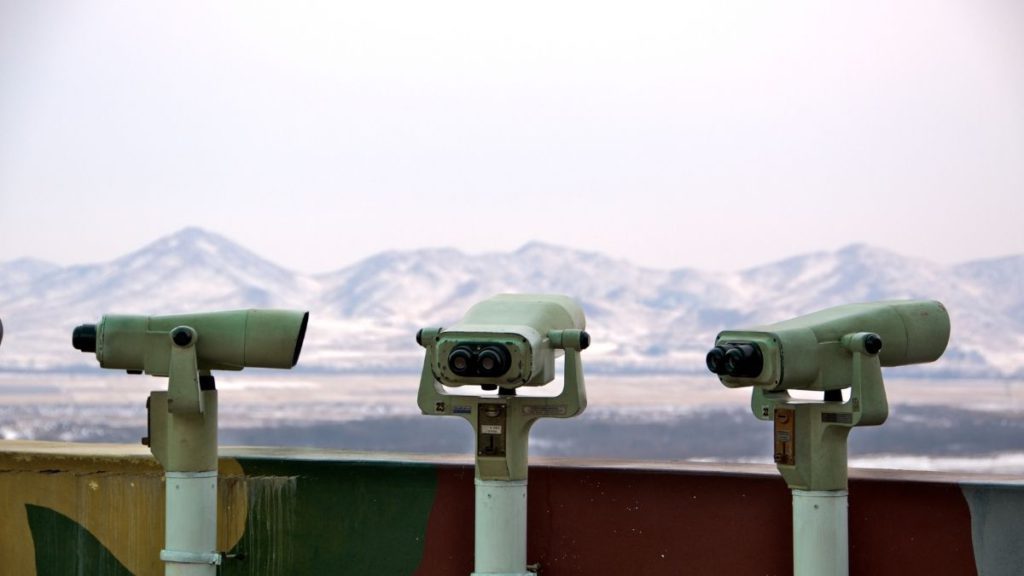
What to wear?
Appropriate attire is also important for a DMZ tour. Although there are no strict dress code requirements, you should avoid wearing anything that could be construed as offensive or provocative. In addition, because the weather in Korea can be quite hot and humid, it is advisable to dress comfortably and in layers.
Photography
Taking pictures is allowed in most areas of the DMZ, except the Joint Security Area (JSA). However, it is important to remember that photography is not allowed inside any military installation.
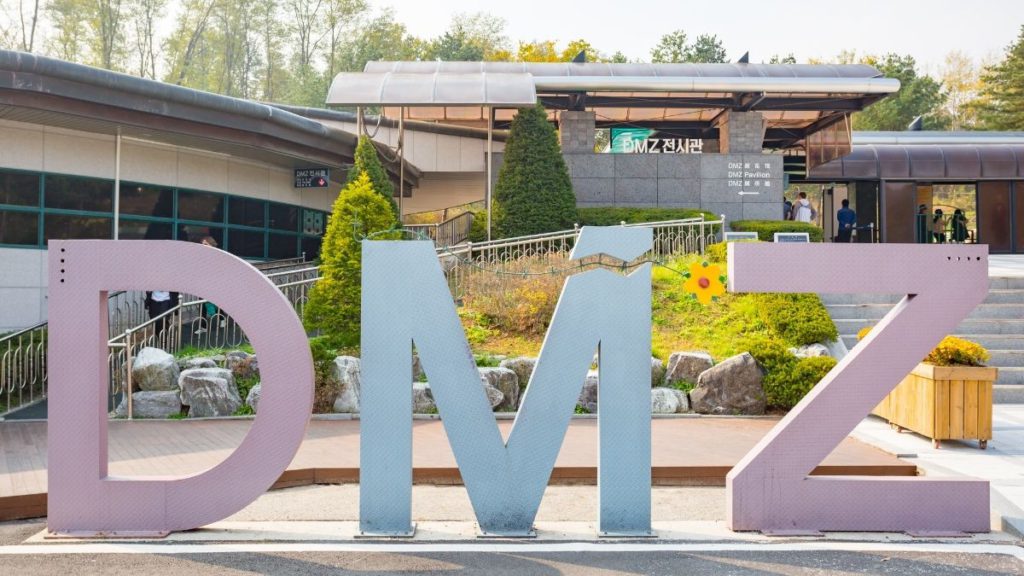
Food and Drinks
Outside food and drinks are not permitted in any of the DMZ’s tourist sites. There are restaurants located near each of the DMZ’s tourist sites, so you will not go hungry. In addition, there are also a few souvenir shops where you can buy snacks and drinks.
The DMZ is a unique and interesting place to visit. It is full of history and offers visitors a glimpse into the lives of North Koreans. However, it is important to remember that the DMZ is still a military zone and some certain rules and regulations must be followed. By following these guidelines, you will have a safe and enjoyable visit to the DMZ.
KoreaTravelPost Editor
Hello there! I'm the Features Editor for KoreaTravelPost.
Related Posts
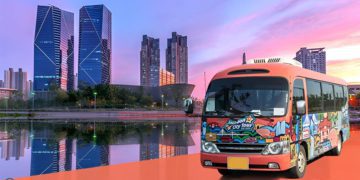
Discover the Vibrant Heart of Incheon: A NEW City Tour Adventure Awaits!
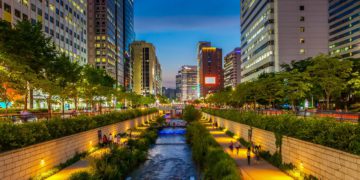
3 Most Romantic Destinations in Seoul
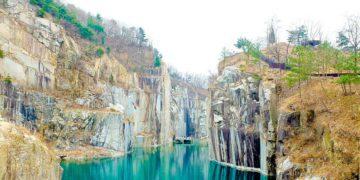
Planning A Day Trip to Pocheon from Seoul
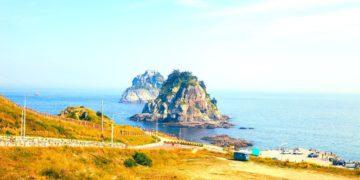
8 Korean Islands For Day Trips Near Seoul and Incheon Port That Aren’t Jeju or Nami

A Guide to Incheon’s Wolmido Island: A Hidden Gem in Korea
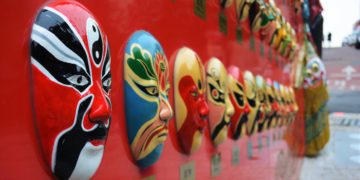
Incheon Chinatown: All You Need To Know

A Guide to Incheon's Wolmido Island: A Hidden Gem in Korea

TESSAN Germany France Travel Power Adapter

Lonely Planet Korea 12

Korean Snack Box Variety Pack

OSULLOC Lovely Tea Gift Box Set
More from our network.

- Medical Tourism

FREE NEWSLETTER
Copyright © 2024 About Us| Terms of Use |Privacy Policy| Cookie Policy| Contact : [email protected]
Login to your account below
Fill the forms bellow to register
Retrieve your password
Please enter your username or email address to reset your password.
The 5 Best DMZ Tours From Seoul [2024 Reviews]
It’s no secret that Seoul has become one of the hottest travel destinations in recent years, from the explosion of K-POP to the centuries-old temples and rich history. Of course, just like everywhere else in the world, South Korea also has its fair share of tourist traps.
One thing’s for sure, though, you won’t regret taking a DMZ tour! This journey into the heart of Asian history takes you to the edge of two very different worlds, with palpable tension and stories forever etched into the landscape.
Whether you’re a history buff or would simply like to explore the “path less traveled”, you’re going to be fascinated by these top tours of the DMZ from Seoul! Let’s jump right in!
Best DMZ Tours From Seoul
Quick answer: the 5 best rated dmz tours from seoul for 2024.
- Private DMZ the 3rd Tunnel Tour from Seoul (No Forced Shopping)
- DMZ Full day with Suspension Bridge Tour
- From Seoul: DMZ, 3rd Tunnel & Suspension Bridge Guided Tour
- Best DMZ 3rd Infiltration Tunnel Tour from Seoul (No Shopping)
- Free Style Private Tour(Seoul/DMZ)
DMZ Tour Reviews
1. private dmz the 3rd tunnel tour from seoul (no forced shopping).
- Duration: 8 hours
- Departure: Hotel pickup and drop-off available
- Departure Time: 7:30, 8:30, 9:30 AM
- Includes: Professional English-speaking guide, transportation, all taxes & fees
Let’s start things off on the right foot with one of the most unique tours one can take in South Korea!
The Private DMZ the 3rd Tunnel Tour from Seoul will lead you through this incredibly important historical site with an expert guide who will provide you with cultural context throughout your time with them.
If you have a full day available and would like to see the country in a different perspective, look no further than this excursion. The Korean Demilitarized Zone, more commonly-known as “the DMZ”, is the most heavily-fortified border on the planet.
It’s definitely not all fun and games, but this “real deal” experience will get you as close as possible to experiencing the tension, mysteries, and stories that have unfolded between these two divided nations.
Around 4km wide, this modern-day “No Man’s Land” doesn’t allow any military personnel, activities, and much less, civilians. The only exception to this rule is a place called the “Joint Security Area”, which is a neutral ground where soldiers from both sides come together for talks and negotiation.
Expand To See More See Less
One of the highlights of the tour was climbing the heights of the Dora Observatory, complete with high-powered binoculars for you to see the North’s propaganda village.
When the weather is clear, you may even be able to see the bronze statue of Kim Il-sung, casting a watchful eye over the divide.
Then, you’ll get to see the Third Tunnel subterranean passage discovered in the 1970s and stretching nearly 2,000 meters long. This secret conduit screams espionage and conspiracy, with North Korea having built it then denying it.
Oh boy, there are a ton of interesting stories surrounding it and your guide will fill you in on some of the most captivating.
Tour Information & Booking
100% refund for cancellations within 24 hours of tour experience, 2. dmz full day with suspension bridge tour.
- Duration: 9 hours
- Departure Time: 7:00 AM
- Includes: Full-day tour of the DMZ and suspension bridge, professional guide, all fees and taxes
Next up, we have a full-day tour that will take you for an immersive experience through some of the most iconic locations around South Korea.
The DMZ Full Day with Suspension Bridge Tour is full of thrills, intrigue, and incredible views to the unknown. With a guide to share historical accounts and plenty of personal stories with each location visit, you’re sure to view the country from a different viewpoint!
Starting off at 7:00 am, you’ll be picked up right from your hotel by your professional guide in a climate-controlled coach with plenty of legroom and big windows.
Upon arrival to Imjingak Park, you’ll get to see the Freedom Bridge and old steam trains, which was pretty cool by itself. The guide was there to teach us about the Korean War and the sacrifices that needed to be made, which only enriched the experience.
While I enjoyed the entire tour, the most memorable part for me was seeing the Gloucestershire Regiment “Gloster Hill”, which commemorates the actions of the regiment and C Troop, 17th Mortar Battery, Royal Artillery of the British Army during the Battle of the Imjin River.
Nearby is the incredible rope bridge known as the “Gloucester Heroes Bridge” which was a bloody battle field during the Korean War. Today, it stands as the longest suspension bridge in the country, sitting over 700 meters above sea level!
Finally, you’ll get to see the DMZ exhibition hall and learn about the old weapons, which was pretty cool! Next, make the walk over to the Third Tunnel which was made by North Korea, who actually claimed the South had constructed it with the intention of a guerilla attack!
The Dora Observatory was crazy to see, showing you a peek into North Korea’s propaganda village with the high-powered telescopes.
3. From Seoul: DMZ, 3rd Tunnel & Suspension Bridge Guided Tour
- Departure: 65-6 Chungmuro 2(i)-ga, Jung-gu, Seoul
- Departure Time: 7:00 AM
- Includes: Licensed professional guide, roundtrip transfer from Seoul, admission fees to DMZ, monotrail tour in 3rd tunnel or walking tour for shared tour option
This next tour is one of my favorites, seamlessly combining incredible nature views with the rich and varied history of South Korea. If you consider yourself an adventurous person who enjoys those “more unique” tourist sites, this one’s for you!
The DMZ, 3rd Tunnel & Suspension Bridge Guided Tour is one of the only ways you can actually see a glimpse of North Korea in person, offering a deep dive into the history of the area.
First things first, though: you’ll have to pick either the private or the shared tour option. For the private tour, you’ll travel with only your party and go on a monorail tour in the Third Tunnel.
For the shared tour option, you’ll obviously be traveling with strangers and will instead go on a walking tour in the Third Tunnel – either way, they’re great options!
After being picked up from your hotel, you’ll arrive and get to see the Freedom Bridge, Mangbaedan Altar, as well as an old steam locomotive that was destroyed during the Korean War.
Your guide will be there to tell you all about how the Korean War affected the country and landscape – particularly on the border. You’ll then visit 4 different locations at the DMZ, starting with the Third Infiltration Tunnel.
Whether you’re walking or monorailing in, you’re sure to get a bit of a creepy vibe as you enter this “lair”. After, check out the Dorasan Observatory, which allows you to see into North Korea from their superpowered binoculars!
You can also choose to explore some Unification Villages located in a buffer zone and is civilian controlled by the government. Then take a hike around 15 to 20 minutes and appreciate the Gamaksan Suspension Bridge, which has quite the intense history of its own.
If time allows, you’ll even get to see the Majang Suspension Bridge located right at a glass-like lake perfect for taking some photos.
4. Best DMZ 3rd Infiltration Tunnel Tour from Seoul (No Shopping)
- Duration: 7.5 hours
- Departure Time: Varies
- Includes: Professional English-speaking guide, all taxes and fees
You know what’s really annoying when you’re on a trip and trying to maximize your time by seeing as many interesting things as possible?
When your tour guide “forces” you and your group to go shopping at specific stores and markets. There’s none of that nonsense with this next tour – the Best DMZ 3rd Infiltration Tunnel Tour from Seoul is all about learning in a fun and interesting way!
This is another one of my top recommendations if you’re looking to escape the hustle and bustle of Seoul. You’ll get picked up in the morning by your guide and make the trip on a comfortable, air-conditioned coach with plenty of unobstructed views along the way.
Right from the get-go, I did notice that our guide did a fantastic job at providing detail and easy-to-digest historical accounts and personal anecdotes which made it that much more fascinating.
Upon arrival, you’ll get to see the Imjingak Pyeonghoa-Nuri park and learn about how it was constructed to house the refugees who left North Korea during the Korean War.
After that, check out the Bridge of Freedom which was also made to free almost 13,000 prisoners during the war. It’s not only incredibly moving to learn about, it’s set in one of the most beautiful natural settings ideal for photo ops!
After that, it’s time to head to the DMZ Theater where you’ll watch a short film about the war, and the South Korean perspective on it. You’ll learn how the DMZ came to be what it is today, as well as get time to walk through the creepy Third Infiltration Tunnel.
It definitely gives you a deeper understanding of just how serious this situation is, and the photos and artifacts only help.
5. Free Style Private Tour(Seoul/DMZ)
- Duration: 7 to 8 hours
- Includes: Air-conditioned vehicle, private transportation, English-speaking guide
One thing that many people may be turned off about tours, is that you’re obligated to go on one set schedule. The great thing, is that many tours offer the option of creating a custom itinerary designed around your specific interests!
The Free Style Private Tour (Seoul/DMZ) is one of my favorites, catering to your tastes to ensure you’ll see the things you’re most captivated by!
If you’re a history buff, or really into Korean culture or food, you can tell your guide and they’ll create a personalized agenda just for that. While the tours will never be exactly the same, there are plenty of options to choose from.
Start off with your guide picking you right up from your hotel in a private, air-conditioned vehicle made to transport only you and the rest of your party.
As you do get to choose, it’s quite possibly the best way to maximize your time in Korea – especially if it’s your first time there and/or you are there for only a couple of days.
While it’s not necessary, I definitely recommend going to the Gyungbokgung Palace, which is the most popular of the 5 in total in the city. You can then head up by car to the top of the mountain peak, whick offers some of the most breathtaking views of Seoul possible.
After that, head to a local eatery for a delicious, traditionally Korean lunch which has been reviewed by some of the top publications in the world. Follow it up with a trip up to the N-Seoul Tower by cable car, or head over to the DMZ, of course!
The DMZ, as you already know by now, is a must-see and is the one way to really gain insight into the tension between these two neighboring nations.
FAQs About the Korean DMZ
Q: what is the dmz in korea.
A: The DMZ or Demilitarized Zone, is a strip of land the is about 2.5 miles wide the runs across the Korean Peninsula near the 38th parallel north. It’s a buffer between North and South Korea, that are still technically at war because the war ended with an armistice and not a peace agreement.
Q: Do I have to take a tour to visit the DMZ?
A: Yes, you can only go to the DMZ on a guided tour. You can book them online or through travel agencies. You can take a half-day, full-day, or private tours, that show you different sites and activities in the DMZ. The most popular attraction is the Joint Security Area (JSA) which is where negotiations took place. The Third Tunnel of Aggression, was dug by North Korea to infiltrate South Korea and the Dora Observatory where you can see North Korea with a telescope.
Q: Is it safe to visit the DMZ?
A: You may be wondering if it’s safe to visit the DMZ. While the Korean DMZ is considered “the world’s most dangerous border”, there is no danger to visitors. Just make sure you follow the rules and instructions of the tour guides.
Tour Guides
The Private DMZ the 3rd Tunnel Tour from Seoul is our Editors Choice for the best DMZ tour from Seoul.
Richard Remick
Related articles, the 5 best taj majal tours from new delhi [2024 reviews], the 5 best halong bay cruises [2024 reviews], ▷ the 5 best hanoi city tours [2024 reviews], ▷ the 5 best mekong delta & cu chi tunnels tours [2024 reviews].
- Work with me
- Privacy policy

- Years in review
- United Kingdom
- Bosnia & Herzegovina
- North Macedonia
- Philippines
- South Korea
- South Africa
- Central America
- South America
- Solo Travel
- Budget travel
- Travel tips
- Travel itineraries
- Hidden gems
- Bucket list
- Travel resources
- Digital nomadism
- Blogging tips
- Start a travel blog
Taking A Korea DMZ Tour From Seoul – What To Expect + Tips
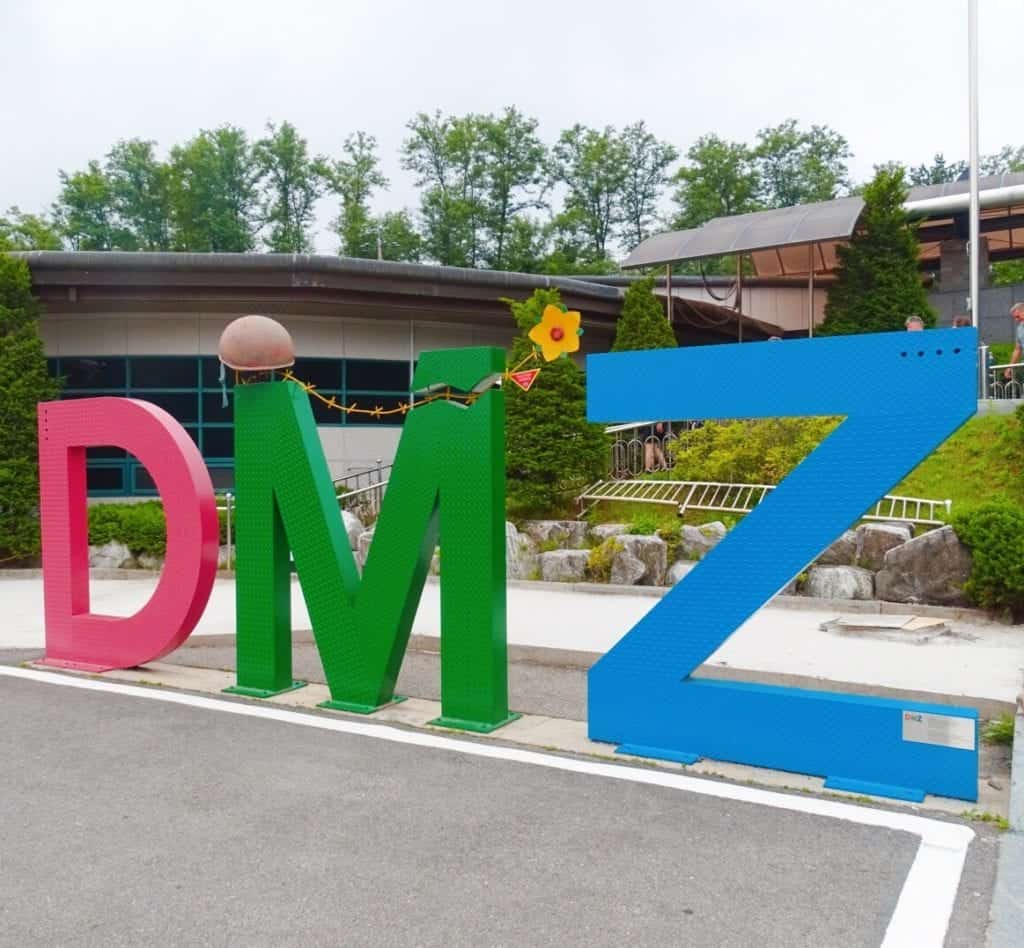
Table of Contents
This post may contain affiliate links to things like tours, hotels, Amazon associates and products. These help me earn a small commission at no additional charge to you.
Taking a DMZ tour from Seoul was high on my South Korea bucket list . I’d wanted to visit for years, ever since I’d first learnt about the unique and tragic situation in North Korea. I was happy to learn that tourists can visit the DMZ… So that’s what I did! There was so much I still didn’t know: how had North and South Korea split? How had the DMZ buffer come to exist? Was there any chance of unity between the countries? In this blog, I’ll answer these questions and share my Korea tips for taking a Seoul to the DMZ day tour.
SEOUL ESSENTIALS Accommodation: Booking.com / Hostelworld Activities: Viator / GetYourGuide Getting there: air ( Skyscanner ) / Train ( Trip.com ) / bus Getting around: Subway, bus, taxi Pre-book private airport to hotel transfer
Related read: ultimate 2 week South Korea itinerary
How to take a DMZ tour from Seoul
During my time in Seoul, I visited the DMZ as a half-day tour ($68). Taking a tour is necessary: in fact, you cannot visit the DMZ without a tour. Sadly there are no Korea budget hacks to see it cheaply. Tourists have to go with an official tour company and a registered guide. Don’t forget your passport! This is my best tip for a DMZ day trip. On the way there, our guide explained that if even one guest had forgotten their passport, no one on the coach would be allowed in. Then she asked anyone who might have forgotten to put their hand up and make themselves known. Can you imagine anything more awkward than having to confess? Thankfully no one did. I really valued the opportunity to visit the DMZ with a South Korea n tour guide. Ours had seen the effects of the DMZ first hand: her grandmother’s family had been split up by the divide and they’d never seen members of the family again. It’s hard to even imagine.
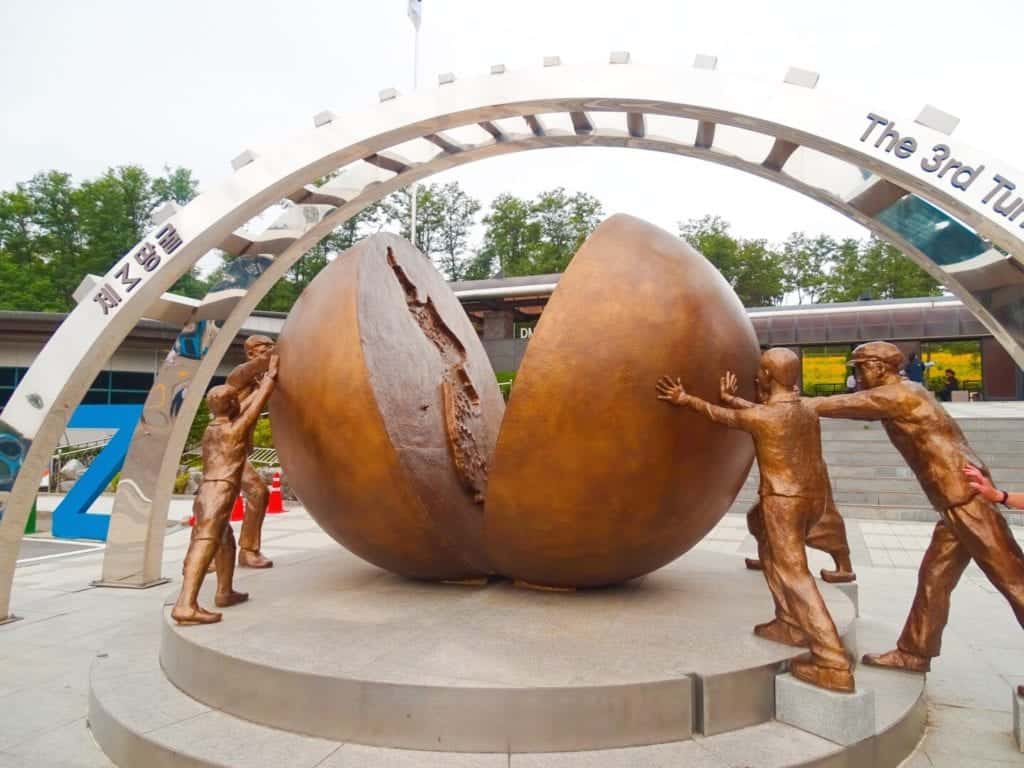
What is the DMZ?
The DMZ stands for the demilitarized zone : an area of no man’s land that acts as a buffer between North and South Korea. Other such buffers exist and have existed to separate countries or areas with a troubled history. It makes sense: two regions at loggerheads are more likely to fight and invade one another if they are at a close locality. The DMZ measures four kilometres in size. It’s not an entirely empty area because there are three villages inside: a fake propaganda village erected by the North Korean government, a real farmers village and an abandoned factory workers village that was inhabited until the 2016 threats of nuclear weapons from Kim Jung Un. I’ll talk more about these later when I discuss the observatory viewing platform.
A quick history of the DMZ
The DMZ was put in place at the end of the Korean War. This era was a tragic one that saw the loss of almost 10 million Korean lives. Yet it wasn’t fought just by Koreans: this war from 1950 to 1953 was a product of the Cold War, fuelled by America and Russia. If you know much about the Vietnamese war, it’s the same, right down to the fact that the Soviets occupied the North and the Americans occupied the South, fighting to stop the country slipping to the other’s school of thought. This ideological war was happening in many countries around the world at this time. The Korean War ended in 1953, although it was technically won by neither side. An Armistice agreement was signed but no peace treaty was. The North stayed communist and was annexed by Kim Il-sung, the grandfather of the leader today, Kim Jong Un. With no peace restored between the countries, a buffer zone seemed the only way to keep the countries at bay. The DMZ was born.
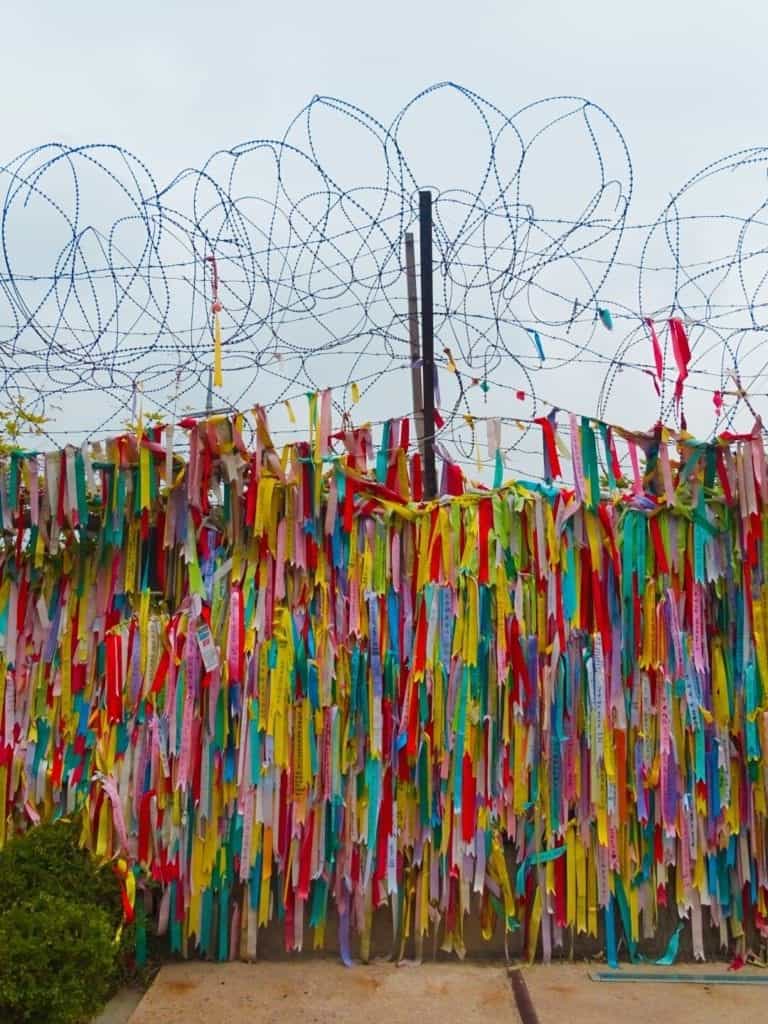
The two types of DMZ tour from Seoul
Depending on how much you want to see, there are two different DMZ tours from Seoul.
- The DMZ tour from Seoul (half day) including Dora Observatory, Imjingak Park, Tunnel 3 and the last train station. It runs every day.
- The DMZ tour from Seoul ( full-day) including the stops previously mentioned and the JSA (Joint Security Area). This is the only place you can see North and South Korea soldiers standing face-to-face. However, this tour is more costly and often cancelled last minute due to political tensions. 2022 update – these tours are not currently taking place. I’ll update this if things change.
In my opinion, the best DMZ tours are with GetYourGuide because they’re easy to book and have flexible cancellation policies.
What can you expect when visiting the DMZ from Seoul?
If you take a half-day DMZ tour like I did, it will last around 5 hours and stop at the following points of interest:
Imjingak Park
The first stop of our DMZ tour included seeing some statues and memorials relating to the Korean War and the DMZ that’s cut off so many families. You can also see war tanks and aircraft dating back to the War, as well as The Bridge of Freedom which many South Koreans crossed to come home after having been displaced by the fighting. While it was an interesting stop, I was excited to get to…
Third Tunnel
Despite the DMZ being put in place, North Korea have still tried to invade South Korea several times. In fact, four sizeable underground tunnels have been discovered in the DMZ. When The Third Tunnel of Aggression (what a name!) was discovered in the 1970s measuring 435 metres in length, North Korea said it wasn’t theirs. Later they changed their story and claimed they had been searching for natural resources. The whole situation is scary but at least all of these attempts to invade South Korea have been unsuccessful. The Third Tunnel is the only one visitors can go inside during DMZ Korea tours. It was very cold, dark and eerie (although less so because it was so busy) and we had to wear helmets in case of falling rocks. The journey back up was up a very steep slope so make sure you’re in good health to do this! Honestly, the tunnel was unremarkable and could have been any in the world. Yet knowing its history made it a very interesting stop indeed. How often can you say you’ve walked inside a living piece of history like this?
Dora Observatory
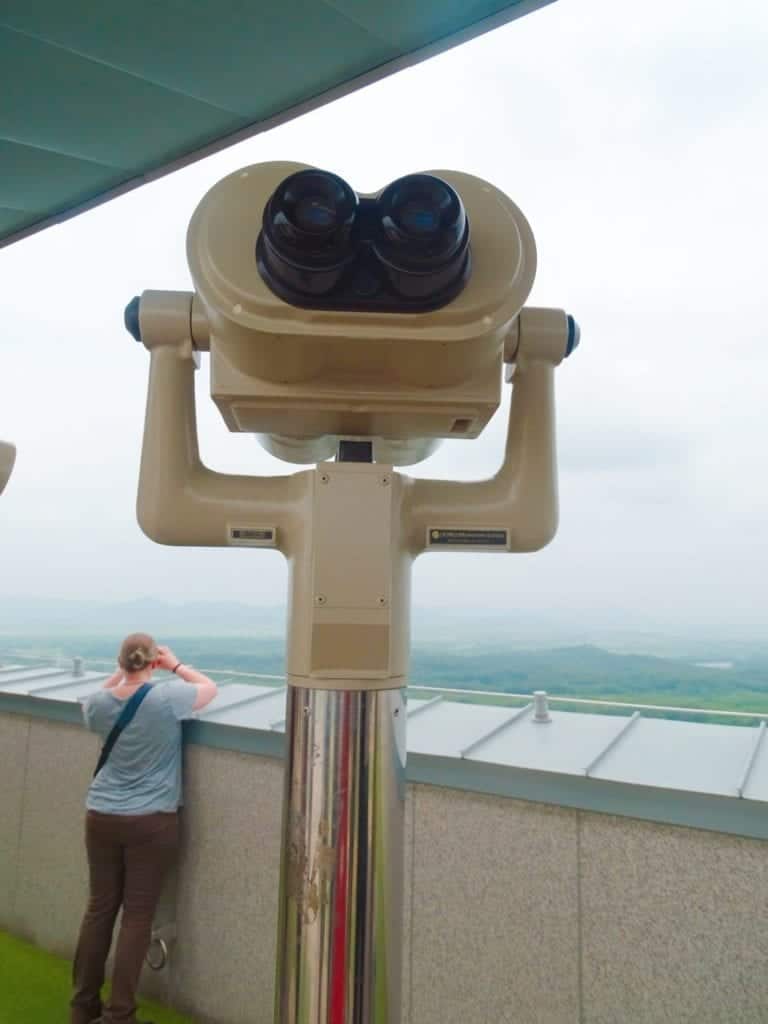
For me, the most interesting stop of our DMZ day tour from Seoul was Dora Observatory looking over the DMZ. From here you can see the fake Peace Village erected by North Korea, something I found bizarre and fascinating. According to North Korea, the Peace Village is inhabited by a community of farming families who have access to childcare, a hospital and school. Indeed, these buildings do exist and, from afar, it’s a colourful and attractive village.
The one problem? It’s totally empty. Nobody lives there and its only purpose is propaganda: to give the impression all is well in North Korea. Apparently, they think it may encourage South Koreans to defect to North Korea, although I’m not sure why anyone would! When you visit Dora Observatory, you’ll see two other villages located in the DMZ. One acted as a village for factory workers but has been abandoned since the nuclear weapon threats of 2016.
The other is a real farmers village , home to a small population of North Koreans. Straining my eyes through the binoculars, I was fascinated to spy an elderly man riding a bicycle. Trying to picture his life blew my mind. He’d have little to no understanding of the outside world and no access to foreign media. He’d be part of a communist system that prevents him from becoming wealthy and prohibits democratic procedures like voting to elect a new leader. To see him with my own eyes made everything feel real and sad.
Dorasan Station
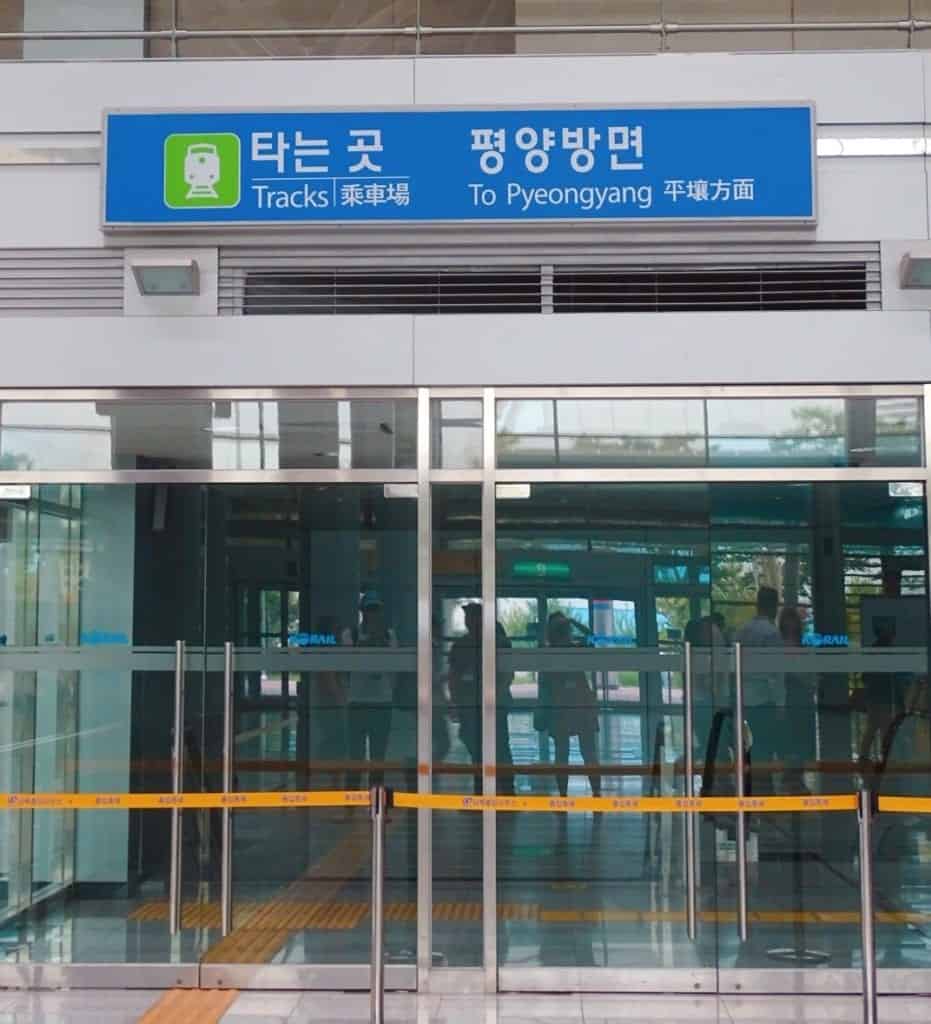
The final destination on the DMZ Seoul tour was Dorasan Station , the last train station before the border. A journey arrives and departs Seoul daily but the line can’t continue any further as the next stop would be in North Korea. Many South Koreans have donated money so that, if and when unity is restored, a line can be built connecting the divided nations. Ultimately, this is what South Koreans want: unity and to see their long-lost family members again. Will it happen? Our guide said she hopes it will one day but it’s not on the cards for the immediate future. King Jong Un is still young and showing no signs of cooperation.
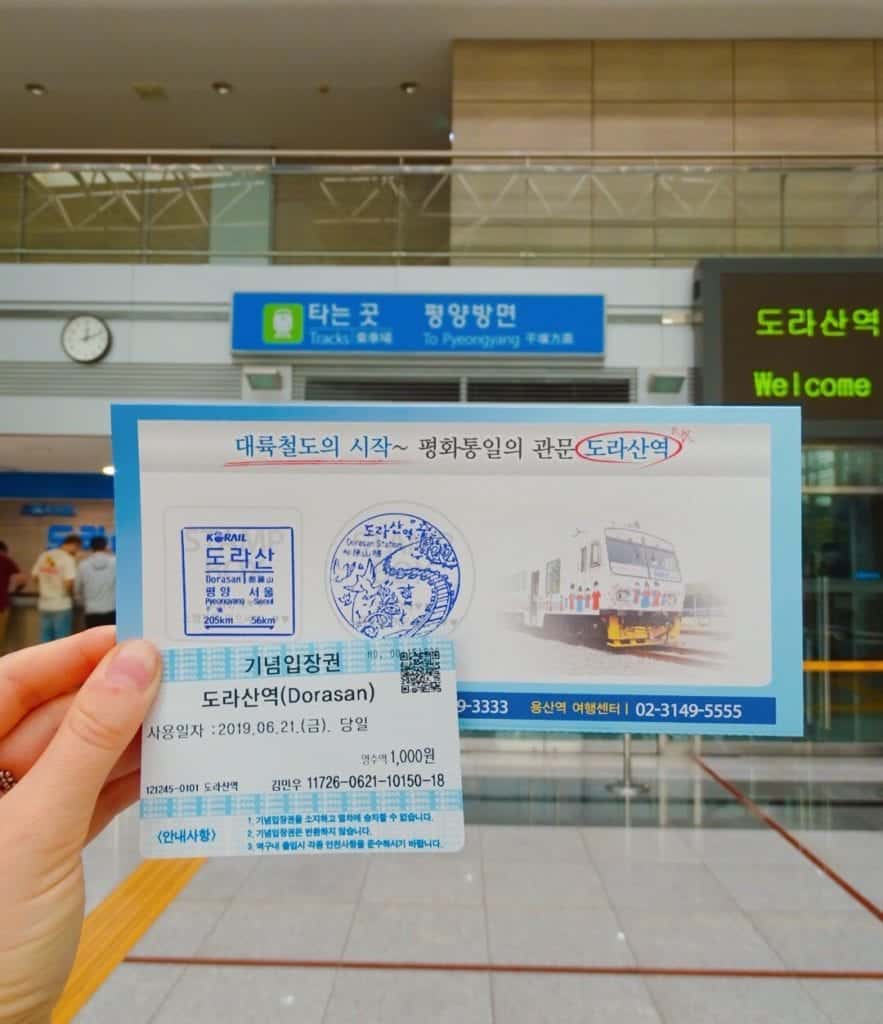
At Dorason Station, visitors can purchase a pretend ticket to Pyongyang, the North Korean capital. I bought one for 1,000 won (£1) and stamped it myself. This hopeful act made me feel sad again, for the North Koreans living under a dictatorship and for the South Koreans who have lost their loved ones. What a mad world we live in, but I’m so grateful for my ability to explore it.
Tips for the Korea DMZ tour from Seoul
- Dress relatively smart – word has it that North Korean soldiers sometimes photograph tourists in casual clothes like ripped jeans to use as propaganda to convince North Koreans that the outside world is poor and dangerous. Best not to let them.
- Bring your passport! Just double-reminding you so your whole tour doesn’t get denied entry 😉
- Pack any necessary medication like asthma inhalers etc – the walk up from the Third Tunnel is steep and a little cold. You’re meant to leave all your belongings and bags in a locker but you could bring something small like this in your pocket.
Overall, my experience visiting the DMZ from Seoul wasn’t happy or upbeat but it was truly worthwhile. Visiting is so important in order to understand the country and what the people have been through. I feel much better educated now about the situation in North and South Korea. If you’re planning a trip, I hope my tips for the Korea DMZ tour help you out 🙂 Browse and book DMZ tours from Seoul:
Thanks for reading!
Check out my other South Korea blogs:
- The ultimate South Korea bucket list
- 30 South Korea travel tips
- Solo female travel in Korea
- South Korea travel budget
- The best Busan day trips
- How to spend 2 weeks in South Korea
- The perfect 5 days in Seoul
- A guide to visiting Jeju Island without a car
- The ultimate Busan itinerary
- South Korea food guide
- Jeonju travel guide
See you next time for more adventures,
For more travel content, follow me on Instagram , Facebook , Twitter and YouTube .
Ps. Liked this? Pin it for later!
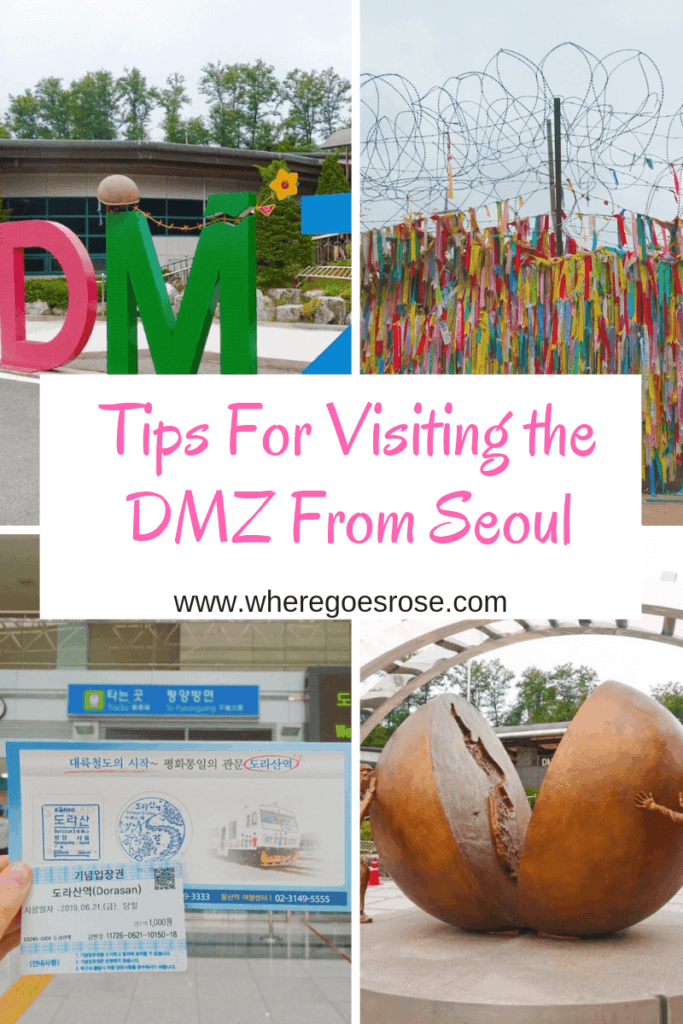
VISITING SOUTH KOREA? These are my trusted resources: Flights – I use Skyscanner to find the best-value flights, using the ‘search by month’ tool to find the cheapest dates. You can also use the ‘to anywhere’ feature if you’re flexible on where you’re going. Buses – buses are comfy and efficient. It’s tricky for foreigners to book online so it’s best to turn up on the day. Trains – use Trip.com , partner of Korail (the official railway network of Korea) to book your tickets in advance. The website accepts international payment options, unlike Korean rail websites. Click the three stripes in the top right corner then the flag to change it to English. Driving in Korea – use Rentalcars.com to compare car rentals. Hiring a car will be especially useful on Jeju Island. For hotels in Korea, I use Booking.com – they also have self-catering apartments. You can filter by review score and price to find the best-rated budget places. For hostels, I use Hostelworld . Browse South Korea tours and activities on GetYourGuide . I also check Viator and Klook in case they have a better price. For food tours with passionate local chefs and foodies, check out EatWith . Need travel insurance ? I use True Traveller (for UK & Europe residents) since it’s affordable but covers everything you’d need including various activities, valuables and pre-existing conditions. Unlike some companies, they insure you if you’re already travelling / don’t yet have your flight home booked. Get a quote . For travel insurance for other nationalities, I recommend Hey Mundo and for long-term digital nomad travellers, I suggest Safety Wing . Check out my resources page for more travel discounts and tips!
Rose is a solo traveller from the UK who has been on the road since 2015. She wants to show other women that solo travel isn't scary and doesn't have to be expensive! Rose has lived in Mexico, Canada and all over Asia, seeking out food, bubble tea and street art wherever she goes!
2 thoughts on “ Taking A Korea DMZ Tour From Seoul – What To Expect + Tips ”
I read on this article that you had a really great south korean tour guide for the DMZ. I was wondering if you remembered her name, or the specific tour you took. I ask because I would also like to book a DMZ tour and found her story quite interesting and moving. Would love to get a chance to do the tour with her!
Do let me know – thanks!
Hello, I don’t recall her name now or have a contact. Sorry!
Leave a Reply Cancel reply
Your email address will not be published. Required fields are marked *
You can see how this popup was set up in our step-by-step guide: https://wppopupmaker.com/guides/auto-opening-announcement-popups/
Winter is here! Check out the winter wonderlands at these 5 amazing winter destinations in Montana
- Travel Destinations
How To Visit Korea’s JSA & The DMZ Tour (Guide & Tips)
Published: September 10, 2023
Modified: December 27, 2023
by Gilberta Hewitt
- Plan Your Trip
- Travel Guide
- Travel Tips
- South Korea
Introduction
Welcome to the enchanting and historically significant world of Korea’s Joint Security Area (JSA) and Demilitarized Zone (DMZ) tour. This unique journey offers visitors a rare glimpse into the political and military complexities of the Korean Peninsula.
Situated just 35 miles north of Seoul, the JSA & DMZ serve as a powerful reminder of the division between North and South Korea. It is a place where past and present intersect, where tension and curiosity coexist, making it a must-visit destination for history buffs, adventure seekers, and those interested in geopolitics.
The JSA, also known as Panmunjom, is the only point where North and South Korean soldiers stand face-to-face. It is a symbol of the ongoing ceasefire agreement and the fortified border that separates the two nations. On the other hand, the DMZ spans 2.5 miles on either side of the border, creating a buffer zone that preserves a fragile peace.
In this comprehensive guide, we will provide you with all the necessary information to ensure a memorable and smooth JSA & DMZ tour experience. We will cover everything from understanding the significance of these areas to preparing for the journey, booking a tour, navigating security regulations, and exploring the key highlights of the JSA and DMZ.
Whether you are a history enthusiast wanting to witness the vestiges of the Korean War, a curious traveler intrigued by geopolitics, or simply someone seeking a unique and offbeat adventure, the JSA & DMZ tour offers something for everyone.
So, buckle up as we unravel the wonders of the JSA & DMZ and guide you through this fascinating journey into one of the most politically charged regions in the world.
Understanding the JSA & DMZ
Before embarking on your JSA & DMZ tour, it’s essential to grasp the historical and political significance of these areas. The Joint Security Area (JSA) and the Demilitarized Zone (DMZ) play a crucial role in the ongoing conflict between North and South Korea.
The JSA, also known as Panmunjom, is a small area within the DMZ where meetings between the two Koreas take place. It is the only spot where North Korean and South Korean soldiers stand face-to-face, creating a visually captivating and tense atmosphere. This is highly symbolic of the division and ongoing ceasefire agreement between the two nations.
The DMZ, on the other hand, is a 2.5-mile-wide de facto border that stretches across the Korean Peninsula. This buffer zone was established at the end of the Korean War in 1953 to maintain a fragile peace between the two countries. It acts as a demilitarized zone, limiting military presence and activities, while also preserving a unique ecosystem that has flourished in the absence of human interference.
The DMZ has become a significant tourist attraction, offering a glimpse into the history and current state of affairs between North and South Korea. It houses various landmarks, such as the Third Tunnel of Aggression, the Dora Observatory, and the Imjingak Park, each carrying its own story and historical context.
One of the most remarkable features of the JSA is the famous blue conference buildings, where inter-Korean meetings take place. The building itself straddles the military demarcation line, with one half technically belonging to North Korea and the other half to South Korea. Visitors to the JSA can step inside these buildings and stand in both countries simultaneously, experiencing a truly unique and surreal moment.
Understanding the historical context and geopolitical dynamics of the JSA & DMZ will enrich your tour experience, allowing you to appreciate the significance of the sites you will visit. It’s essential to approach the tour with an open mind and a willingness to learn about the complexities and challenges faced by the two Koreas.
Now that you have a better understanding of the JSA & DMZ, it’s time to prepare for your journey. In the next section, we will provide you with essential tips on how to plan and book your tour.
Preparing for the Tour
Embarking on a tour to the JSA & DMZ requires careful preparation to ensure a smooth and fulfilling experience. Here are some essential tips to help you get ready for your journey:
- Check travel advisories: Before planning your tour, it’s crucial to check the latest travel advisories and warnings issued by your government. Ensure that it is safe to visit the area and that there are no restrictions or security concerns.
- Reserve in advance: Due to high demand and limited daily visitor quotas, it’s advisable to book your JSA & DMZ tour well in advance. This will secure your spot and allow you to choose from various tour options.
- Choose a reputable tour operator: Selecting a reliable and experienced tour operator is vital for a successful JSA & DMZ tour. Look for operators with positive reviews, knowledgeable guides, and adherence to safety protocols.
- Prepare necessary documents: Carry your passport or identification document with you as it will be required for verification purposes at the security checkpoints. Additionally, ensure to have a printed copy of your tour confirmation or e-ticket.
- Dress appropriately: As the JSA & DMZ are active military areas, wearing casual, comfortable clothing is recommended. Avoid clothing with provocative slogans or symbols, and do not wear clothing resembling military uniforms.
- Observe photography restrictions: There are certain areas within the JSA & DMZ where photography is strictly prohibited. Follow the instructions of your tour guide and respect these limitations to avoid any unwanted complications.
- Pack essentials: Carry essential items such as sunscreen, a hat, sunglasses, a reusable water bottle, and a raincoat or umbrella, as the weather can change unexpectedly. It’s also advisable to pack some snacks for the tour as food options may be limited.
- Follow security guidelines: A visit to the JSA & DMZ involves passing through multiple security checkpoints. Be prepared to undergo security screenings, including bag checks and metal detector scans. Follow the instructions of the tour guide and security personnel at all times.
- Be respectful and mindful: The JSA & DMZ hold significant historical and political importance. Show respect for the solemnity of the sites and the military personnel present. Refrain from making inappropriate jokes or engaging in disruptive behavior.
By following these preparatory steps, you will be well-equipped to embark on a fulfilling and memorable tour to the JSA & DMZ. The next section will guide you through the process of booking a tour to ensure you secure your spot and make the most of your visit.
Booking a Tour
Booking a tour to the JSA & DMZ is the most convenient and recommended way to visit these historically significant areas. Here are some key considerations when booking your tour:
- Research different tour options: Start by conducting thorough research on various tour operators that offer JSA & DMZ tours. Look for reputable companies that have positive reviews, experienced guides, and comprehensive itineraries.
- Compare tour packages: Take the time to compare different tour packages and their inclusions. Some tours may prioritize specific sites within the JSA & DMZ, so choose a tour that aligns with your interests and preferences.
- Check availability: Due to limited daily visitor quotas, it’s crucial to check the availability of tours on your chosen date. Popular months and weekends tend to get booked quickly, so plan ahead and secure your spot early.
- Consider additional attractions: Some tour packages may include visits to additional attractions near the JSA & DMZ, such as the Third Tunnel of Aggression or the Dora Observatory. If you’re interested in exploring these sites, look for tours that offer these options.
- Read reviews and testimonials: Before finalizing your booking, read reviews and testimonials from previous tour participants. This will give you insights into the experiences of others and help you make an informed decision.
- Check cancellation policy: Ensure you are familiar with the tour operator’s cancellation policy. Circumstances may change, and having a clear understanding of the cancellation terms will provide you with peace of mind.
- Book through a reputable platform: Use trusted booking platforms or directly book through the tour operator’s official website. This will help ensure the legitimacy of your reservation and minimize the risk of fraudulent activities.
- Provide accurate information: When booking your tour, make sure to provide accurate personal details, including your full name, passport or ID number, and contact information. Double-check the information for any errors before submitting your reservation.
- Confirm the meeting point: Pay attention to the meeting point provided by the tour operator. Familiarize yourself with the location and plan your transportation accordingly to arrive on time.
- Keep a copy of your reservation: Once your tour is booked, keep a digital or printed copy of your reservation confirmation. This will serve as proof of your booking and make the check-in process smoother on the day of the tour.
By following these guidelines, you can easily navigate the process of booking a tour to the JSA & DMZ. Booking in advance ensures that you secure your spot and grants you peace of mind, knowing that your visit to these historically significant areas is well organized.
Next, we will discuss the various transportation options available to reach the JSA & DMZ for your tour.
Getting to the JSA & DMZ
Reaching the Joint Security Area (JSA) and the Demilitarized Zone (DMZ) for your tour requires careful consideration of transportation options. Here are the main ways to get to the JSA & DMZ:
- Join a guided tour: The most popular and convenient way to reach the JSA & DMZ is by joining a guided tour. Tour operators provide organized transportation with pick-up and drop-off points in major cities, such as Seoul. This eliminates the hassle of navigating public transportation and ensures you have a knowledgeable guide throughout the journey.
- Public transportation: If you prefer to explore on your own, you can use public transportation to reach the JSA & DMZ. From Seoul, take the subway or a local bus to Imjingak Park, a central area near the DMZ. From there, you can transfer to a designated shuttle bus that takes visitors to the JSA and other key sites within the DMZ.
- Hire a private driver: For a more personalized experience, you can hire a private driver to take you to the JSA & DMZ. This option offers flexibility in terms of itinerary and allows for customization based on your interests and schedule.
- Group tours: Some organizations and universities also organize group tours to the JSA & DMZ. These tours often include transportation and provide a unique opportunity to explore the area with like-minded individuals.
- DMZ Train: The DMZ Train is a popular option for visitors who want a scenic journey to the DMZ. This train departs from Seoul and takes you through the beautiful countryside before arriving at the DMZ. From there, shuttle buses are available to transfer you to the JSA and other attractions.
It’s important to note that regardless of the transportation option you choose, access to the JSA is only possible through guided tours, as it is a highly secure military area.
When planning your journey to the JSA & DMZ, consider factors such as convenience, time constraints, and personal preferences. Guided tours provide a hassle-free experience, while public transportation and private drivers offer more flexibility and customization.
Next, let’s delve into the security regulations and guidelines you need to be aware of before visiting the JSA & DMZ.
Security and Regulations
Visiting the Joint Security Area (JSA) and the Demilitarized Zone (DMZ) requires strict adherence to security regulations. As these areas are still active military zones, it’s essential to be aware of the following guidelines:
- Identification and registration: When entering the JSA & DMZ, all visitors must present a valid identification document, such as a passport. This is necessary for security purposes and to ensure that only authorized individuals enter the area. Along with ID verification, visitors are also required to register their personal information before entering the JSA.
- No inappropriate behavior: Respect the solemnity and sensitivity of the JSA & DMZ by refraining from inappropriate behavior, such as making jokes, taking selfies in inappropriate locations, or engaging in disruptive behavior. Follow the instructions provided by the tour guide and security personnel at all times.
- No pointing or gesturing: It is strictly prohibited to point, gesture, or make any provocative actions towards North Korean soldiers or personnel. While it may seem harmless, such actions can escalate tensions and compromise the security and integrity of the area.
- Stay within designated areas: During the tour, it’s important to stay within the designated areas and follow the instructions of your tour guide. Straying from the identified paths or crossing into unauthorized areas is not allowed, as it can jeopardize personal safety and violate security regulations.
- Be mindful of photography restrictions: Certain areas within the JSA & DMZ have strict photography restrictions. Listen to your tour guide and follow their instructions regarding where photography is allowed and where it is prohibited. Ignoring these guidelines can lead to confiscation of equipment or other consequences.
- Respect dress code: As the JSA & DMZ are military areas, it’s important to dress appropriately. Avoid wearing clothing with provocative slogans or symbols, and do not wear attire resembling military uniforms. Dress comfortably, and consider the weather conditions when choosing your outfit.
- Do not bring restricted items: Leave behind any items that are considered restricted within the JSA & DMZ, such as weapons, drones, large backpacks, or flammable substances. Security checks are conducted, and bringing restricted items can result in delays or denial of entry.
- Follow emergency procedures: In the event of an emergency or unforeseen situation, listen to the instructions provided by your tour guide and follow their lead. They are trained to handle any unexpected incidents and will prioritize your safety and well-being.
- Stay informed: Stay updated on any changes in security regulations or guidelines prior to your visit. Check the official websites or contact your tour operator for the most up-to-date information. It is your responsibility to stay informed and comply with the regulations in place.
By adhering to these security regulations and guidelines, you can ensure a safe and respectful visit to the JSA & DMZ. Remember, these areas are sensitive and hold deep historical and political significance, so it is essential to approach the tour with a responsible and mindful attitude.
Now that you are familiar with the security regulations, it’s time to delve into the highlights and key attractions of the Joint Security Area (JSA) and the Demilitarized Zone (DMZ) in the next section.
Exploring the Joint Security Area (JSA)
The Joint Security Area (JSA), also known as Panmunjom, is the heart of the Korean Demilitarized Zone (DMZ) and a highlight of any visit to this region. Here, visitors have the unique opportunity to witness the standoff between North and South Korea and experience the tension and history firsthand.
Upon arrival at the JSA, you will be guided through various significant sites by a knowledgeable tour guide. Here are some key highlights you can expect to explore:
- Panmunjom: Panmunjom is the main area within the JSA where negotiations between North and South Korea take place. It’s an iconic symbol of the division between the two nations. Visitors can step into the blue conference buildings, where inter-Korean meetings occur. Standing precisely on the military demarcation line, you can find yourself in both North and South Korea simultaneously, creating a truly surreal experience.
- Freedom House and Conference Row: Freedom House is a building located within the JSA that was built for inter-Korean reunions. It serves as a venue for various diplomatic engagements and discussions. Nearby, you can also witness the Conference Row, a series of buildings where military officials from both sides of the border convene for meetings.
- Bridge of No Return: The Bridge of No Return holds historical significance as the site where prisoner exchanges took place during the Korean War. It got its name after the war when prisoners were given the choice to stay in their captor’s country or return to their home country. Once they crossed this bridge, there was no turning back.
- Peace Bell: The Peace Bell is a striking monument located within the JSA. It serves as a symbol of hope and unity for the Korean people, reminding visitors of the importance of peace and reconciliation on the Korean Peninsula.
- Observation Points: As part of the JSA tour, you will have the opportunity to visit observation points that overlook North Korea. These points allow you to glimpse into the neighboring country and witness the stark contrast between the two sides of the border.
Exploring the Joint Security Area provides a profound insight into the ongoing tensions and political complexities of the Korean Peninsula. It’s a chance to witness history in action and gain a deeper understanding of the challenges faced by both North and South Korea.
Now, let’s move on to the next section, where we will unveil the captivating sites and experiences offered by the Demilitarized Zone (DMZ).
Visiting the Demilitarized Zone (DMZ)
The Demilitarized Zone (DMZ) is a captivating and historically significant area that stretches across the Korean Peninsula, separating North and South Korea. A visit to the DMZ offers a unique opportunity to understand the geopolitical dynamics and experience the remnants of the Korean War. Here are some key highlights and experiences you can expect when visiting the DMZ:
- The Third Tunnel of Aggression: One of the most intriguing sites within the DMZ is the Third Tunnel of Aggression. This tunnel was discovered in 1978 and is believed to have been crafted by North Korea as a potential invasion route into South Korea. Visitors can explore a section of the tunnel and learn about its historical significance.
- Dora Observatory: The Dora Observatory provides a panoramic view of the DMZ and the surrounding area. On a clear day, you can even catch a glimpse of the North Korean city of Kaesong. This observatory not only offers stunning views but also serves as a reminder of the division and the desire for reunification.
- Imjingak Park: Imjingak Park is a symbolic area located near the DMZ, offering a peaceful and reflective atmosphere. It features landmarks like the Bridge of Freedom, which was used by prisoners of war returning to South Korea, and the Freedom Bell, which represents the hope for reunification. Imjingak Park is a poignant reminder of the shared history and aspirations of the Korean people.
- Panoramic view from Dora Sanzan: For an even more striking view of the DMZ, you can visit Dora Sanzan, a trio of hills located near the border. From here, you can witness the vast expanse of the DMZ and appreciate the stark contrast between the heavily guarded border and the peaceful landscape beyond.
- Unification Bridge: The Unification Bridge is a symbolic suspension bridge that spans the Imjin River, connecting North and South Korea. While visitors cannot cross the bridge, it serves as a reminder of the hope for reunification and the desire to bridge the gap between the two nations.
A visit to the DMZ offers not only a chance to witness the physical division but also an opportunity to reflect on the shared history and aspirations of the Korean people. It serves as a powerful reminder of the ongoing strive for peace and reunification.
Now that you are familiar with the highlights of the DMZ, it’s time to delve into some essential tips and advice to make the most of your JSA & DMZ tour. Continue reading to ensure a memorable and enriching experience!
Important Tips and Advice
To ensure a smooth and enjoyable JSA & DMZ tour experience, here are some essential tips and advice to consider:
- Follow instructions and guidelines: Always listen to the instructions provided by your tour guide and follow any guidelines given. They are there to ensure your safety and the integrity of the areas you will visit.
- Arrive early: Plan to arrive early at the meeting point to avoid any delays or rushing. This will give you time to check-in, go through security checks, and familiarize yourself with the tour itinerary.
- Respect the solemnity of the sites: Both the JSA and the DMZ are areas of deep historical and political significance. Show respect and refrain from making jokes or engaging in inappropriate behavior that may diminish the seriousness of the locations.
- Stay with the group: Throughout the tour, it’s essential to stay with your tour group and follow the designated paths. Straying from the group or crossing into unauthorized areas is strictly prohibited for security reasons.
- Keep your personal belongings secure: As you will be passing through various security checkpoints, keep your personal belongings secure and watchful. Avoid bringing unnecessary valuables and always keep an eye on your belongings to prevent any loss or confusion.
- Stay informed about the latest news: Keep yourself updated on any changes or developments related to the JSA & DMZ. This includes checking official websites and monitoring news updates to ensure you have the most accurate information before your tour.
- Be mindful of the sensitivities: Remember that visiting the JSA & DMZ is a unique experience that involves the ongoing political and military tensions between North and South Korea. Be mindful of the sensitivities and avoid engaging in discussions or actions that may cause unnecessary tension.
- Engage with your tour guide: Make the most of your tour by engaging with your knowledgeable tour guide. They can provide valuable insights, answer your questions, and enhance your understanding of the sites you visit.
- Capture memories respectfully: Photography is allowed in certain areas, but be mindful of the restrictions and guidelines. Respect the privacy of others and the solemn nature of the sites when capturing your memories. Avoid taking selfies in inappropriate locations and always ask permission before taking photos of other visitors or military personnel.
- Reflect on the experience: After the tour, take a moment to reflect on the experience and the knowledge you have gained. The JSA & DMZ tour offers a unique perspective on the complex history and political situation of the Korean Peninsula, and embracing this opportunity for reflection can enhance your overall understanding and appreciation.
By keeping these tips and advice in mind, you can ensure a respectful, safe, and enlightening JSA & DMZ tour. Now, armed with essential knowledge, prepare for an unforgettable journey through the fascinating world of the Joint Security Area and the Demilitarized Zone.
To conclude, the JSA & DMZ tour is a profound adventure that offers a rare opportunity to witness the ongoing division and historical significance of the Korean Peninsula. It’s a journey that combines geopolitics, history, and cultural understanding, leaving visitors with a deeper appreciation for the complexities and struggles faced by the Korean people. So, get ready to embark on this extraordinary venture and immerse yourself in the mesmerizing world of the JSA & DMZ!
The Joint Security Area (JSA) and the Demilitarized Zone (DMZ) tour offers a remarkable opportunity to explore the historical, political, and cultural complexities of the Korean Peninsula. This journey provides a deeper understanding of the ongoing division between North and South Korea while allowing visitors to witness firsthand the tension and symbolism of these areas.
From standing in both North and South Korea simultaneously at the JSA to exploring the historical sites within the DMZ, such as the Third Tunnel of Aggression and the Dora Observatory, every step of the tour is filled with profound insights and thought-provoking experiences.
To make the most of your JSA & DMZ tour, it’s essential to prepare in advance, book your tour with reputable operators, and adhere to the security regulations. By following these guidelines, you ensure a smooth and safe experience as you delve into the fascinating world of the Korean Demilitarized Zone.
As you journey through the JSA and the DMZ, remember to approach each site with respect, mindfulness, and a desire to learn. Engage with your knowledgeable tour guide, capture memories respectfully, and be cognizant of the sensitivities surrounding the ongoing conflict.
By the end of your tour, you will leave with a profound understanding of the historical significance, political challenges, and aspirations for peace and reunification that define the Korean Peninsula. The JSA & DMZ tour offers an incredible journey that will leave an indelible mark on your understanding of this region.
So, prepare for a captivating adventure as you unravel the wonders of the Joint Security Area and the Demilitarized Zone. Embrace the unique experiences, reflect on the complexities of the Korean Peninsula, and return home with a deeper appreciation for the historical and geopolitical intricacies that shape this captivating part of the world.

- Privacy Overview
- Strictly Necessary Cookies
This website uses cookies so that we can provide you with the best user experience possible. Cookie information is stored in your browser and performs functions such as recognising you when you return to our website and helping our team to understand which sections of the website you find most interesting and useful.
Strictly Necessary Cookie should be enabled at all times so that we can save your preferences for cookie settings.
If you disable this cookie, we will not be able to save your preferences. This means that every time you visit this website you will need to enable or disable cookies again.
Cookies help us gathering information to keep this Blog running. We do not collect personally identifiable information or build user profiles ( learn more ). We'll still love you if you opt-out, though 😘
Honest Review of Our DMZ Tour from Seoul, South Korea
Share this post with others
We went on a DMZ Adventure and can fully recommend it!
We must admit that as Germans we have a certain fascination with divided countries. Korea was no exception here. For us, it was a no-brainer to visit the DMZ – the demilitarized zone between North and South Korea.
The DMZ tour is great for everybody interested in history. Additionally, for most of us, this is as close as we’ll ever get to North Korea.
Our DMZ Tour Review
What to expect on the dmz tour.
- What Other Travellers Say About the DMZ Tour
What Does the DMZ Tour Include?
Conclusion: should you book the dmz tour, dmz tour from seoul, south korea – our review.
In the following, we are reviewing the DMZ Adventure Day Tour from Seoul as this is the tour we took. Note that we chose the option including the Gamaksan Suspension Bridge.

We were picked up in time at our meeting point in Myeongdong which was within walking distance from our accommodation .
We met our lovely tour guide Paul and were given badges to wear around our necks. As soon as we boarded our bus, Paul started to explain our itinerary. Afterwards, he spent the bus ride to our first stop giving an overview of Korean history. He also told us a lot of personal anecdotes which made the tour feel really special.
Before every stop, he carefully explained to us the history of the place as well as the schedule of our visit. We had enough time at each stop but also never too much.
Paul also accompanied us at all the stops to give directions and explanations. He was always open to questions and overall a great guide.
We quite enjoyed Imjingak as our lunch place. There’s a food court but also a convenience store if you’re looking for an affordable option.
As the tour had started at 7 am, we got some much-needed rest on the bus ride back. We made it back to Myeongdong by 5 pm.
Overall, the tour was convenient, organised, educational, fun, and well-guided.

These are the stops we visited on our DMZ tour:
1. Mt. Gamaksan Suspension Bridge
Nowadays, it looks like a nice photo spot but it used to be a fierce battlefield during the Korean War. It is a bit of a climb to reach the suspension bridge. Our lovely guide Paul hiked up with us and kindly took some photos of everybody who wanted to.
He also recommended we cross the suspension bridge and hike a bit further to get to a waterfall which was absolutely worth it.

2. Imjingak
Imjingak was our longest stop of the day as there’s a ton to see here. It’s also where we had our lunch break.
First, our guide showed and explained to us the most important points of interest:
- The altar where South Koreans pray for their relatives who remain in North Korea
- The Last Train Out
- The 30 Years Lost Monument
- Freedom Bridge
- The Comfort Woman Statue
- The Paju DMZ Gondola across the Imjingang River
Afterwards, we had some time to explore on our own. There are a lot of different war memorials dotted around Imjingak Park. A cool little gem is a little stall where you can buy North Korean money. For some strange reason, there’s also a small amusement park…

3. 3rd Invasion Tunnel
The 3rd Invasion Tunnel is one of four known tunnels under the border between North Korea and South Korea.
We weren’t quite sure what to expect from the tunnel as you are not allowed to take any pictures inside. We started our visit with a short movie about the Korean conflict (we were quite happy that our guide Paul provided some context).
Afterwards, Paul explained to us the formalities of visiting the tunnel. You have to wear a helmet as the ceiling can get quite narrow. First, you have to use the lockers as you are absolutely not allowed to take anything with you into the tunnel. Then, you have to climb down 73 meters (240 ft) on a rather steep ramp. This was rather physically challenging for us. I guess we were not alone with this – just watch the faces of the people walking up when you start your decent 😉
Only 265 m (870 ft) of the 1635 m (1 mi) long tunnel are open to the public. The South Koreans have blocked the actual Military Demarcation Line in the tunnel with three concrete barricades.
Before our ascent, we took a sip from the drinking fountain at the bottom. There are some benches on the way if you need a little rest.

4. Dora Observatory
Dora Observatory was our favourite stop on this tour. This might sound a bit weird because it’s only a place where you can observe North Korea with binoculars.
There were fewer binoculars than tourists but eventually, we got one. We were able to see North Korean buildings, the North Korean flag, and even some North Korean people.
We felt a bit like voyeurs but we couldn’t help being intrigued to get a glimpse into a place which is mostly hidden from the outside world.

5. Unification Village
To be honest, the last stop was more of a shopping stop – fortunately, the shopping did not feel forced at all, unfortunately, the option to walk around was very limited.
We recommend making the most of your time here and trying the soybean ice cream.

What Other T ravellers Say About the DMZ Tour
⭐ Rating: 4.9 / 5 (2000 + reviews)
The DMZ TOUR is one of the best experiences I had here in Korea. Our tour guide COOL did an exemplary job providing us with great history of the North and South Korea. He is the best! Before the tour i am quite hesistant if i will enjoy it, but after the tour, I actually had fun while learning. COOL was super helpful in so many ways and he was so kind and friendly too. I super love him! I will recommend this tour to my friends who will go visit South Korea. We even saw north Koreans over the telescope! […]
The DMZ tour we did includes:
- Admission to attractions
- English-speaking guide
- Round-trip transfers to and from the meet-up location
We absolutely think a DMZ tour is worth it. Especially, if you want to better understand South Korea or if you’re interested in history in general.

Disclaimer: This post contains affiliate links. If you use these links to buy something we may earn a commission. You would help us a lot if you do so. Thanks.
How to include a DMZ tour in your Korea itinerary:

1 Day in Seoul Itinerary + Map (Perfect for Stopovers)
You have 1 day in Seoul, Korea, we have the perfect 1 day Seoul itinerary!

4 Day Seoul Itinerary With Map
You have 4 days in Seoul Korea, we have the perfect itinerary for you!
Interested in personal updates and honest travel guides? Sign up for our biweekly bucketlist2life newsletter for exclusive behind the scenes looks into our travel planning!
Want to support us buy us a coffe, a tea – or a whisky., leave a comment.
Do you have any thoughts on this article? – We would love to hear from you!
Do you want to follow us on our jouney? Check this box to also signup for our Newsletter and never miss an update!
You have a link you want to share with others? This is a good place for it!
Do you want to receive a Push-Notification when someone replies to your comment? – Check this box!
- Search Please fill out this field.
- Newsletters
- Destinations
How to Visit the Korean DMZ
:max_bytes(150000):strip_icc():format(webp)/MeenaThiruvengadamBio-f8e47f8a4ff0442381c862ab8d1e0409.jpg)
It’s one of the world's most heavily militarized borders, but the 160-mile stretch of land that separates North Korea from South Korea is also a tourist draw welcoming more than a million visitors a year.
This area, known as the Korean demilitarized zone, or DMZ, is a no-man's land about 30 miles north of Seoul. It was created as a buffer in 1953 when the countries agreed to a cease-fire to pause the Korean War.
The DMZ splits the Korean Peninsula in half, separating communist North Korea from capitalist South Korea. It sits along the 38th parallel, the original dividing line that gave the U.S. control of one side and the Soviet Union control of the other in the aftermath of World War II. In 1953, North and South Korea each agreed to move their troops back 1.2 miles to create the DMZ.
Today, visiting the DMZ is one of the best day trips you can make from Seoul. It’s a place to learn about Korean history, the Korean War—which killed more than three million people—and the Koreans whose families have been divided just as the Korean peninsula has. Just don’t try and visit on your own. The DMZ can only be visited on a guided tour.
Be sure to book your tour in advance and try to schedule your tour for early in your visit. The DMZ is known to close on occasion with little or no notice.
How to Get to the DMZ
The only way to visit the DMZ is on a tour. Viator alone lists 18 different tours from which travelers can choose. Tours typically depart from Seoul, with many offering hotel pickups and dropoff service. The area is about an hour or so drive from Seoul. A handful of trains run from Seoul to Dorason Station within the DMZ, however visiting the area’s sites requires a guided tour.
What to Do at the DMZ
The main sights at the DMZ are The Bridge of Freedom, the Bridge of No Return, Dora Observatory, Dorason Station, and the 3rd Infiltration Tunnel. Certain tours also visit the Joint Security Area, also referred to as Panmunjom.
The JSA was historically used for diplomatic meetings. It's where prisoners of war were repatriated in 1953 and where the Korean Armistice Agreement was signed.
Until last year, the Joint Security Area was a place where armed North Korean and South Korean soldiers literally stood face to face with one another. South Korean guards carried pistols and stood in a modified taekwondo stance, clenching their fists and wearing sunglasses as a means of intimidating their North Korean counterparts.
Within the JSA is the Bridge of No Return, which was used for prisoner exchanges at the end of the Korean War. Its name is a reflection of the choice given prisoners of war. They could choose to remain in North Korea or cross the bridge never to return. The bridge was last used for a prisoner exchange in 1968.
Nowadays, the Joint Security Area primarily a tourist attraction and one of the few places where tourists can set foot inside North Korea. The JSA is home to a collection of blue buildings that straddle North and South Korea. Landmines were cleared from the area in 2018, and personnel working there are no longer armed.
If setting foot in North Korea isn’t on your bucket list, you can peek across the border from the Dora Observatory. The camouflage viewpoint is situated on top of a mountain and outfitted with several sets of binoculars through which you can catch a glimpse of North Korea’s propaganda village and the manufacturing city of Kaesong.
Kaesong was meant to be a place where raw materials from the south could be assembled into finished products and re-exported to the south. For about a year, freight trains carried raw materials to Kaesong and returned with finished goods.
Those trains passed Dorason Station, a commuter train station built to one day connect North and South Korean rail systems. Today, a handful of trains from Seoul terminate at Dorason Station.
The 3rd Tunnel was a North Korean effort discovered in 1978. It’s a mile long, 6.5 feet wide and 6.5 feet tall. An estimated 30,000 soldiers could move through the tunnel every hour. Visitors can enter the tunnel either by walking or by a monorail. Exhibits outside the tunnel document Korea’s history of division. If souvenir shopping is on your agenda, you’ll find options here.
Tips for Visiting the DMZ
- Don’t dress like a slob, especially if you’re taking a USO-organized tour of the area. Bare midriffs, sleeveless tops, open-toed shoes, and ripped jeans aren’t allowed. Remember, a poorly dressed tourist could find themselves becoming North Korean propaganda.
- Visiting the DMZ during your trip to South Korea is a must-do, but don't forget to book your tour in advance.
- Don’t forget your passport. You’ll need it to access key sights.
Related Articles
More related articles.

Borders Of Adventure
Leading Culture and Adventure Travel Blog by Becki Enright. Looking at the world with a different angle to change perceptions of misunderstood places, for the best in travel.
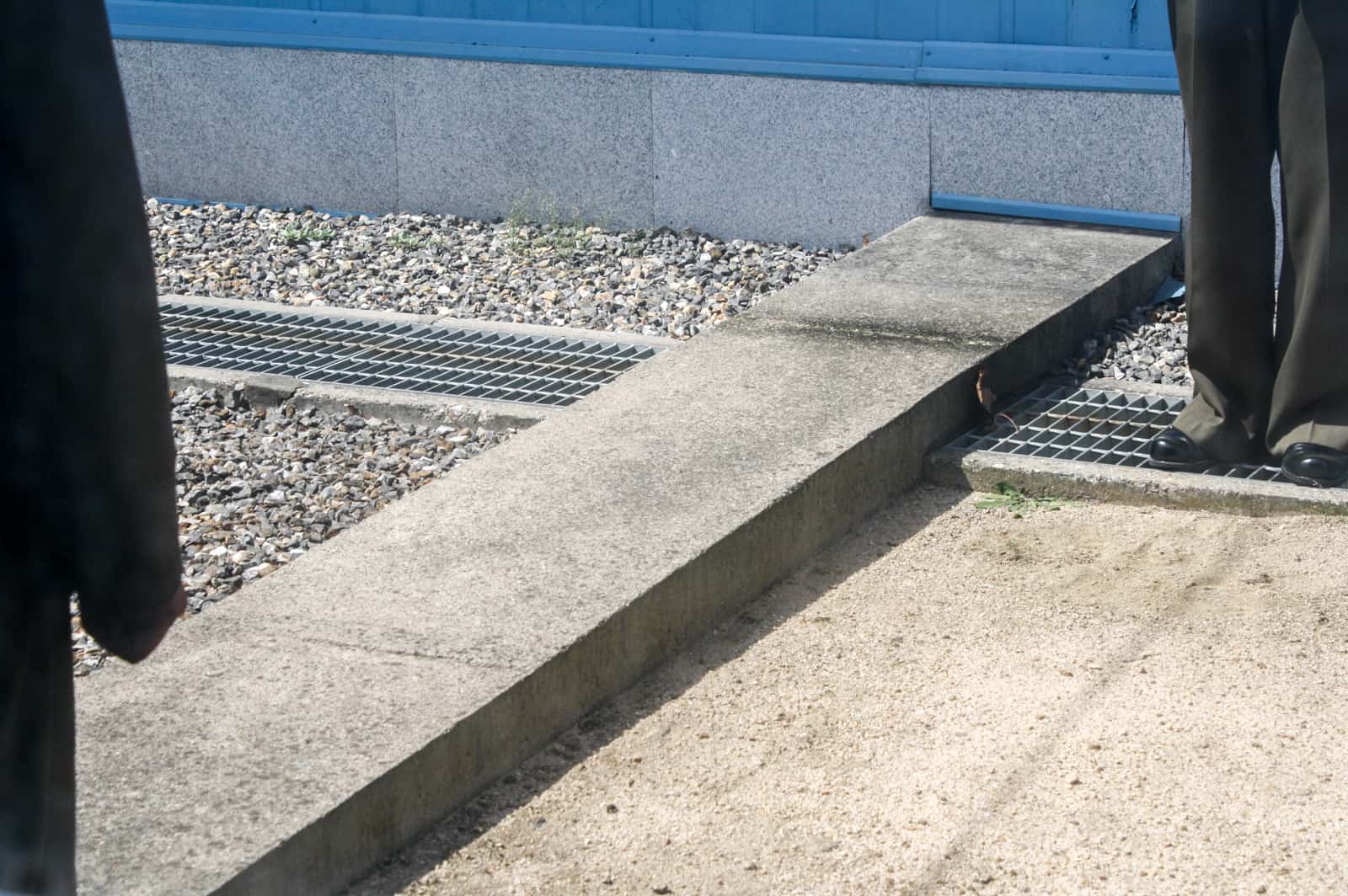
Misunderstood Destinations , North Korea , South Korea
Visit the DMZ in North Korea and South Korea – The Story From Both Sides
Disclaimer: This post contains affiliate links to handpicked partners, including tours, gear and booking sites. If you click through or buy something via one of them, I may receive a small commission. This is at no extra cost to you and allows this site to keep running.
To visit the DMZ from North Korea is tense and from South Korea, less so. What is it like to tour the DMZ and JSA and witness the world’s most heavily armed border?
I remember the first time I saw what visiting the DMZ in Korea was all about. I was 15 years old and watched Michael Palin go there on one of his travel series called Full Circle. He stood in a bland-looking room, spoke of the history of the Korean War, told us how he had to basically sign his life away on a piece of paper.
He then crossed an area of the room where there was a line marking on the floor. “Here I’m in North Korea,” he said, before moving his feet just a few inches and adding, “Now I’m in South Korea.”
I marvelled at the location of the DMZ, thinking about how you can stand in two countries at the same time, compounded by the horror that a divided Korea had such an intimidating, military-armed border. Would a trip to the world’s most heavily fortified border, dubbed “the scariest place on Earth” by former US President, Bill Clinton, during his visit in 1993, put a person’s life at risk in case of any outbreaks of gunfire, fighting, and attacks?
Rather, the DMZ Demilitarized Zone that slices Korea in two is something important to try and comprehend. Why does the DMZ exist? Is it a scary place? Why has the DMZ become a tourist attraction? Here’s what you need to know before you go.
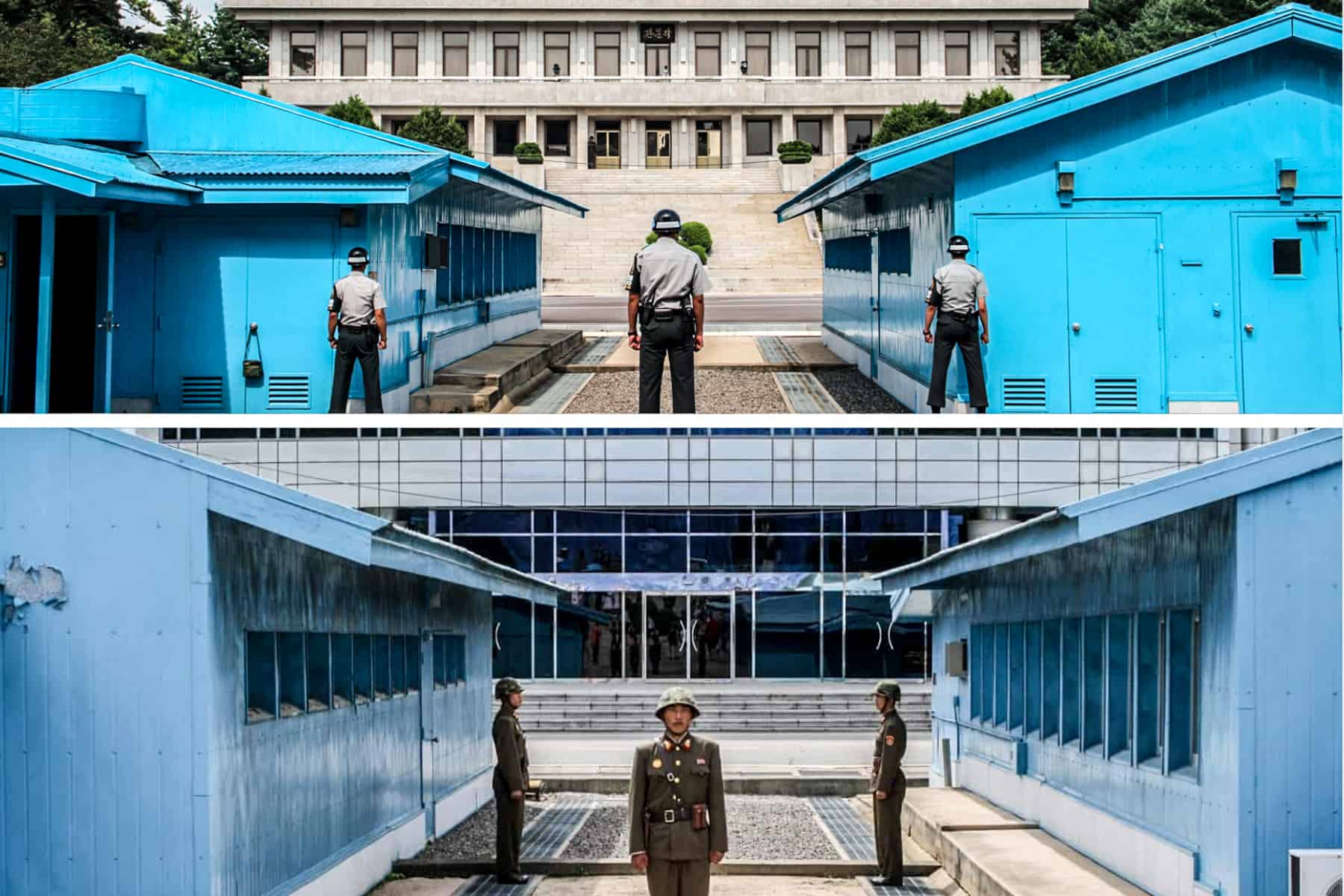
What is the DMZ Demilitarized Zone?
What part of the dmz do i see as a tourist, how to visit the dmz in north korea and south korea, the dmz in north korea (dprk), the dmz in south korea (republic), the reality when you tour the dmz, should a visiting the dmz be on your korea itinerary, dmz tour north korea, dmz tour south korea, planning to visit the dmz in korea save for later. .
The DMZ is a four-kilometre wide belt stretching 250 km, cutting the Korean peninsula almost in half at the 38 th parallel , and was put in place in 1953 as a ceasefire to the Korean War.
The Chinese and North Koreans pulled back 2km north and the UN forces 2km to the south, creating a ‘No Man’s Land’. Tanks, heavy artillery and mines exist on the Northern and Southern Limit Lines that are lined with barbed wire fences, but not within the DMZ itself, as was part of the armistice agreement.
Running through the middle of the 4km belt of ‘No Man’s Land’ is the Military Demarcation Line (the ‘actual’ border) and here sits Panmunjom – the “truce village”.
Within the neutral Panmunjom is the Joint Security Area (JSA). This is where negotiations between both sides took place and where today, democracy and communism now stand face-to-face in animosity. The Joint Security Area is the only section of the Korean DMZ where North and South Korean forces stand face-to-face.

The DMZ Military Demarcation Line at Panmunjom, Korea.
When you travel to the Korean DMZ on a tour, you will visit the JSA. Here, you enter the Military Armistice Commission Conference Room – the only place where anyone can freely ‘cross’ the Demarcation Line.
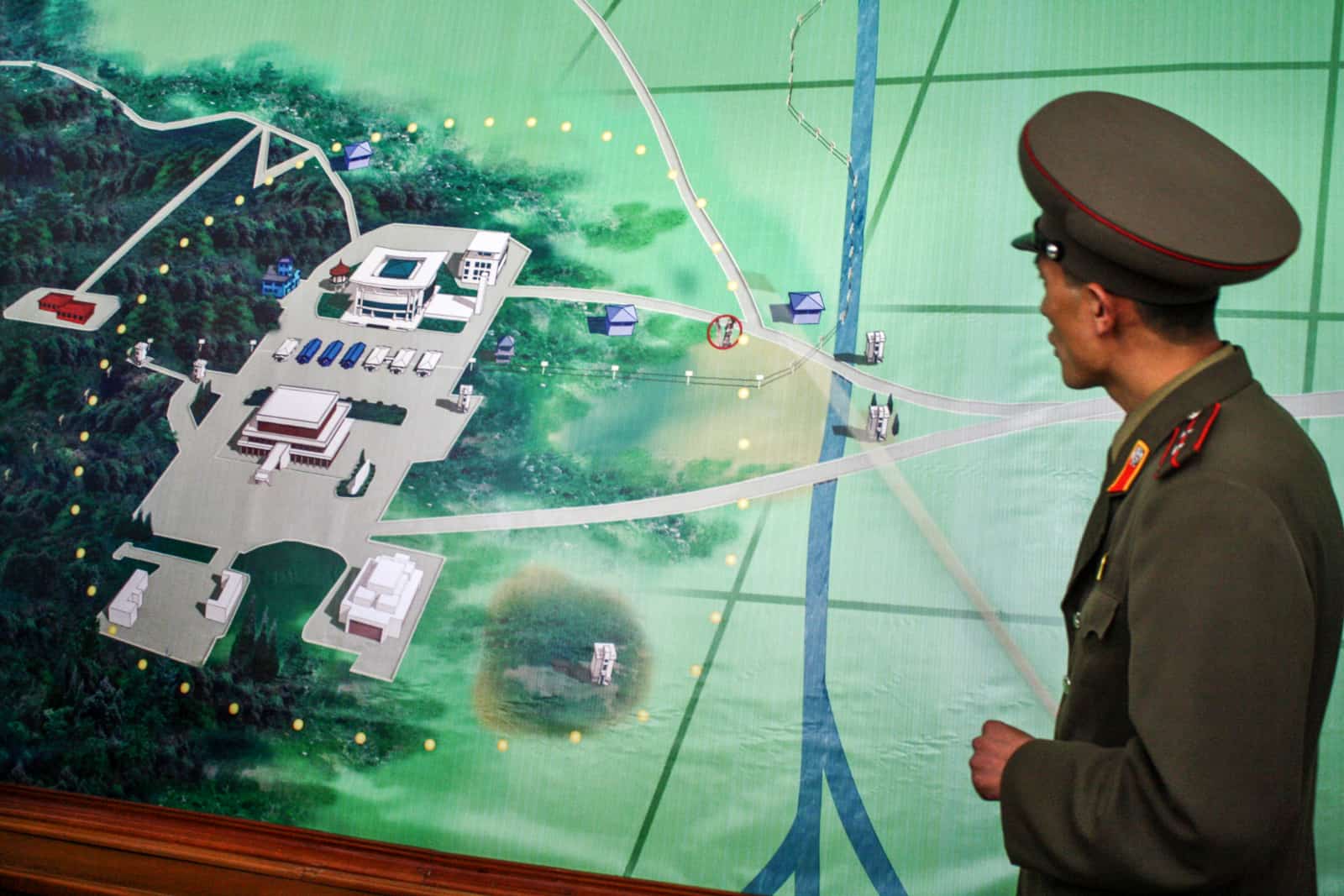
An explanation of the DMZ and JSA area by a North Korean guard.
I have seen the DMZ from both sides of Korea.
For me, it’s how I wanted to see and understand it – from the TWO viewing points in Panmunjom. I stood on the North Korean side in November 2012, and in South Korea a year later.
However, despite the viewing lines being only meters away from each other and the room you enter being the same one, they were both very different experiences.

North Korean Guards at the DMZ DPRK Side
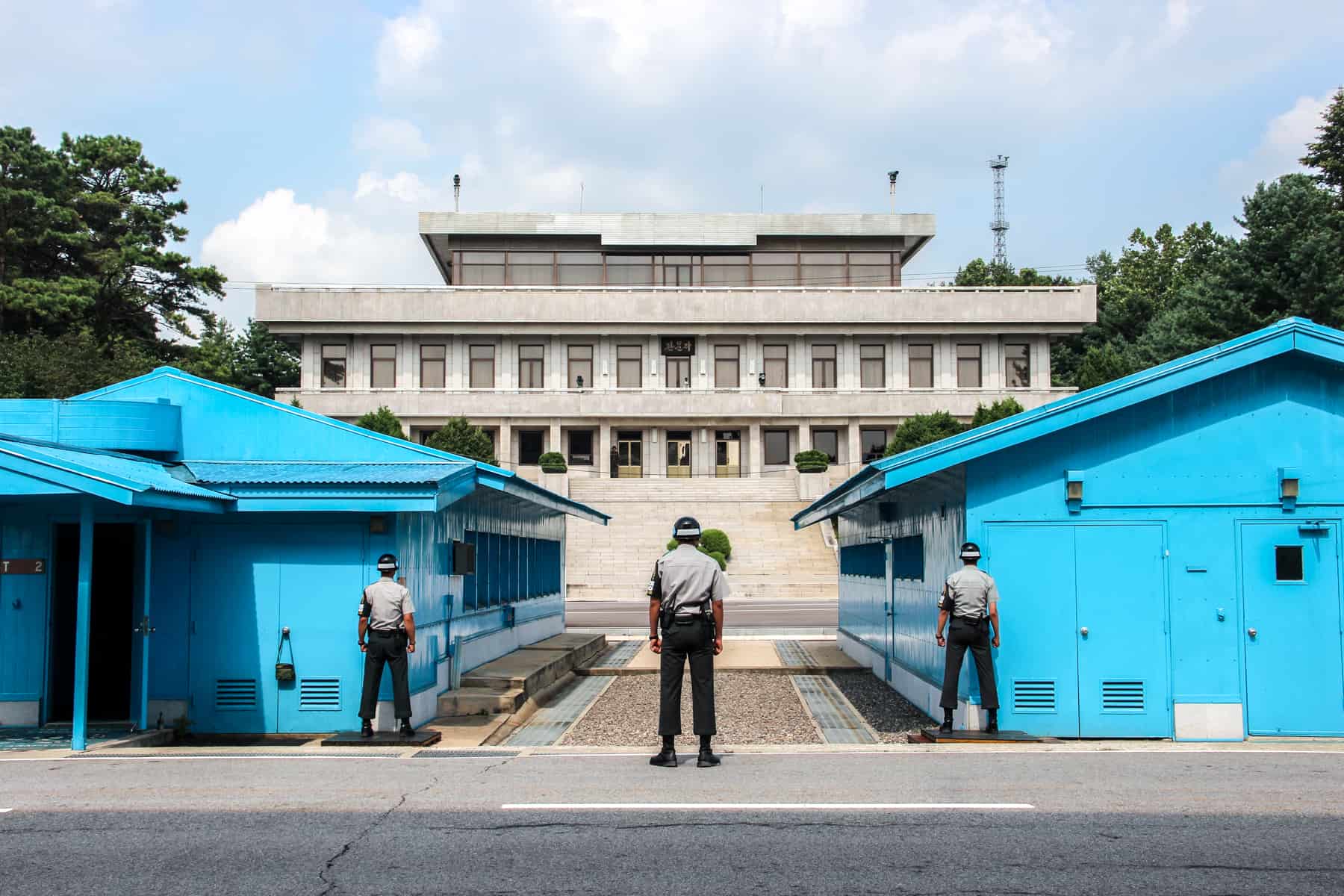
South Korean Guards at the DMZ facing the North Korean side
Visiting the DMZ from North Korea was filled with adrenalin and a little fear. Not only were we in the world’s most closed country, but we were also on the world’s most dangerous border between two countries still technically at war.
To say we were on our guard here, despite being in the safety of a group, is an understatement. It took us around three hours to reach Panmunjom from the Capital of Pyongyang, where we all waited at a busy check-in area (complete with souvenir shops) as we watched our North Korean guides have their passports swiped firmly out of their hands.
It was time to get on the coach and drive the short way to the JSA, driving through a long road lined with large square boulders that would fall and block the road should any sign of attack be imminent (the same tactic exists on the South Korean side).
It felt tense, yet we were calmed upon arrival by the opportunity to look through historical artefacts, documents, and historical boards in a building designated as a North Korea museum – propaganda and all. It was, in fact, where the Korean Armistice Agreement was signed.
Our North Korean military guide was an approachable man, and not half as scary as I imagined him to be. He spoke the North Korean version of events, yet it wasn’t as propaganda heavy as other situations we had found ourselves in. It felt far more serious here, being so close to the ‘opposition’.
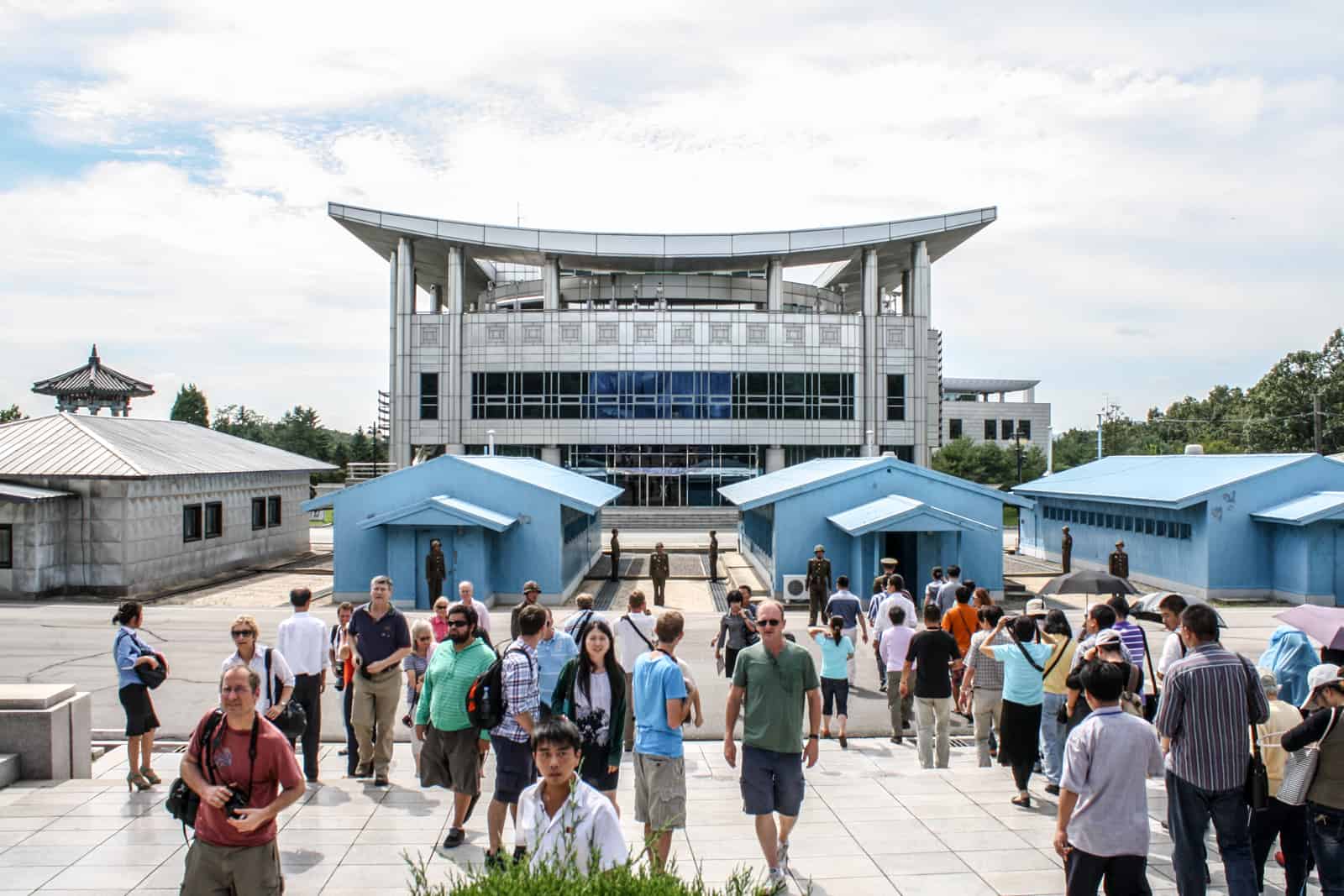
A DMZ JSA tour from North Korea.
Taking us through to the viewing platform, through an imposing, beige building, we all stood on the steps of the building looking out over to the building on the South Korean side. It was surprisingly calm, yet it felt incredibly eerie. No South Korean soldiers were present, just North Korean soldiers keeping guard.
There wasn’t the grand face-off we hear about in the media. I guess this is toned down during visits, with designated times given to both sides for tourist arrivals.
Only when we are gone, do they stand literally face-to-face with one another.
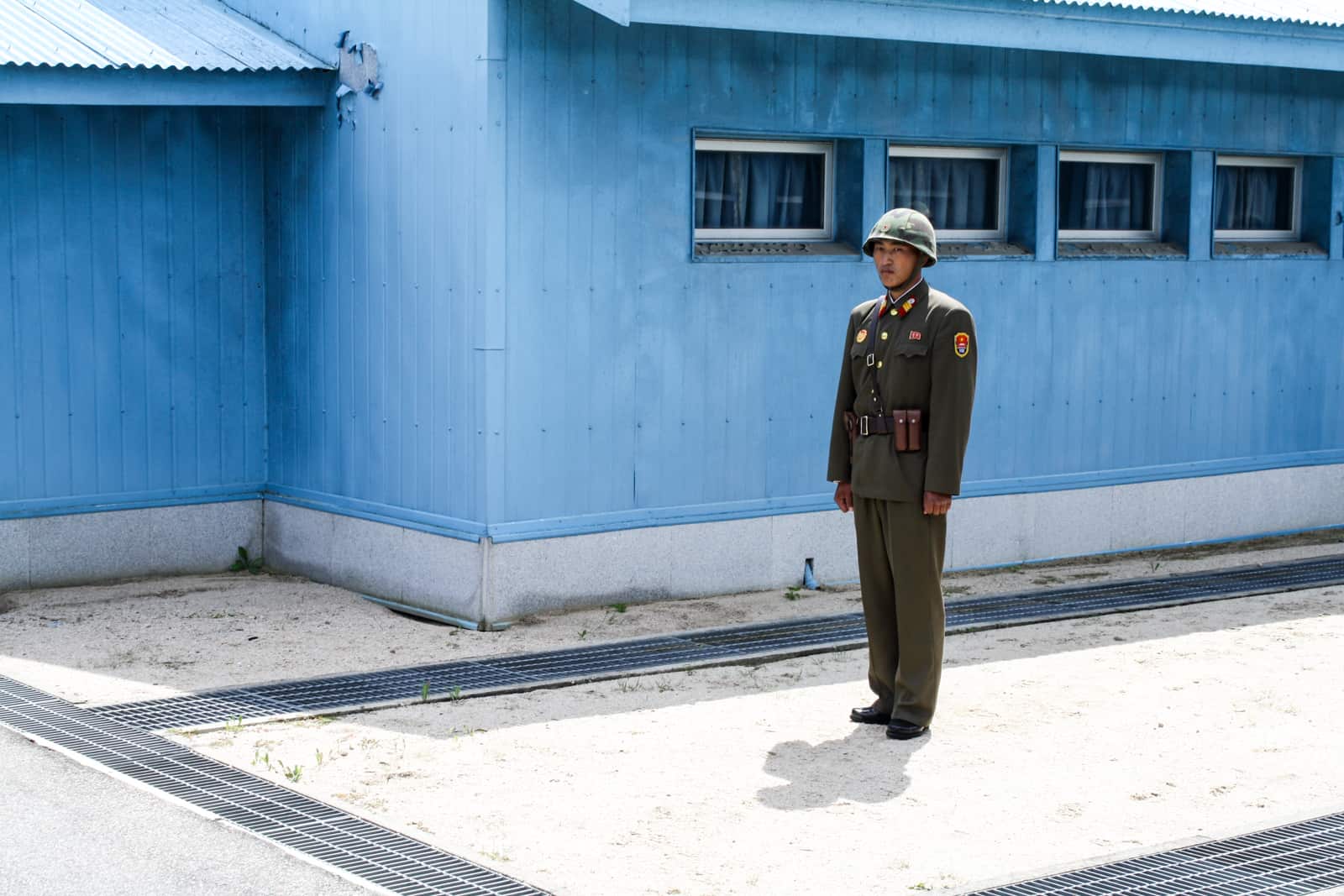
After 10 minutes or so, we were then taken into the blue hut – the Military Armistice Commission Conference Room that straddles the Demarcation Line. We were allowed to sit at the table (the ‘line’ cutting through the middle of the table) and, watched over by our guide, we all sat on either side of the table shaking hands across it, marking the peace we all wish for.
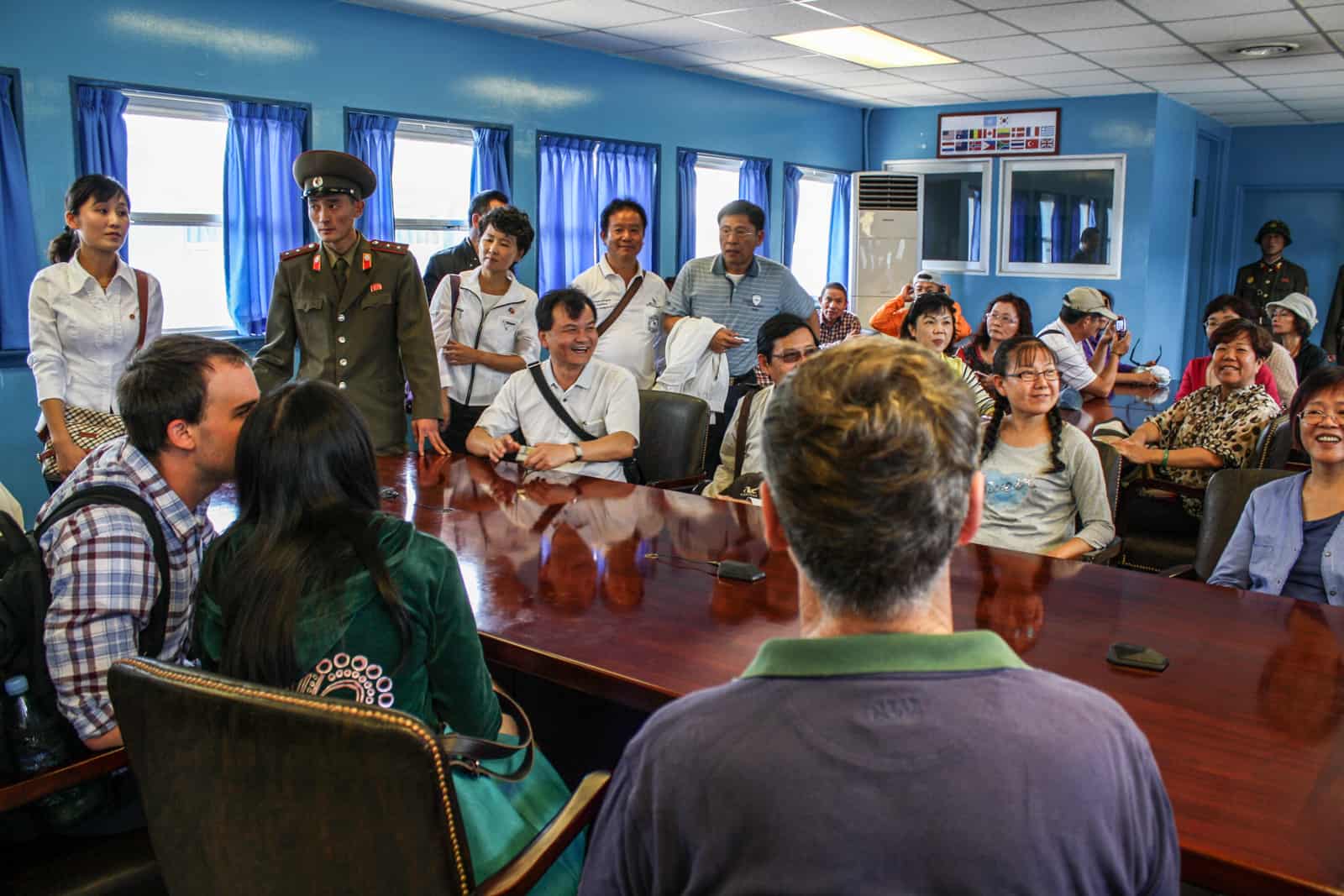
Visiting the DMZ Military Armistice Commission Conference Room
One North Korean guard stood staunchly guarding the door that leads to the South Korean side of the JSA, his fierce and set expression creating an atmosphere in the room that signalled this as very serious business. It was a day none of us could forget.
READ MORE: Travel to North Korea – Where Preconceptions and Reality Collide
In South Korea, DMZ tourism is a big business. Here, you can choose from a multitude of DMZ tours from Seoul, from full-day visits, JSA only tours to hikes and tours with North Korean defectors.
I decided on a full-day tour in order to see a series of historical sites and relics that can help formulate a better picture of the division between North and South Korea and setbacks to reunification.
The sites you see on this tour include:
The ‘Friendship Bridge’, a train station that links both countries via a single line, but whose full service is obviously not in use. However, some tours do allow you the opportunity to take a short journey on part of it, on the DMZ Peace Train from Imjingak to Dorosan Station, which you also visit.
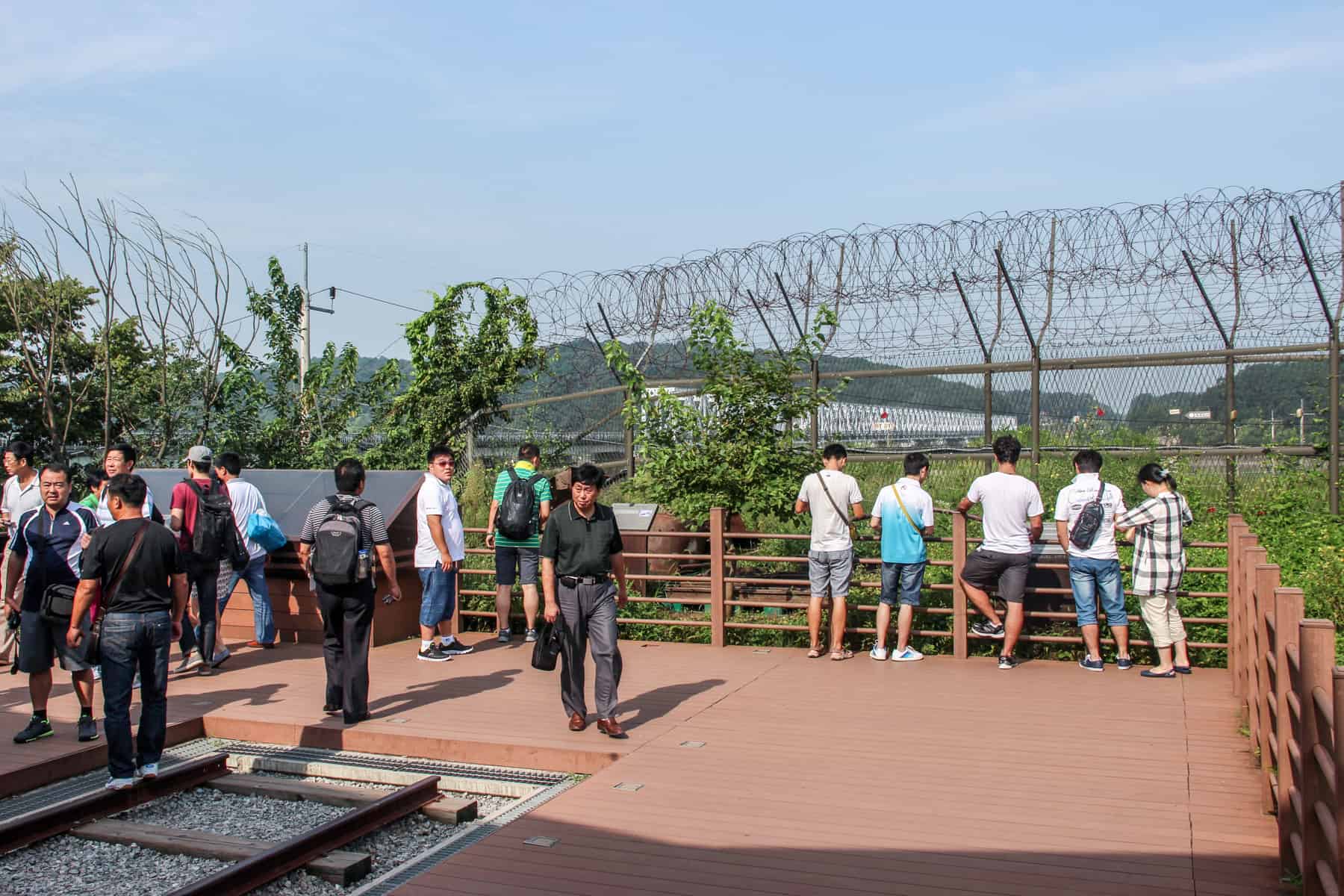
View to the Friendship bridge from unused sections of the railway line intended to connect South and North Korea.
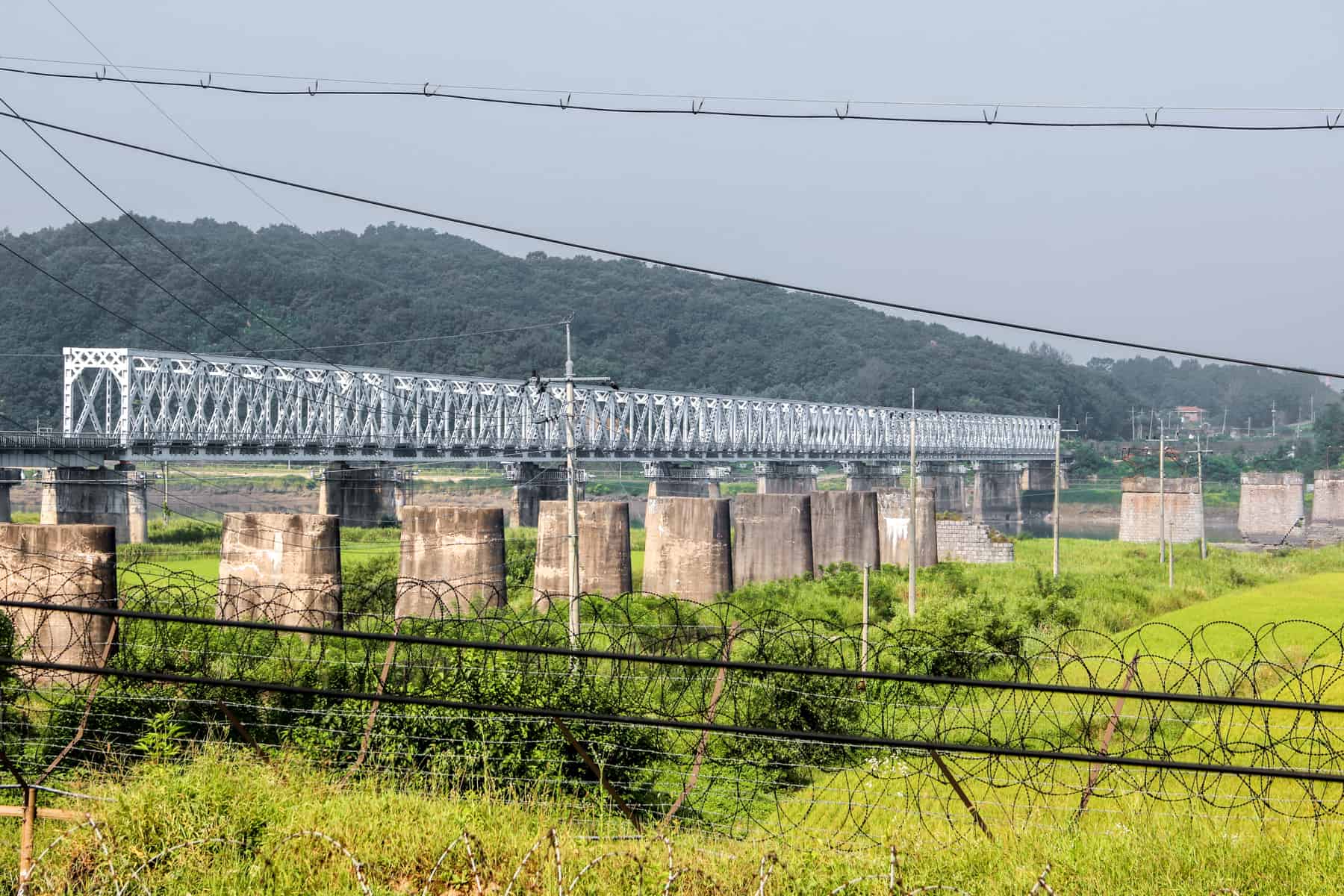
The Friendship Bridge – part of a railway intended to link both countries via a single line.
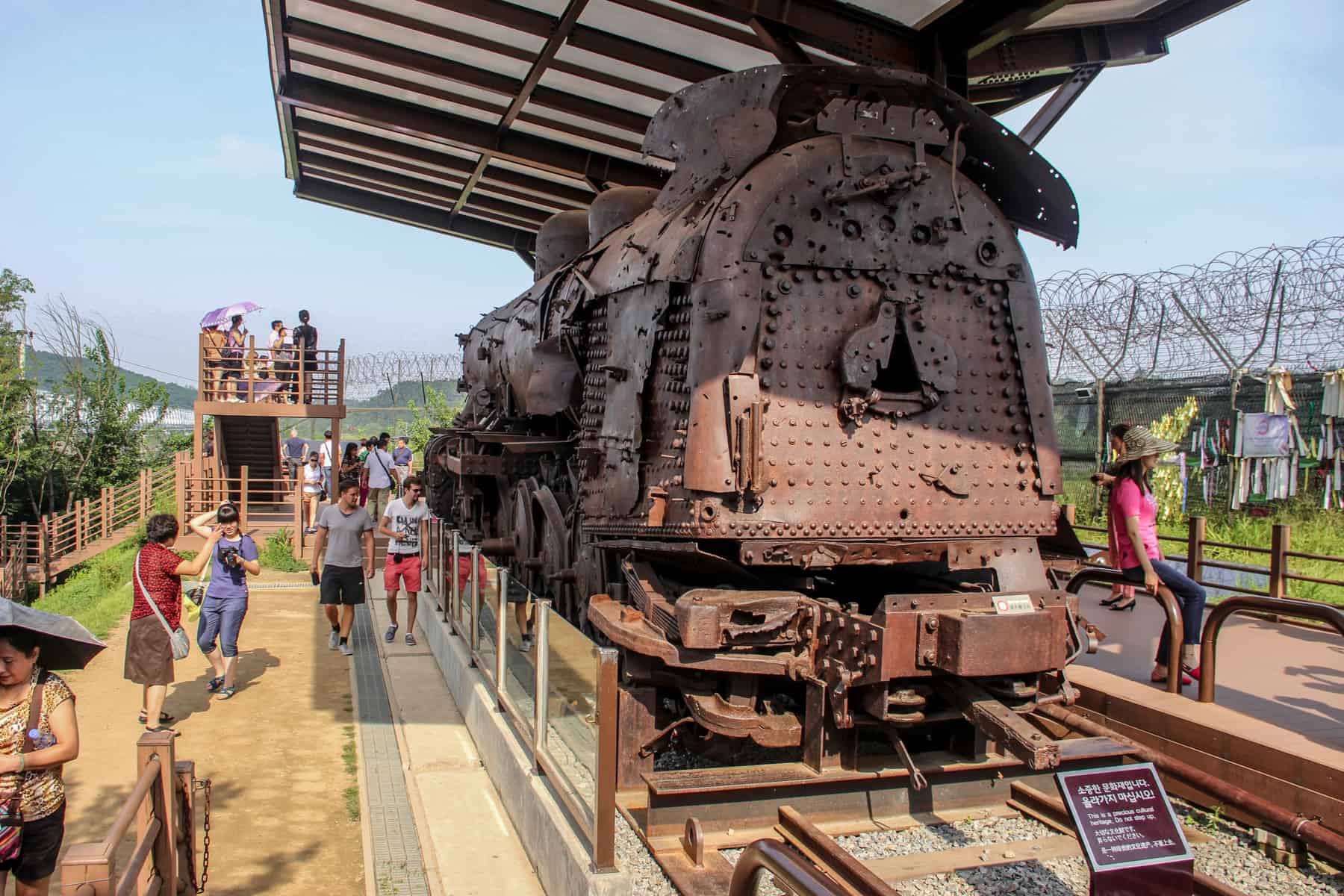
The metal relic of an old steam locomotive, derailed by bombs during the Korean War.
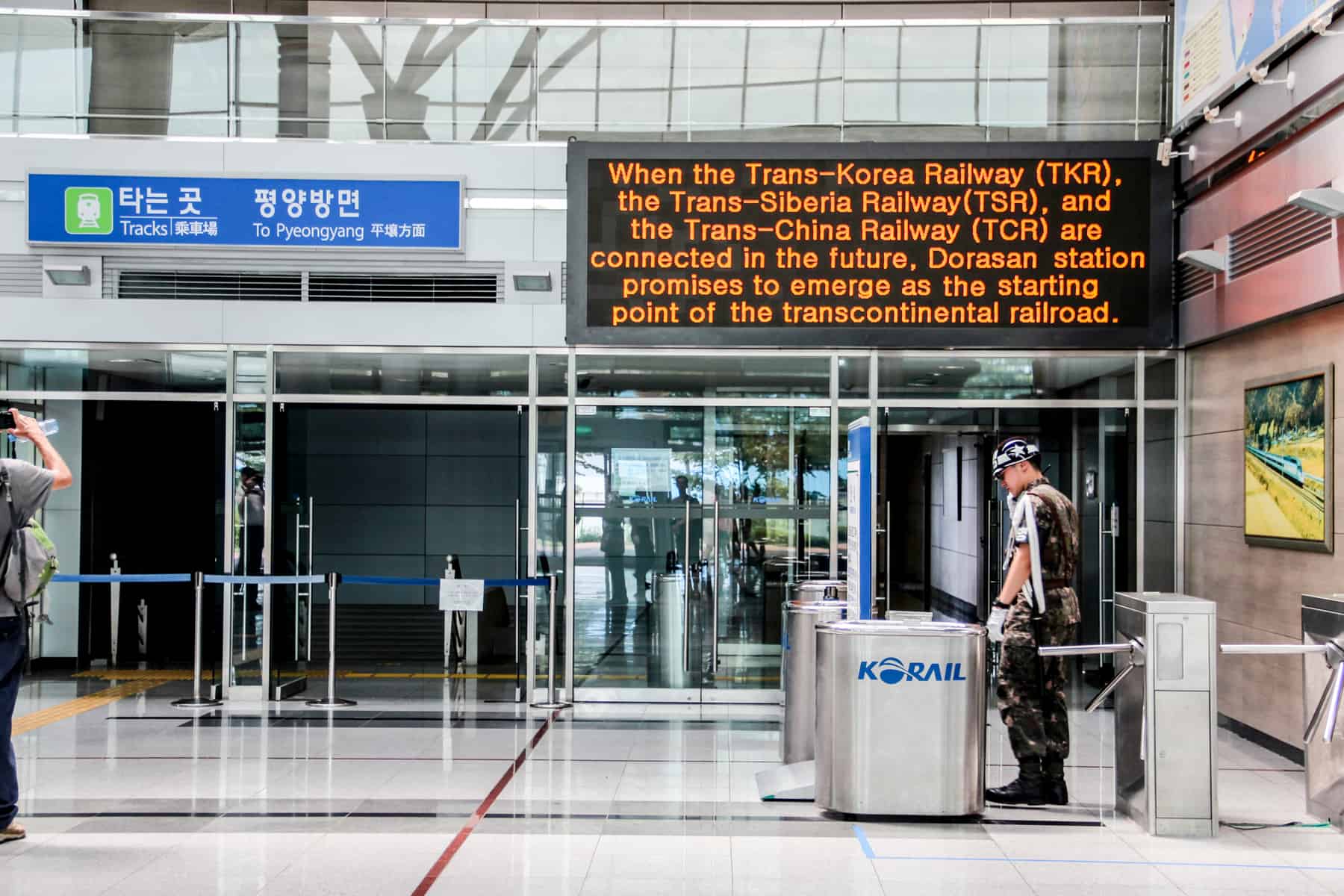
Inside Dorasan Train Station – part of the ‘Peace Train’ intended to connect to Pyeongyang, the capital of North Korea.
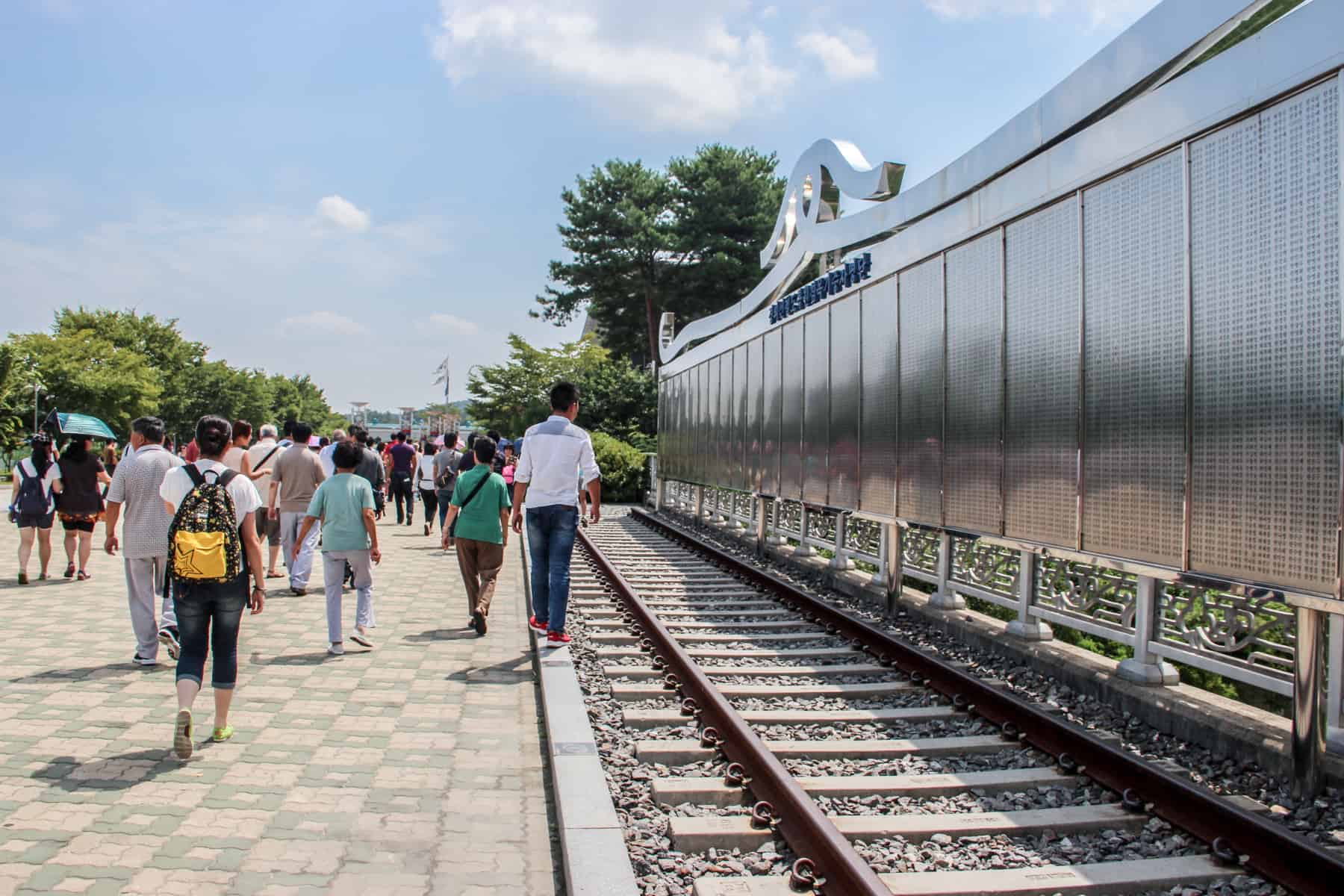
Dorasan Train Station Memorial.
The Dora Observatory where you can look out over North Korea. The most prominent lookout point is to the North Korean ‘Propaganda Village’.
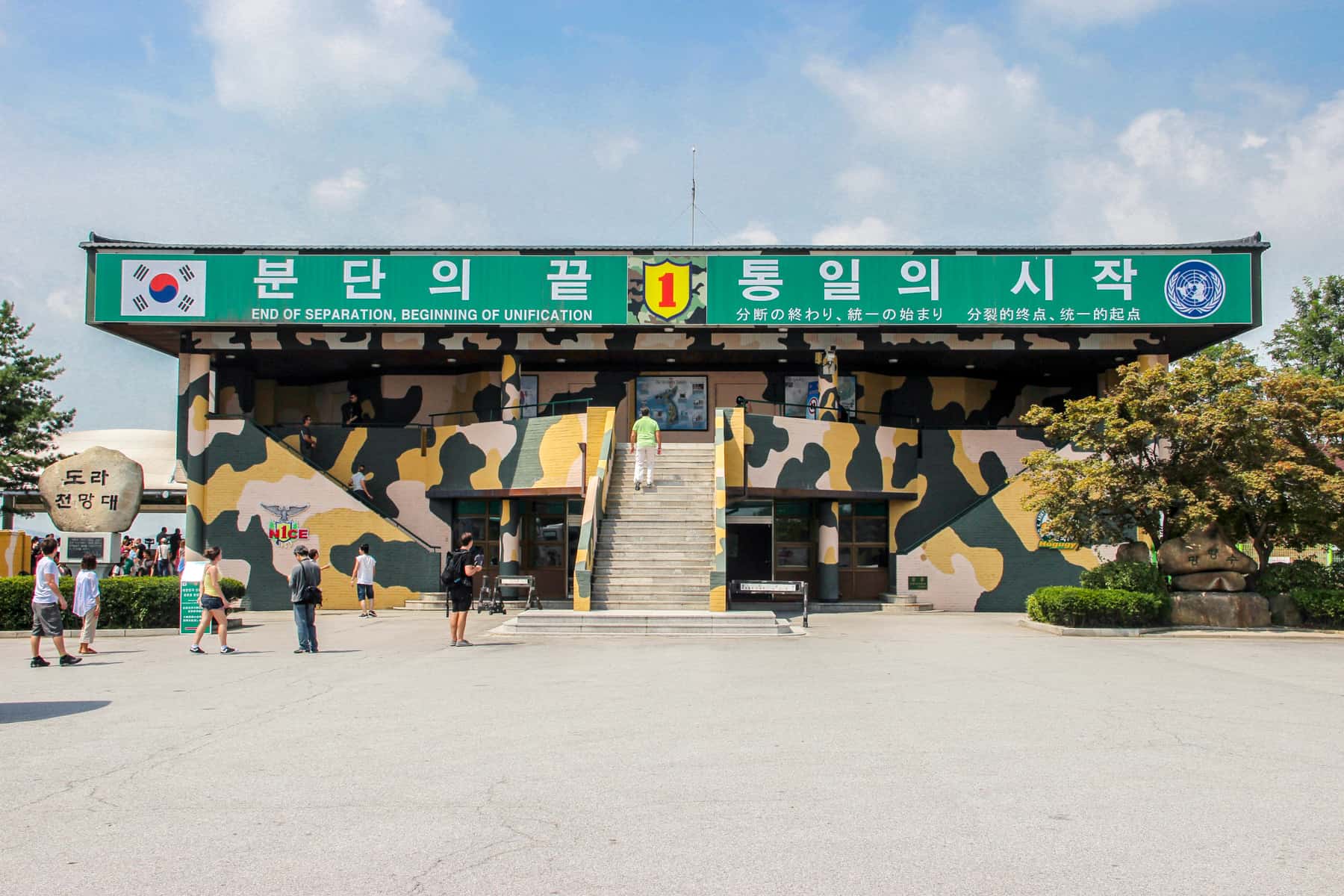
The Dora Observatory at the DMZ – the main lookout point facing North Korea.
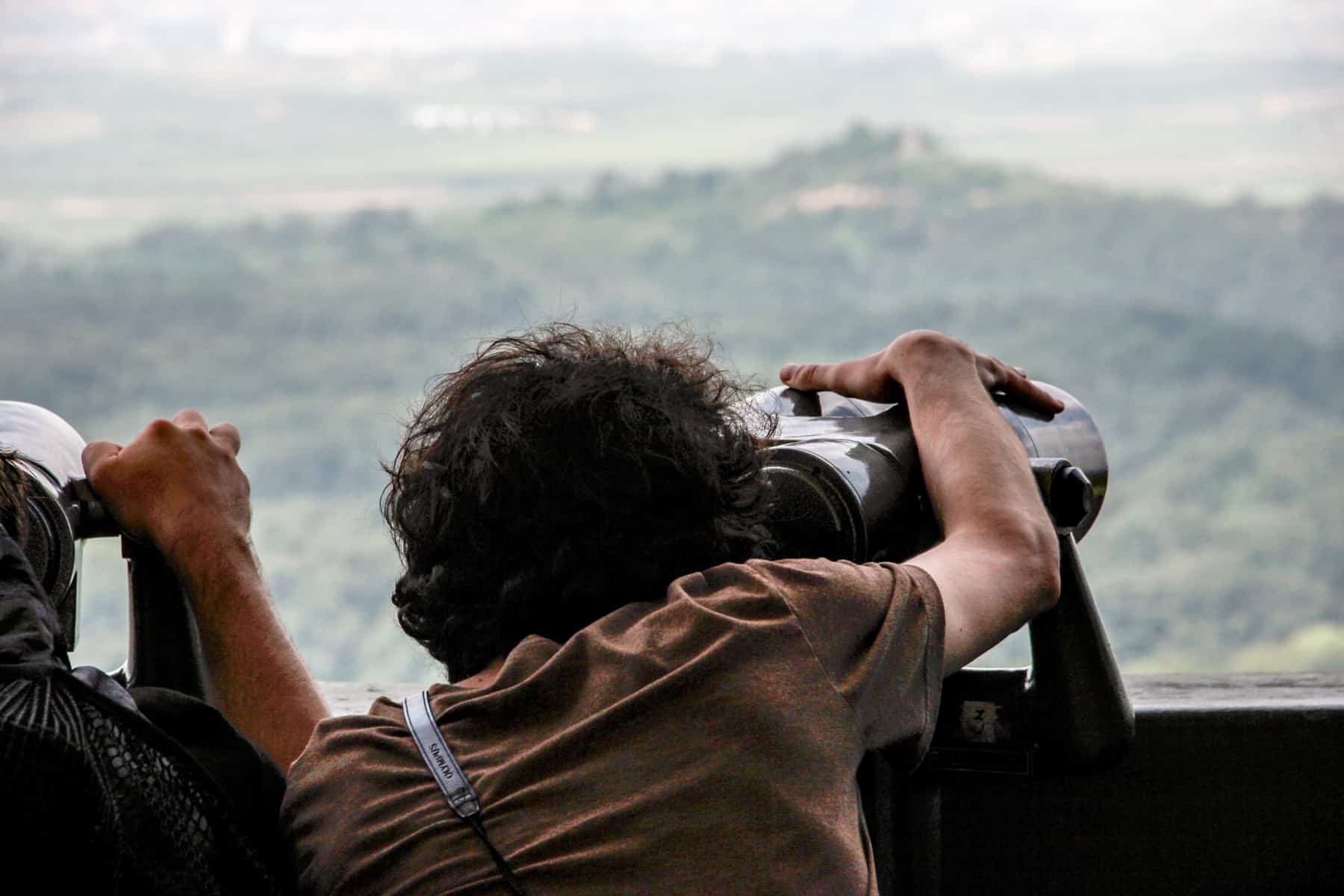
Binocular views to North Korea.
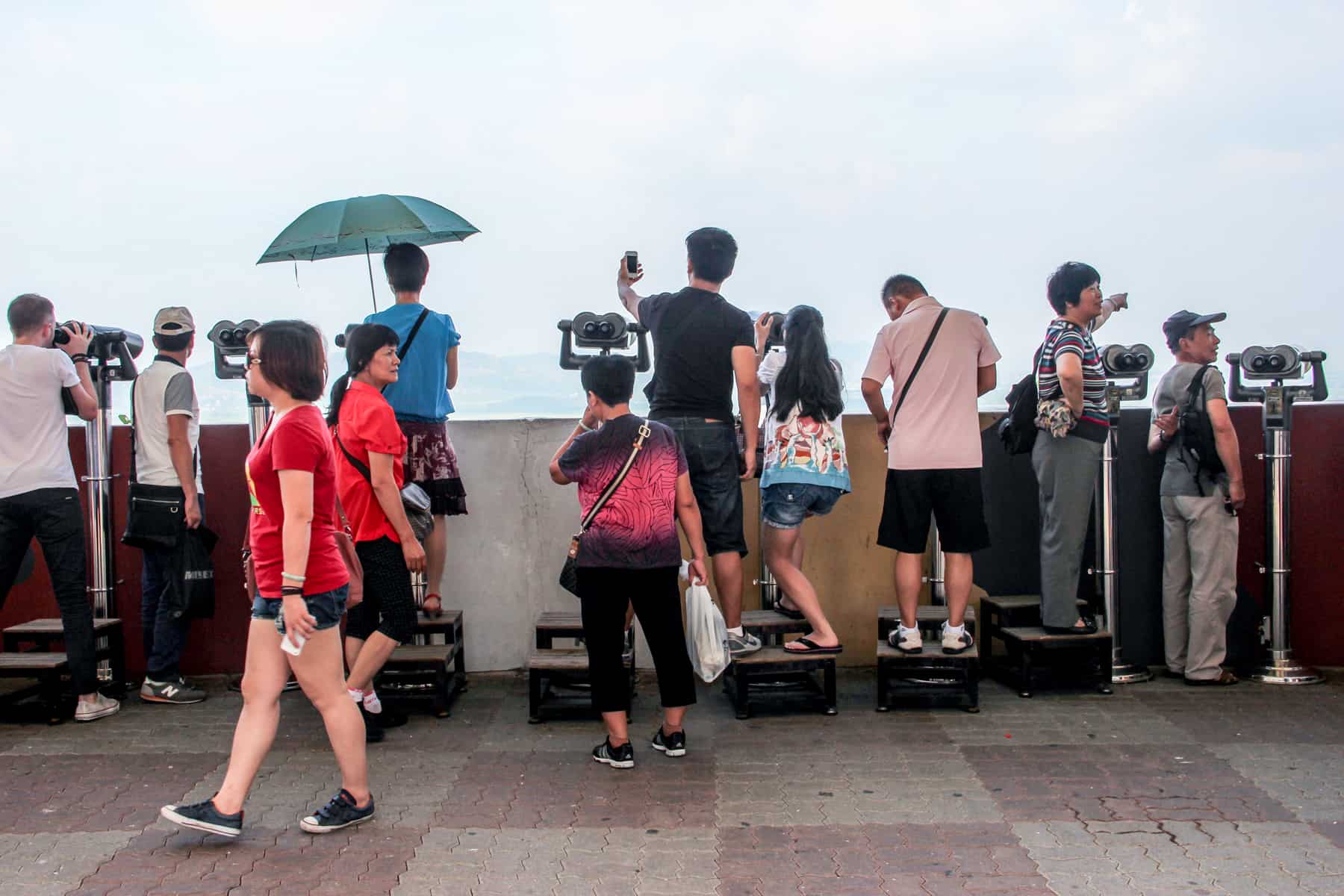
The Dora Observatory where visitors eagerly gaze into North Korea’s Propaganda Village.
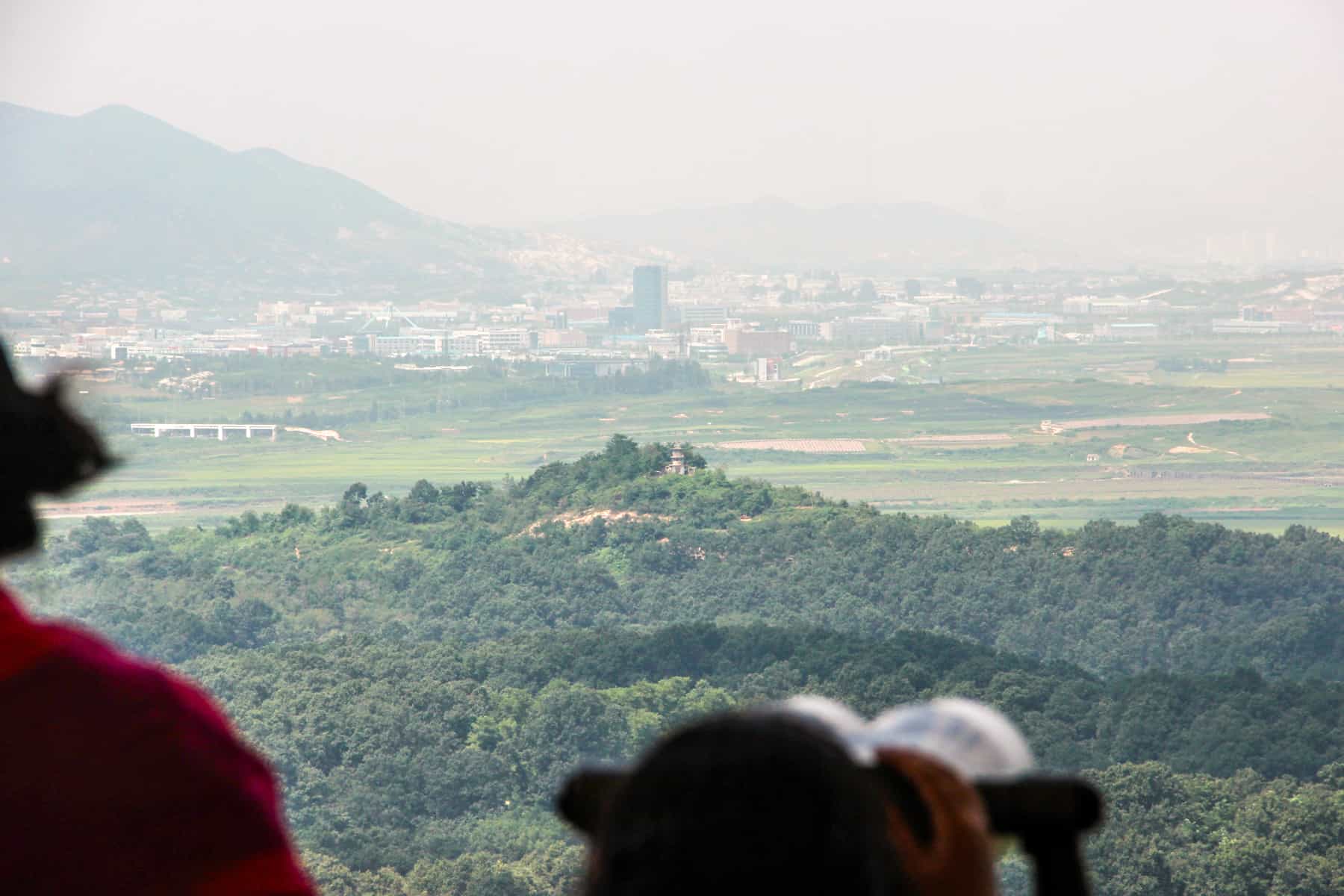
The North Korea Propaganda Village as seen on a DMZ tour.
The 3 rd Tunnel (Third Infiltration Tunnel) – a 1,632m tunnel dug by the North Koreans, from which they could pass through into Seoul within an hour and invade, alongside tourism documentation and video centres.
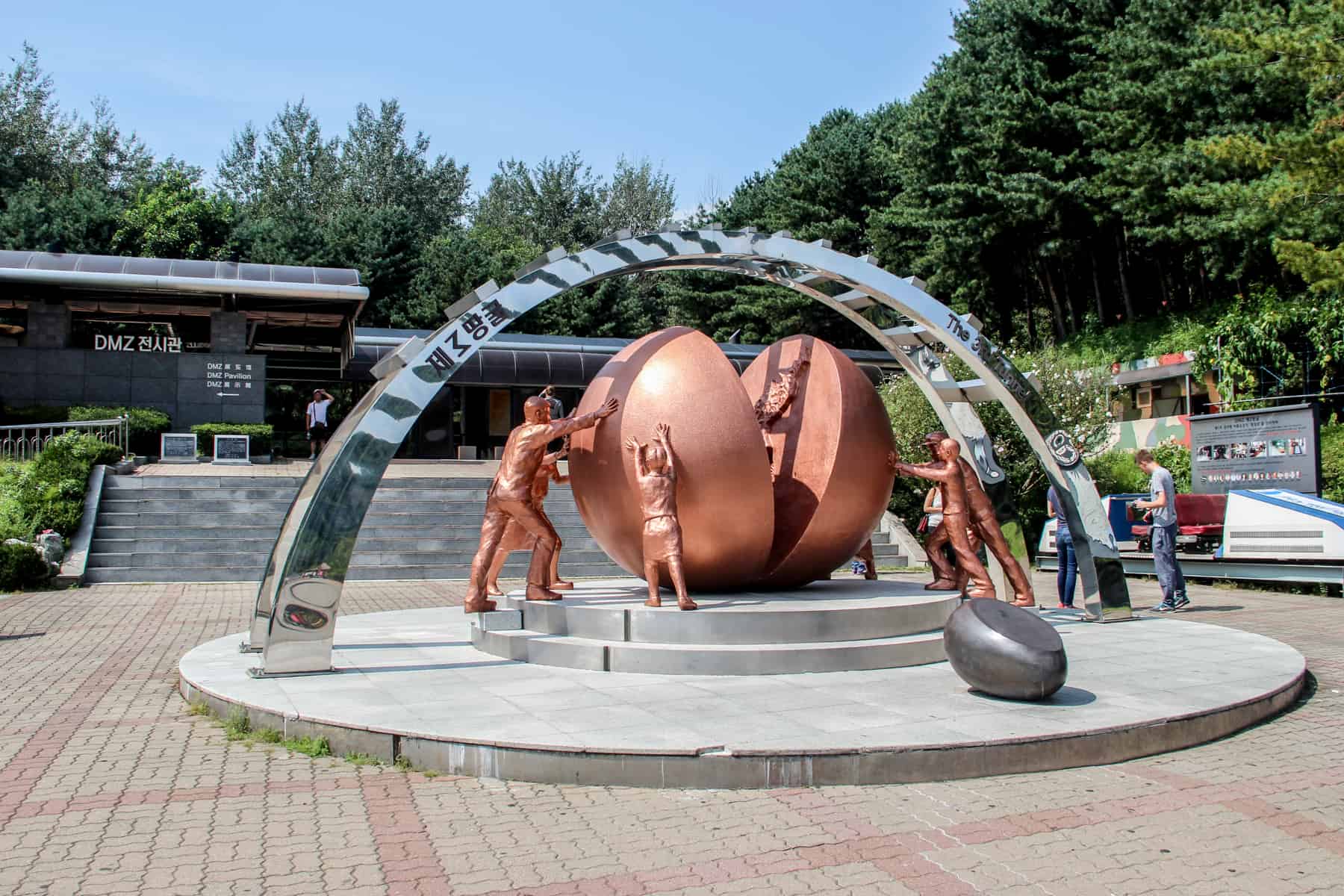
The artwork depicting reunification, marking the entrance site of the Third Infiltration Tunnel at the DMZ.
The last stop of the DMZ tour is the main site – the Joint Security Area (JSA) at Panmunjom. Here, you are shown a video and given a short introduction about South Korea’s version of events and how the US military operates here, before visiting the Military Armistice Commission Conference Room (one if the blue buildings). You are not allowed to sit down or touch anything in the Conference Room, contrary to the more relaxed visit when entering from the North Korean side.
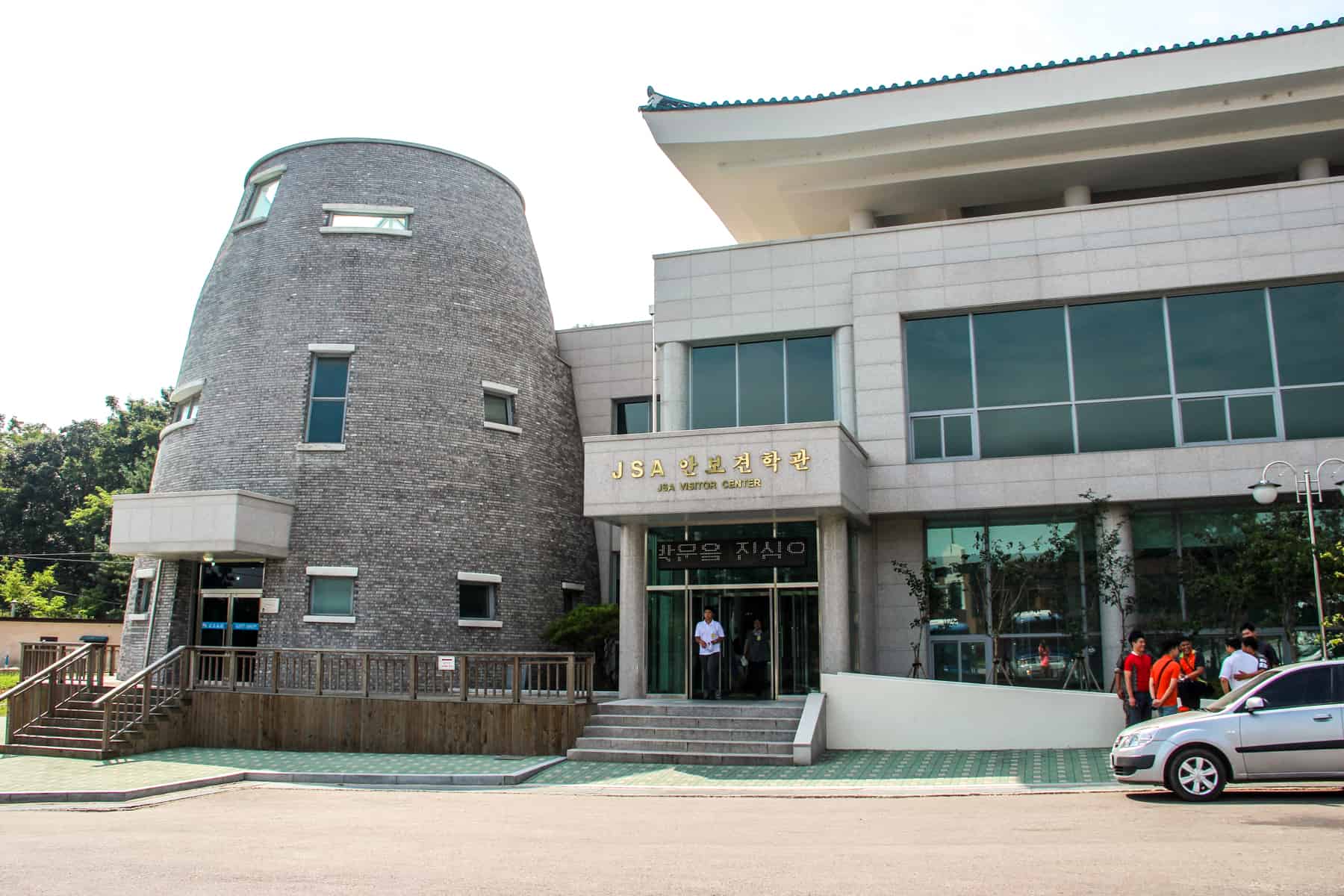
The most significant site when you tour the DMZ, is the Joint Security Area (JSA) Visitor Centre.
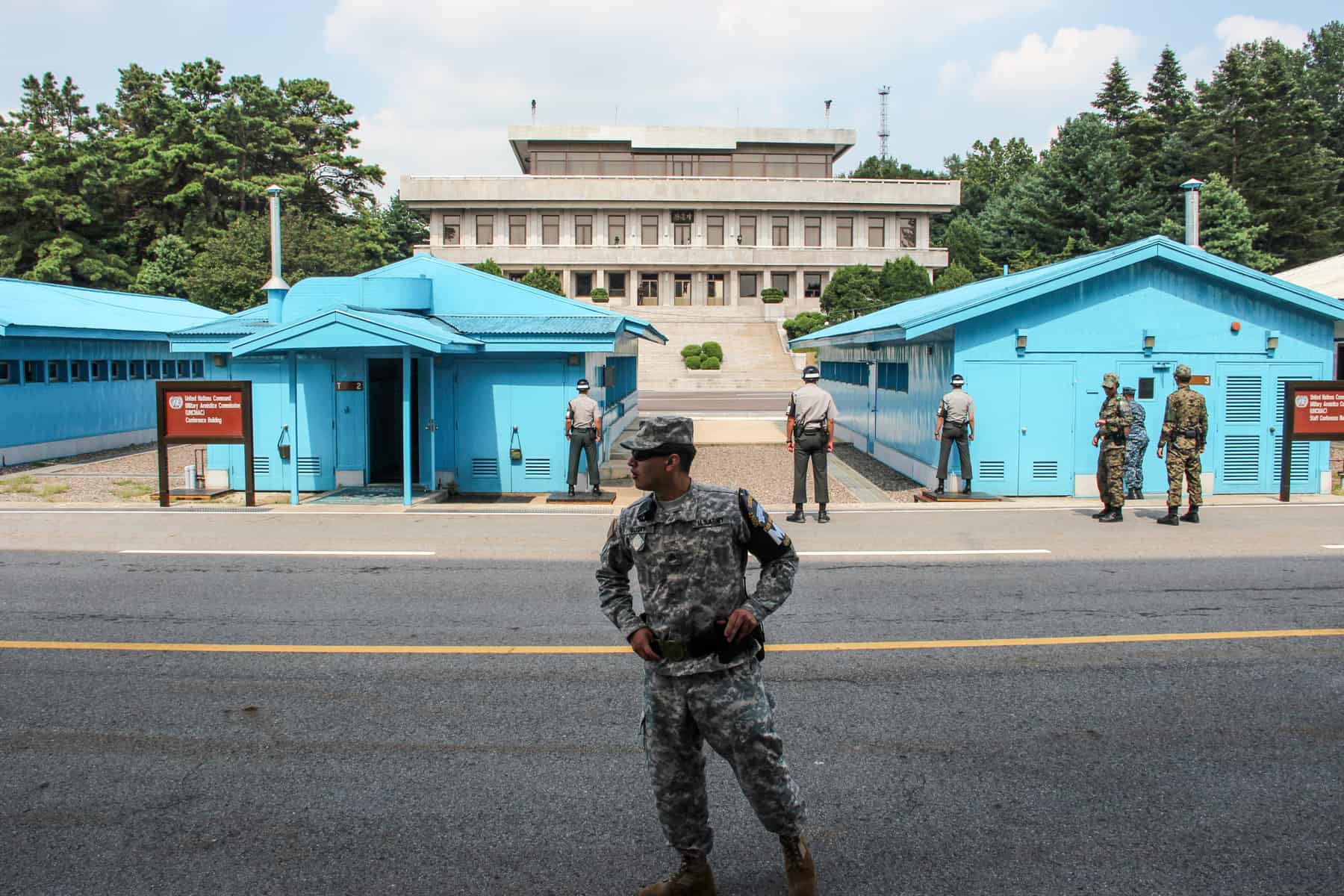
American military guides you throughout the JSA tour, seen here before entering the Conference Room.
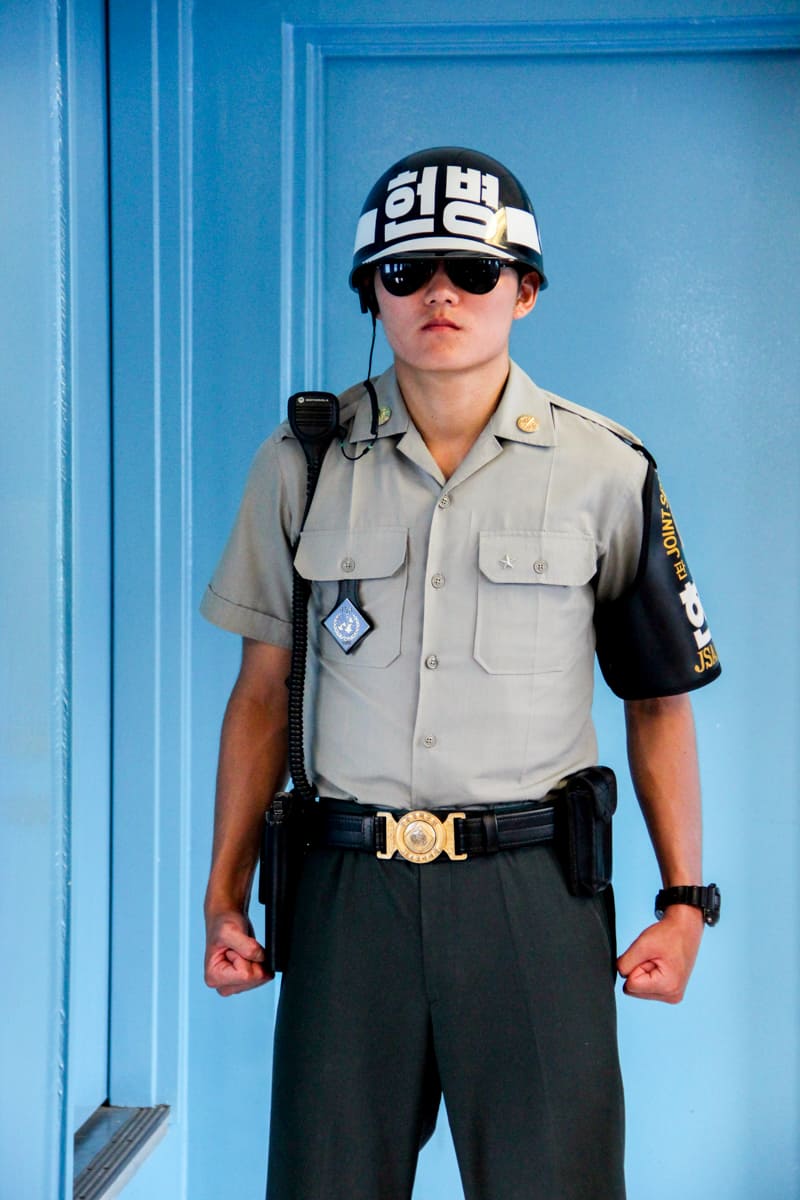
A South Korean guard in Taekwondo stance inside the Military Armistice Commission Conference Room.
As a tourist site, there are a few aspects of the DMZ tours that conflict with the seriousness of the situation.
For many of the tourists at the DMZ, I don’t think they really understood exactly where they were. At times, it felt like a day trip to Disneyland. This is at no fault of the tour company, which facilitates your transport between each of the sites and provides knowledgeable background and historical insights on the coach along the way, but the fault of who is behind the tourism surrounding this particular area. It could be the government, or whoever thought it was acceptable to build a fairground next to the area where the bridge is. Or those who thought it was acceptable to allow the Observation Deck to turn into a zoo-like atmosphere, surrounded by the screams of people looking through telescopes exclaiming, “Oh.My.God. I just saw an actual North Korean.” Yes, this really happened.
Never once did I feel the DMZ visit in South Korea was a serious issue or treated as a serious place. The US soldier, our guide, was young, knowledgeable and delivered a fantastic presentation that was factual and historically sound. Yet, for the most part, it’s treated as a bit of fun peering into the hermit kingdom. While people on the ground cannot change the ignorance and stupidity of some of the tourists who visit, there could be more educational markers put in place and the enforcement of more rules to encourage a little respect.
I felt that ‘reunification’ was nothing more than a throwaway term , later confounded by many South Koreans I met who said: “Many of us are not bothered by it”.
North Korean guards were present; they lurked in the shadows and behind the pillars of the beige building I had once stood at months before. We were informed of some rules to follow – we were not to take pictures of any North Korean guards that may appear in the building in the background, and not to make any faces or hand gestures that they can film and use as propaganda, or as a means of retaliation. Whilst I felt safe, the viewing point time felt unnerving, especially being around US soldiers who had a frivolous, laddish, macho attitude, and were themselves making gestures.
Time in the JSA conference room is more strict. Back in the blue building (the Military Armistice Commission Conference Room), we were once again told about the DMZ and the guard line, except we were not allowed to sit at the table, only stand around it. South Korean guards stood in their fierce Taekwondo stance – something of which they are famous for – yet tourists giggled and replicated the pose for photos.
That was something we would never have dreamt of doing on the North Korean side.
READ MORE: Travelling in South Korea – A Guide (But Glad I Gave it a Chance)
A visit to the DMZ is without a doubt an eye-opener and a must-see for those interested in history and current affairs. While a visit to North Korea is undoubtedly going to be fuelled by a more serious attitude, where you have to be guarded and ‘on your best behaviour’ at all times, I sadly think people miss the point when visiting on the South Korean side. A few people around me expressed disappointment with the way things were handled.
It’s a given that the majority of visitors will visit from South Korea, and so I would personally cut out the full-day tour and just stick with the specific JSA tour, yet be prepared for mixed signals regarding the seriousness of the current situation. However, for those with a deep interest in what is going on here, you will certainly take a lot more from the full-day visit of multiple sites.
As one South Korean woman said to me: “People have lost the meaning of what the DMZ is and what it’s there for. Like it’s a fun thing to do.” So when you visit the DMZ be sure to remember exactly what it stands for, why it exists and the people who have died protecting the border or trying to escape from it.
Book a DMZ Tour
I visited the DMZ on the North Korean side during my trip to the country with Koryo Tours. The JSA tour formed one afternoon as part of a seven-day trip to the country.
In South Korea, my visit to the DMZ was a day tour with VIP Travel, considered to be the best DMZ/JSR tour agency in Seoul.
The full-day ‘DMZ and Panmunjeom Tour’ (from 8 am until 5 pm) runs every day (except on Sundays, Mondays, National Holidays, and Military Training Days) and costs 135,000 Korean Won / around $120 US per person. You can read a full overview of the trip here.
The sites you see on this tour are: Imjingak Park → The Bridge of Freedom → The 3rd Infiltration Tunnel → DMZ Theater & Exhibition Hall → Dora Observatory → Dorasan Station → Pass by Unification Village → ID Check Point → Camp Bonifas → JSA (Freedom House, Conference Room)
Bookings need to be made at least 48 hours before the chosen day of the tour.
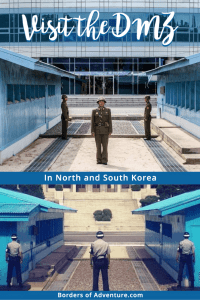
About Becki
Becki Enright is a British Travel Press Award-winning writer whose work focuses on changing perceptions about misunderstood aspects of destinations. Her writing combines storytelling with insight into the social, historical, political and economic factors that shape the country or place in relation to tourism. Becki has appeared live on Sky News and CNN and has contributed to high profile media including National Geographic, Time.com, Guardian online, New York Times, Grazia and Buzzfeed.
Arthur Hernandez says
16 March 2019 at 6:00 am
December 1967 thru January 1968. I was assigned as an Army medic to an infantry company with the 2nd Infantry Division that made patrols along the DMZ. We lived in tents in the JSA area. I remember that there was a chopper pad, a small hut that served as a PX where we bought Playboy, candy, writing stationery, tooth paste and other small items that were part of our infantry lives. Along the DMZ on our patrols there was not much of a fence and sometimes you would see holes that had been cut so that a person(s) could make their way through. We found a tunnel and the Captain lined up five infantry guys shoulder to shoulder with full packs to get an idea of how many troops could pass through. I remember Freedom Village, Freedom Bridge and the Imjin River. Most of all, I remember the grunts, the Infantry guys. I do not remember so much their names but their faces when it was bitter cold and it snowed or it rained sheets of rain and they did guard duty in foxholes manning the 50 caliber machine gun. During this time period, the Pueblo ship was seized and North Korean infiltrators came across to kill the South Korean President. On one of our patrols, we captured two of them and killed one of them who was about to throw a grenade. Second Infantry Division-Second to None! I salute the grunts who called me Doc and took care of me. I still remember.
- Article Archives
- Work with me
- Privacy Policy


IMAGES
VIDEO
COMMENTS
The Korean DMZ Peace Train is a tourist train that leaves Seoul and goes to the DMZ. KORAIL runs this train route. There are three routes that the train takes: the Dorasan Security Tour, the Yeoncheon Dreaming Tour, and the Cheorwon Security Tour. Each tour package is a one-day tour that goes both ways.
This 6-7 hour tour option is available through multiple tour operators, so you will see multiple booking options for each OTA. This tour includes pick-up and drop-off from three locations in Seoul, a short visit to Imjingak Park, and the military-run DMZ tour. Some tours include a meetup with a North Korean defector.
How to visit the Korean Demilitarized Zone
To the left corner (not pictured) is a barricade to the bridge. The Freedom Bridge connects North and South Korea, though a massive barricade blocks entry to the connecting point over the river. If the two sides are ever connected, this bridge could be used to enter and exit North Korea. Step 2. Select a tour.
7 Places. Since 1953, a no man's land has cleaved the Korean Peninsula in two. The 160-mile-long, 2.5-mile-wide demilitarized zone separates North and South Korea, creating a buffer between the ...
About the DMZ in Korea. The DMZ was created as part of the truce which was agreed upon after the Korean War following three years of combat and approximately 3 million casualties. The truce date is now commemorated annually on 27 July as Armistice Day. The DMZ is a 4km / 2.5 mi wide corridor which provides a buffer zone between the two countries.
A Complete Guide For How To Visit The DMZ From Seoul
Visiting the DMZ (Korean Demilitarized Zone) - South ...
The DMZ Tour is a tour of the Demilitarized Zone that separated North and South Korea after the Korean War in 1953. The DMZ is a four-kilometer-wide strip of land that runs across the Korean Peninsula. It is located about 60 kilometers north of Seoul, South Korea. The DMZ Tour is a great way to learn about Korean history and the current ...
Tour Highlights: Duration: 9 hours. Departure: 65-6 Chungmuro 2 (i)-ga, Jung-gu, Seoul. Departure Time: 7:00 AM. Includes: Licensed professional guide, roundtrip transfer from Seoul, admission fees to DMZ, monotrail tour in 3rd tunnel or walking tour for shared tour option.
Why tourists are drawn to the DMZ between the two Koreas
Taking A Korea DMZ Tour From Seoul - What To Expect ...
The DMZ has become a significant tourist attraction, offering a glimpse into the history and current state of affairs between North and South Korea. It houses various landmarks, such as the Third Tunnel of Aggression, the Dora Observatory, and the Imjingak Park, each carrying its own story and historical context.
Stretching over 200 kilometres long, the Demilitarized Zone or DMZ in Korea, is a historic site that deserves a spot in your itinerary. The no-man's land separating North Korea from the South not only serves as a de facto international border but also houses major tourist attractions like the Dora Observatory, the Third Tunnel of Aggression, and Imjingak Park.
Korea was no exception here. For us, it was a no-brainer to visit the DMZ - the demilitarized zone between North and South Korea. The DMZ tour is great for everybody interested in history. Additionally, for most of us, this is as close as we'll ever get to North Korea. DMZ Tour from Seoul, South Korea - Our Review. Our DMZ Tour Review
Taking a DMZ Tour South Korea. Seoul DMZ tour. The South Korean DMZ extends across a length of around 150 miles (240 km). It acts as a buffer zone between North and South Korea to keep the peace between the two nations. It is generally perfectly safe to visit, although you cannot travel to the border independently.
DMZ stands for Demilitarized Zone. Established in 1953 at the cease-fire of the Korean War, the DMZ Korea represents the area 2 km north and south of the Military Demarcation Line. In the DMZ, access is limited to keep visitors safe and sound. And because it's uninhabited by people, this area preserves valuable ecology and historical ...
This area, known as the Korean demilitarized zone, or DMZ, is a no-man's land about 30 miles north of Seoul. It was created as a buffer in 1953 when the countries agreed to a cease-fire to pause the Korean War. The DMZ splits the Korean Peninsula in half, separating communist North Korea from capitalist South Korea.
Safely tour the Korean demilitarized zone (DMZ), on this tour from Seoul; View a North Korean border town through telescopes, at the Dora Observatory; Get a great value with DMZ entry fees, Seoul travel, and guide included; Convenient pickup from your Central Seoul hotel is included in the tour; See itinerary
In South Korea, my visit to the DMZ was a day tour with VIP Travel, considered to be the best DMZ/JSR tour agency in Seoul. The full-day 'DMZ and Panmunjeom Tour' (from 8 am until 5 pm) runs every day (except on Sundays, Mondays, National Holidays, and Military Training Days) and costs 135,000 Korean Won / around $120 US per person.
The Korean DMZ was established in 1953 as part of the armistice agreement that ended the Korean War. Stretching across the Korean Peninsula, it runs 160 miles long and 2.5 miles wide. ... Checkout these other Korea travel guides! Best Time to Visit Korea (Seasons, holidays, and festivals) Gwangjang Market, Seoul - What to eat, when to go, and more;
This stress-free tour allows you to visit the DMZ and travel between key sites of interest with ease, as you gain insight into Korean War history with a guide. Plus, convenient hotel pickup means you won't waste time trying to find a start point. ... Korea DMZ the 3rd tunnel Guided Tour from Seoul - No Shopping. 1,214. Historical Tours. from ...
North Korea: what are the DMZ and JSA and ... - Reuters
2. Tourist map of St. Petersburg suburbs (high resolution JPG) 3. Tourist map of Leningrad region (high resolution PDF) 4. Map of the St. Petersburg Metro (high resolution JPG) 1. Tourist map of St. Petersburg center (high resolution JPG) The official tourist map of the city has been prepared by the tourist company "Saint Petersburg at Your ...
Rome2Rio also offers online bookings for selected operators, making reservations easy and straightforward. The cheapest way to get from South Korea to Saint Petersburg costs only $556, and the quickest way takes just 15¾ hours. Find the travel option that best suits you.